Displaying items by tag: W M Nixon
Tall Ships & Sail Training – Ireland's Atlantic Youth Trust Will Give It A Different Spin
#tallships – Rugged sailing in romantic tall ships; the camaraderie of the sea; character development. It's an inspiring combination which has gripped maritime nations for more than a century as sail has given way to more utilitarian sources of power. First there was steam. Then steam in turn was superseded by diesel and even nuclear power. And with each stage, there has been a remorseless drive towards reducing manning levels.
So what on earth is there now to occupy people who, in a former era, might have found a meaningful role in life as crew on board a sailing ship? For with each new development in shipping, we realise ever more clearly that large sailing ships were one of the most labour-intensive objects ever created.
However, we don't need to look to the sea to find areas of human activity where technological development has made human input redundant, and large sectors of the population largely purposeless. It's the general social malaise of our time. So for many years, the majority of maritime countries have found some sort of solution by an artificial return to the labour-intensive demands of sailing ships.
But in an increasingly complex world with ever more sources of distraction and entertainment, does the established model of sail training still work as well as it once did? W M Nixon meets a man who thinks we need a new vision for best using the sea and sailing ships to meet the needs of modern society's complex demands.
Tall Ships and Sail Training........They're evocative terms for most of us. Yet the buzzwords of one generation can surprisingly quickly become the uncool cliches of the next. That said, "Tall Ships" has stood the test of time. It's arguably sacred, with a special inviolable place in the maritime psyche.
So when we see a plump little motor-sailer bustling past with some scraps of cloth set to present an image of harnessing the wind's timeless power, we may be moved to an ironic quoting of Robert Bridges: "Whither, O splendid ship......" But somehow, citing Masefield's "a tall ship and a star to steer her by" would seem to be beyond the bounds of even the worst possible taste.
There's a simple purity about "Tall Ships". It works at every level. Google it, and you'll find the academics claim that it became official with its use by John Masefield in 1902 and Joseph Conrad in 1903, though Henry David Thoreau used it much earlier in 1849. But Conrad being the benchmark of most things maritime in academia, 1903 seems to be set in stone.

We all know what is meant by a true Tall Ship, but as these rig profiles indicate, the proliferation of sail training programmes has led to an all-inclusive approach
Yet at the vernacular level, it has been there much longer than any of them. There's a bit of maritime meteorological lore which our academics would probably dismiss as vulgar doggerel, but I've found it still moves me. When far at sea, with the underlying swell increasingly in evidence and the weather conditions which it describes clearly developing overhead, inevitably you'd remember this little couplet:
"Mackerel sky and mare's tails,
Make Tall Ships carry low sails".
It's not Yeats. But when you're on a formerly blue sea now turning grey and far from anywhere in a 25-footer, it's a little thought which can still make the hairs stand up on the back of your neck. And it's that mention of "Tall Ships" which gives it the added resonance. So things stand well with the phrase "Tall Ships". But what's the word on the continuing viability of "Sail Training"?
"I'm fed up with the constant use of the term "Sail Training". It's bandied about so much it has become meaningless. And always talking about "Sail Training" limits the scope of what we're trying to do. If we could find some useful phrase to replace "Sail Training", but something which is also more visionary than the very pedestrian "Youth Development" which is sometimes replacing it, then maybe we could go a long way to capture the imagination both of our potential supporters, and of the young people we hope will want to come aboard the ship".
The speaker is Neil O'Hagan, busy Executive Director of the Atlantic Youth Trust, which is actively developing ways and means of building a 40 metre sailing ship which will serve all Ireland in a wide variety of functions. And as he has immersed himself in this challenging project when he is clearly a very able person who could name his price in many roles in high-paying large corporations, it behoves us to pay attention.
We have been skirting the AYT and its project several times here recently. But as we gradually emerge from the recession and see what is still standing, for some reason with every passing week we find it ever more disturbing that the Irish Sail Training Brigantine 84ft Asgard II was lost nearly seven years ago by foundering, and the Northern Ireland Ocean Youth Trust's 60ft ketch Lord Rank was lost after striking a rock five years ago.
Far from being swept under the carpet, it's a double whammy which has to be faced and dealt with as 2015 rolls on with the biggest Tall Ships assembly ever seen in Ireland coming to Belfast, and not an Irish Tall Ship worthy of the name to represent us.

The popular image of Tall Ships is a crowded port with a fun-filled crowd...............
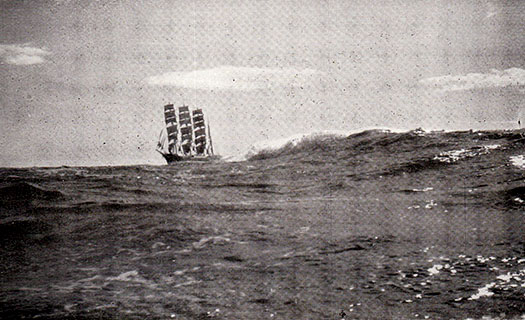
.....yet for many old salts, the true image is the lone ship at sea, going about her business. This photo of a four-masted barque was taken from a small cruising boat in the 1930s
But an ideas-laden shooting of the breeze with O'Hagan soon shows that we're going to have to learn to think a long way out of the box before we begin to meet the demanding expectations of this man and his board of trustees and directors, and the much-anticipated presence of the Tall Ships in Belfast is only a trigger to help activate a much more complex vision. Neil O'Hagan hopes not only to be instrumental in the creation of a new Irish sailing ship, but he also hopes to change the way in which we perceive such a vessel, and our expectations of the way she will be used.
In our initial blog on this back on January 17th, we thought we were making a tellingly adverse point in suggesting that the barquentine Spirit of New Zealand - which the AYT reckons will provide the best model for the development of their project – is not so much a sail training tall ship as we know it, but rather, with her large complement of 40 "trainees", she's more of a floating schoolship which happens to set sails.
Far from being blown out of the water by this "damning" criticism which I and others had voiced, O'Hagan was delighted that we'd lit upon this aspect of the plan. "Old-fashioned sail training has had its day" he says. "When education authorities and social service bodies and welfare funds and philanthropic organisations are looking for some way to provide interesting, satisfying and ultimately long-term-beneficial experiences for young people of all backgrounds and varying states of mental health including the very happily normal, they expect a much broader curriculum than is provided by the traditional sail training model".
"And come to that, so do the young people themselves. If sailing is genuinely their great leisure interest, they'll be into it already at a personal level among like-minded friends. But if they're more typical young people of today, they'll have a wide range of interests, and during the ten day cruises which we hope to make the backbone of the new ship's programme, the sailing will only be part of it."
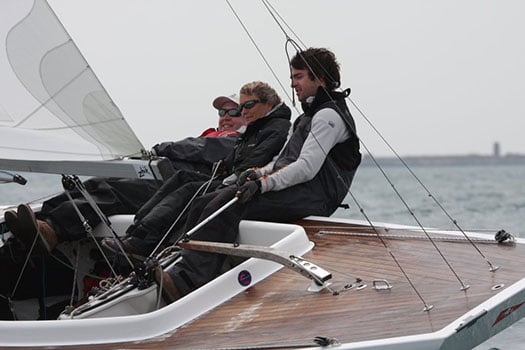
Away from the day job - Neil O'Hagan helming a Dragon
Its not that O'Hagan is anti-sailing. Far from it – he has been seen in the thick of things in the midst of the International Dragon Class in recent years. But a good liberal education with time in the Smurfit Business School in UCD and extensive family links all along Ireland's eastern seaboard north and south, plus direct business experience in both Dublin and Belfast, give him a breadth of vision to provide the AYT with a real sense of purpose.
The Atlantic Youth Trust has been quietly building itself since it emerged from a representative workshop researching the building of a sailing ship for Ireland, held in Dublin Port in the Spring of 2011. From that, a Steering Group of Lord Glentoran and Dr Gerald O'Hare from the north, and Enda O'Coineen and David Beattie from the south – all of whom had worked together before on other north-south youth sailing projects – was set up, and they commissioned a professional consultancy group – CHL Consulting of Dun Laoghaire – to work with them in producing a Vision & Business Plan, which eventually ran to 96 detailed pages.
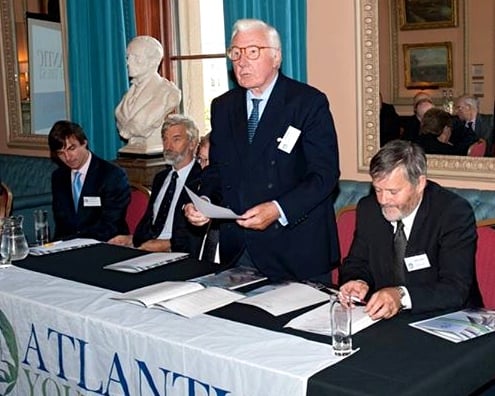
The Chairman Lord Glentoran (Gold Medallist at the 1965 Winter Olympics) at the AGM of the Atlantic Youth Trust with Executive Director Neil O'Hagan (left), Sean Lemass and Director Enda O'Coineen (right)
In due course, the Atlantic Youth Trust emerged with Olympic Gold Medal veteran Lord Glentoran as Chairman. And with Neil O'Hagan as Executive Director, the show was on the road with the detailed worldwide investigation of 25 successful educational schemes involving sailing ships - note we've dropped that "sail training" tag already. And in New Zealand they found something that was really new, something that fell in with their view that the double loss of the Asgard II and the Lord Rank provided an opportunity for a truly fresh look what a national sailing ship might be and do.
It's an extraordinary place, New Zealand - particularly from a maritime point of view. Far from seeing their isolation as a drawback, they use it as an advantage for fresh thinking. And they don't cling to time-hallowed ways brought over from "the old country". On the contrary, being in a new country is seen almost as an imperative for trying new ways and ideas, hence they're at the sharp end of top events like the America's Cup.
And as they were far from the fleets of established tall ships in Europe and America, with the Spirit of New Zealand they had to develop new ways of using a vessel which would spend much of her time cruising their own extensive and very varied coastline on her own, distant from the Tall Ship sailfests which are such a feature of the programme in the more compact and crowded parts of the world.

Spirit of New Zealand is barquentine-rigged
Thus by geographic necessity. New Zealand is ahead of the curve in developing ways of contemporary validity in the use of large sailing ships. We all hear of what a marvellous party the Tall Ships will activate in Belfast, just as they've done before in Dublin, Cork and Waterford. But hold hard just a moment. Isn't sail training aimed at young people mostly between the ages of 15 and 25? Surely their central involvement in vast open air quayside parties - with the inevitable underage alcohol intake possibilities – is totally at variance with the healthy idealism of the concept?
For sure, the organisers of modern Tall Ships Festivals go to enormous effort to ensure that they're genuinely family-friendly events. But the ancient traditions of sailors in port can be difficult to escape. So when you've a proposed programme which is essentially based on recruitment through continuing contact with secondary schools and similar age cohorts – as is the case with the Atlantic Youth Trust project – then it becomes increasingly desirable to have a ship which is large enough to be self-sufficient, with a viable way of onboard life built around large shared areas, such that the traditional waterfront-oriented harbour visits will no longer be such an important part of the cruise programme.

Splendid isolation. Spirit of New Zealand in an anchorage remote even by New Zealand standards
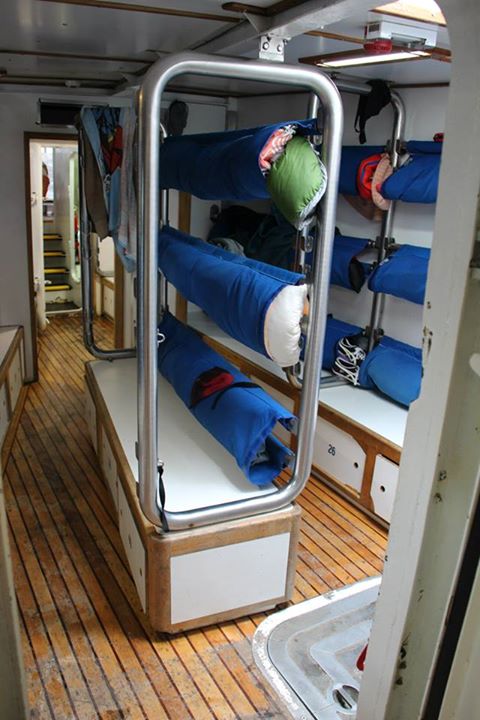
Packing them in....as she carries a crew of 40 trainees, and with space required for extensive communal areas, Spirit of New Zealand's bunks are efficiently planned
Of course the new vessel will take part in Tall Ships Races and Tall Ships Festivals, and of course she'll make the occasional ambassadorial visit, both along the Irish coast and abroad. But with the underlying philosophy of the ship being largely self-sufficient of shoreside distractions other than when they're environmentalist and educational ventures, sometimes with an expeditionary element, then the more gregarious aspects of her yearly routine will be kept well in perspective, and everyone will be the better for it.
As it's essentially a cross-border venture, equal funding from the two governments – each of which it is hoped will put up 30% of the capital expenditure - is anticipated, and with a fresh tranche of Peace Process money on the horizon, the resources are gradually building as people get used to the idea. There has also been much technical background research, and leading naval architects Dykstra of The Netherlands are on the case with an impressive scenario, for as Trustee and Director David Beattie has put it, this one isn't going to be cobbled together, it's going to be a "best in class project".
As the planned use of the vessel is essentially civilian, she will be Ireland's sailing ship without being the national sailing ship. There's more than a slight difference to the Asgard situation. In many other countries, the most impressive tall ships are part of the naval service, but in Ireland we have a Naval Service sailing vessel already, she is the ketch Creidne which was the national sail training vessel between the decommissioning of the first Asgard in 1974 and the commissioning of Asgard II in 1981. In recent years, she has had a major refit and is now actively sailed, but as Ireland's Naval Service is so essentially Cork-based, the Creidne is very much part of the scene in Cork Harbour and the Naval Base at Haulbowline.
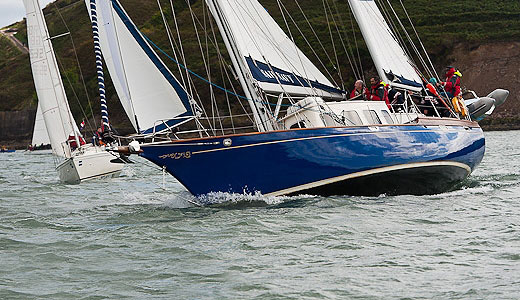
The Naval Service have Creidne for sail training purposes for their own personnel. Photo: Bob Bateman
In fact, although the Atlantic Youth Trust does have a Cork element to it, and advisers include several leading figures in the Cork marine industry, the reality is that it is first and foremost a cross-border enterprise between offices in Dublin and Belfast.
This means that Cork – which is the true capital of maritime development in Ireland, and I mean that in all seriousness – is an associate port to the Atlantic Youth Trust project, rather than a central pillar of it. But I don't think the people of Cork would wish to have it any other way. When I was in the southern capital for the fund-raiser for the new National 18 class development a month or so ago, Class President Dom Long kicked off proceedings by explaining how it was the Corkonian sense of independence which had inspired the mighty leap in National 18 design. He did this by showing a map which neatly illustrated the Cork sailor's view of Ireland.

The Cork sailor's view of Ireland
It says everything. But I don't think the Atlantic Youth Trust should lose any sleep over the fact that they might be seen as being on a Dublin-Belfast axis from which Cork is as usual going its own sweet way. 'Twas ever thus. And anyway, in the end the Corkmen will probably provide many of the officers for the proposed new vessel to which we wish, on this fine Easter Saturday morning, the very fairest of fair winds.
National 18s Take Dinghy Racing Class Onto A New Plane
#national18 – There are some special dinghy classes. There are some very special dinghy classes. And then there are the National 18s.
You can see any number of reasons why this unique class, celebrating its 80th birthday in just three years time, is in a league of its own. A three-man boat with one of the crew on a trapeze, its crewing set–up requires a level of sociability which is further emphasised ashore, where their après sailing is the stuff of legend.
At all the centres where it is sailed, and at places upon which the National 18s have descended for a championship, we know they've left behind a formidable reputation for determined but good humoured conviviality, combined with great sportsmanship.
Yet while it is easy to understand the class's popularity among its adherents when you see them in high spirits as a group, there's no getting away from the fact that in today's dinghy terms, 18ft is a lot of boat. The mood of the National 18s may often seem light-hearted. But keeping one of these boats in prime condition and well crewed is not something for the casually-interested.
It requires real commitment, yet that is something which National 18 sailors seem to have in spades. And now the class has taken on a new lease of life with the development of a fresh take on the National 18 parameters by legendary designer Phil Morrison. But rather than being launched as a commercial venture, the new boat is being developed from within class resources, which has involved several imaginative fund-raising ventures. W M Nixon found himself being drawn into one of them.
It's official, The Cork Harbour National 18 Class are brilliantly capable of running a booze-up in a distillery. And just to make it even more challenging for their supportive members and many friends, they ran this particular fund-raiser for the new Phil Morrison boat in the Jameson Distillery in Midleton in East Cork on the first Saturday night of Lent.
Of course, like all Ireland on St Patrick's Day three weeks later, they got a special dispensation for the partying to continue unhindered by thoughts of Lenten piety. There was plenty of time for that next morning. But meanwhile, right there in the heritage and high tech splendour of the Midleton facility where tradition and new science are dynamically allied, the National 18 crews went at it good-oh, and the class's Development Fund was greatly enhanced.
In fact, I'm told the financial targets were comfortably exceeded, but as Class President Dom Long and the ever-energetic Tom Dwyer didn't tell us the targets in the first place, we'll happily take their word for it. All I know is that it was one helluva night, and only the National 18s could have done it.

Let's party! Colman Garvey's vintage National 18 welcomes guests to the Midleton Distillery for yet another event in a series of fund-raisers which have supported the development of the new boat from within class resources. Photo: W M Nixon
It's a class which – thanks to being a restricted design rather than a hidebound one-design – is able to wallow happily in its history as it thrusts towards new designs which keep up the spirits of its established sharpest sailors, while also encourage the vital new blood.
So how did it all come about? Well, thanks to a prodigious book written by Brian Wolfe of the boat's history, published in 2013 to mark the class's 75th Anniversary, we get some idea of the inevitable complexity of the story. The class started in 1938 in the Thames Estuary where there'd been several local one design or restricted "large dinghy" classes around the 18ft mark and soon – under a National Class imprimatur from the Yacht Racing Association – it spread to several other centres.
Needless to say, World War II from 1939 to 1945 brought any further growth and most sailing activity to a halt, but by 1947 things were looking up again, and in the straitened post war circumstances, the National 18 found its niche. Back in 1938, Yachting World magazine had sponsored a design to the class's rules by Uffa Fox, and that became the clinker-built Uffa Ace, which continued to be the backbone of the class for many years after the war.
It was Whitstable in the far east of Kent which produced most of the initial impetus for the class, and local builders Anderson, Rigden & Perkins made a speciality of it. In fact, ARP-built Uffa Aces were soon virtually the definitive National 18. Yet ironically we cannot confirm at the moment if the oldest National 18 still sailing – Richard Stirrup's 1938-vintage Tinkerbelle which races with the classics divison at Bosham SC on Chichester Harbour – is an ARP boat.
It's ironic because Tinkerbelle's first home port was Howth. It wasn't until I was writing the history of Howth YC for its Centenary twenty years ago that awareness surfaced that there'd been the nucleus of a National 18 class in Howth in 1938.
There were just three boats – John Masser's Wendy number 14, Tinkerbelle number 15, and Fergus O'Kelly & Pat Byrne's Setanta, number 16.

Tinkerbelle (15) being sailed by Aideen Stokes in 1939, with John Masser's Nat 18 Wendy (later Colleen II) astern, and the Corbett family's Essex OD Cinders abeam.
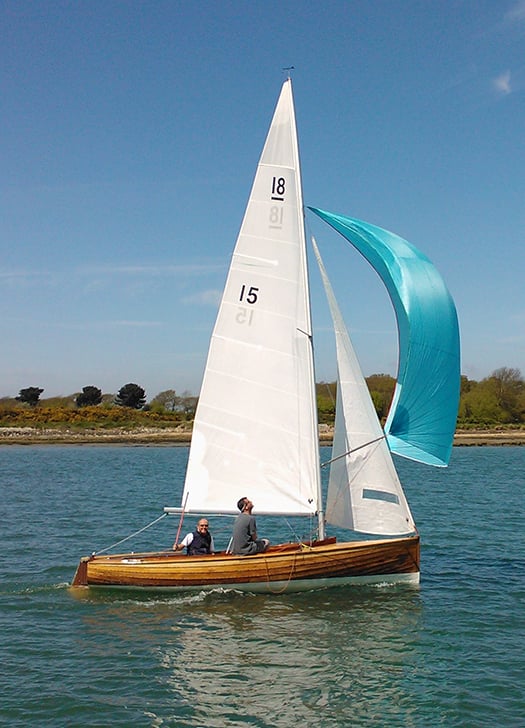
Tinkerbelle as she is today, the oldest National 18 still sailing. Her home port is Bosham on Chichester Harbour. Photo courtesy Richard Stirrup
Tinkerbelle seems to have been owned by a syndicate in which the Stokes family was much involved, though in the class history her earliest owner is listed as Bobby Mooney, son of the renowned Billy Mooney of Aideen fame. However, around Howth, Tinkerbelle was best remembered for being raced with considerable panache by a non-owner, Norman Wilkinson.
But when Norman returned from war service in 1946 determined to sail just as much as humanly possible, he found that the National 18s had faded away, and the only way he could get regular racing was by buying the 1898-built Howth 17 Leila, which he duly raced with frequent success right up to the end of his long life in 1998, by which time Leila was a hundred.
It's intriguing to think that, with one or two twists of fate in Howth, Norman Wilkinson might have been renowned as a star of the National 18s taking on the likes of class legends such as Somers Payne and Charlie Dwyer of Cork, where the class – having started with just two ARP boats in1939 - held fire for a while, but got going big time in the late 1940s and early '50s with several builders all round Cork Harbour creating them in local workshops.
That was one of the attractions of the National 18s. They were big enough to appeal to people who didn't fancy skittish little dinghies, yet they were small enough to be constructed by artisan boatbuilders who could produce lovely boats. But the owners – having laid out what were considerable sums of money at a time when Ireland seemed to be in a state of permanent economic depression – were disinclined to go the final stage of having the boats properly measured and registered with the class. This caused increasing problems, ultimately solved by a high level of diplomacy as the National 18s' popularity grew, and the opportunities arose for the Cork boats to go across the water to race in big-fleet competitions.
At one stage, class numbers were so healthy at many centres that in Britain they had Northern and Southern Championships, reflecting the primitive state of road movement of boats. Dinghy road trailers – particularly for hefty big 18-footers – were still in their infancy, so all sorts of ingenious methods were used to get boats to distant events, with a Whitstable boat on at least one occasion getting to Cork as deck cargo aboard a Coast Lines vessel on its regular route which took in Rochester in Kent and eventually Cork among several ports.

The National 18s in their classic prime, with immaculately vanished clinker-built hulls, and setting lovingly-cared-for cotton sails. Here, Crosshaven's greatest National 18 sailor Somers Payne (Melody, 206) is being pursued by Alan Wolfe in Stardust 63), while up ahead Charlie Dwyer with Mystic (208) is doing a horizon job, with the legendary Leo Flanagan of Skerries lying second at the helm of Fingal. The photo was taken during a Dinghy Week at Baltimore, and it is memories like this which inspired Brian Wolfe (son of Stardust's owner-skipper) to undertake the mammoth task of collating and writing the class's history.
In Ireland, centres which saw interest in the National 18s included Dunmore East, Clontarf and Portrush, but as Dun Laoghaire was committed to the 17ft Mermaid, the only place on the East Coast with really significant National 18s numbers was Skerries, where the incredible Leo Flanagan set the pace driving his Jensen Interceptor ashore, and racing his no-expenses-spared ARP-built National 18 Fingal afloat in somewhat erratic style.
Leo was a ferocious party animal, and when the Skerries and Crosshaven National 18s united in going to the big class championship at Barry in South Wales in the mid 1950s, Leo was very disappointed to discover that, just as the party was really getting going, the club barman had every intention of closing at closing time. The very idea....Leo solved the problem by buying the entire bar for cash on the spot.
As far as Leo was concerned, sailing was for parties, so when he heard of the highly-organised Irish Olympic campaign towards the 1960 Olympics in Rome, he got himself to Rome, as Olympic sailing promised Olympian parties. To his distress, he was ordered out of the Olympic Village by the Irish squad, who wanted no distractions. But to their distress, the bould Leo then turned up next morning for the first day's racing, officially accredited and highly visible in his new role – he had become manager of the Singapore team.
It seems that in a harbourside bar the night before, he'd met the helmsman of the Singapore Olympic Dragon (as it happened, the only Dragon in Singapore), who was racing in the Olympics as a personal venture. As the biggest rubber concessionaire in Malaya, he could well afford to do so. But this meant he was also Team Manager, and when Leo met him, the Singapore skipper was much upset, because with his sailing duties and need to get a good night's sleep before each day's racing, he was simply unable to take up all the official invitations which any Olympic Team Manager received.
He felt he was badly offending his hosts, and completely failing the Singapore sailing community So Leo, out of sheer kindness, agreed to be the Singapore Olympic Sailing Team Manager, giving selflessly of his time, energy and great wit in the front line at all the best and most fashionable parties throughout the 1960 Olympic Regatta.
All of which has little enough direct connection with the story of the National 18s, but it gives you some idea of the style of the people who have been involved in a long tale which will soon have been going on for eighty years. Yet beyond the parties and the many scrapes they got into, there was also much serious sailing and boat development going on, for although the Uffa Ace was the most numerous design in the growing fleet, anyone could have a go provided they fitted within the class rules.
But by the mid-1960s, it was clear that the traditional concept of a clinker-built National 18 was losing its appeal, and in 1968 the Class Association asked Ian Proctor to design a National 18 to be built as a smooth-hulled fibreglass series-produced boat, with bare hulls to be available for owners who wished to finish the boats themselves.
However, being mindful of keeping existing wooden boats competitive, the new boats were built much heavier than their glassfibre construction really required. Yet they looked good, and the first one Genevieve (266) was delivered to class stalwart Murray Vines, who sailed with the Tamesis Club on the Thames. There, the river may have been pretty, but it was so narrow that when the Tamesis people secured a major championship, they took their entire race management team down to the coast to attractive sea venues where the National 18s could do their thing with style and space.
That said, it was far from style and space they were reared. Murray Vines' son Jeremy – who is proud owner of the very first production version of the Phil Morrison Odyssey design which the class has been developing for the past two years – recalls his own earliest experience of championship competition with the National 18s in 1949 aged 11. He and his brother crewed for their father in 18/51 in a championship on the Medway in Kent, and they lived afloat on the boat, for in those days many National 18s lay to moorings.
Perhaps as a reward, the father built the two young Vines brothers their own International Cadet Dinghy the following winter. But Jeremy has remained loyal to the National 18 class to the point of being the pioneering owner for the new version of the design despite being at a certain age which you can work out yourself from that data given for the Medway in 1949. That said, he has given himself more space for his sailing as he has moved his base from Tamesis to Lymington, and in addition to the National 18, he cruises and races the Dufour 34 Pickle, a sister-ship of Neil Hegarty's award-winning Shelduck which featured in this column a week ago.
That the new wave of glassfibre 18s was not going to outclass the existing boats was forcefully demonstrated in 1970, when the class held its first combined all-British & Irish Championship in Cowes, after twenty years of separate Northern and Southern events. Despite the new glassfibre boats, the classics from Cork Harbour – where they'd been in the midst of celebrating the Quarter Millennium of the Royal Cork YC - were dominant, with Somers Payne right on top of his form sailing Melody (206) to win going away, notching only 1.5 points to second-placed clubmate Dougie Deane on 14.
Cork Harbour boats took the first six places in a crack fleet of thirty-one of all the best from every top National 18 centre, and the spirit of it all was best captured by the Thames Challenge Cup for a family crew going to Royal Cork's Dwyer family – Charlie and his sons Michael and a very young Tom – who placed sixth in Mystic.
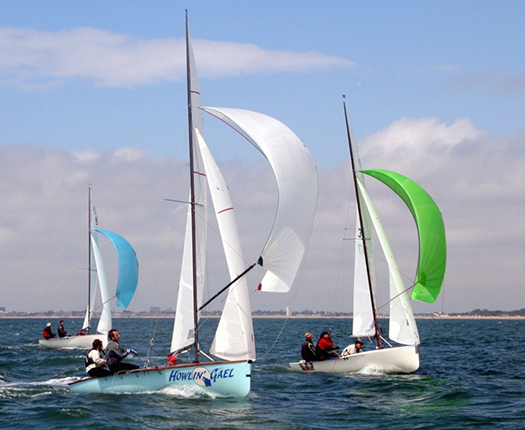
The furthest flung fleet is at Findhorn in northeast Scotland, but the huge distance involved doesn't stop Royal Findhorn YC boats competing with the rest of the class. This is top RFYC helm Stuart Urquhart's Howlin Gael racing in the Solent, and every so often the class – including those from Cork – make the long trek to Finhorn for an annual championship.
However, in terms of championship success the movement towards overall victory by glassfibre boats had begun, and 1977 saw the last championship win by a wooden boat, with Mike Kneale's Maid Mary (183) from the Port St Mary fleet in the Isle of Man. This was a hotbed of National18 racing for a couple of decades, and after Mike had completely renovated the 23-year-old formerly only so-so Maid Mary, he clinched the 1977 title at Findhorn in northeast Scotland "just before you get to Norway", as I was told in Midleton last month. There, the Royal Findhorn YC is a byword for warm hospitality ashore and hot sport afloat, but despite a strong challenge by a formidable Cork contingent, the Manxmen won out.
But having done his duty by the classic wooden boats, for 1979 Mike Kneale and his team took a different tack – they commissioned a new National 18 design from ace ideas man Jonathan Hudson, which they composite-built around Airex foam whose use other Manx DIY boat builders such as Nick Keig had been deploying for long-distance multi-hulls.

The Airex boat....Mike Kneale's innovative Woodstock on trials off Port St Mary in the Isle of Man in 1979.
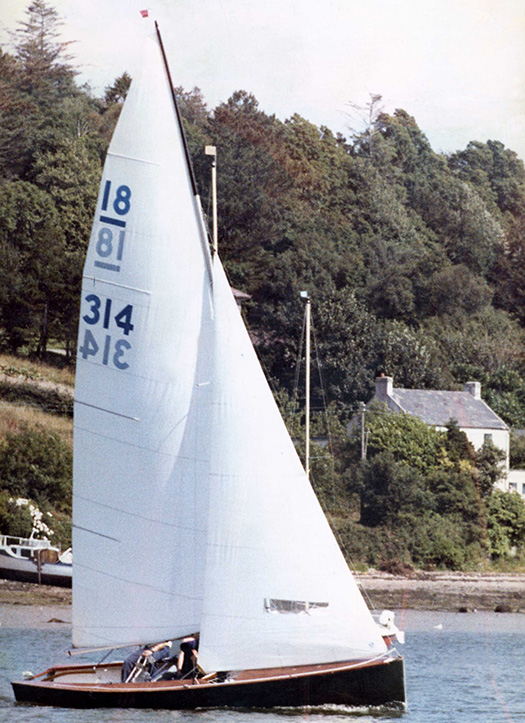
Woodstock from the Isle of Man sails back into Crosshaven in 1979 with all the look of a boat which has just won the championship.
Despite – or maybe because of – her composite materials, the new boat was called Woodstock. And as Brian Wolfe's history of the class recalls, when she appeared for the well-supported 1979 championship in Crosshaven, "there was much debate", not un-related to the fact that Mike and his crew of Rick Tomlinson and Ross Thomas swept the board, taking the championship for Mike's fourth time in a clean sweep with the top boat from the home Cork Harbour fleet being Albert Muckley's Eastern Promise (323) in second overall for East Ferry SC.
So where was Somers Payne? Well, after dominating the national championship leaderboards since 1958 with the wooden Melody, in 1979 Somers was making his first foray into campaigning a glassfibre boat, and while he may have been third, the writing was on the wall, and the class was moving to class.
And there was new life at Royal Cork. The Royal Cork YC's National 18s were having one of their periodic re-births, and while Woodstock may have won the title, her designer reckoned it was only by extra skill that they stayed ahead of a new wave of young talents whose helming skills had been honed in events like the Admiral's Cup and many national and international championships in all sorts of boats. Their zest for international competition was buoyed up by the knowledge that, back home in Crosser, they had ready-to-go racing in the National 18s which was not only great sport, but somehow much more fun than sailing in other boats.
This continued level of enthusiasm at all ages meant that when the National 18 pace showed any signs of slackening, the Cork Harbour division could be relied on to get things up and moving again. Thus when the changeover to glassfibre had become complete at the front of the fleet, with many other owners happy to race their vintage boats in a classics division, some of the Corkmen questioned why new glasfibre boats were still being built overweight in order not to out-perform boats which now saw themselves as a different part of the class in any case.
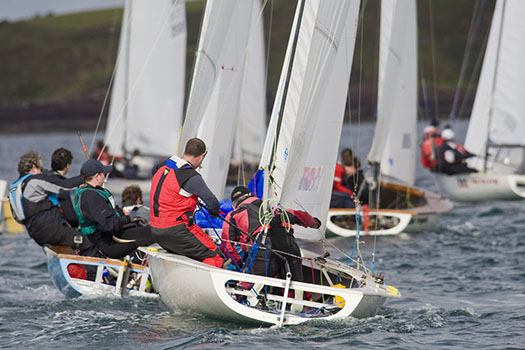
The National 18 fleet in Cork Harbour was mustering serious numbers with the lighter GRP boats from O'Sullivan's of Tralee. Photo: Bob Bateman
So the Crosshaven people got the moulds from England, and encouraged the moving of them to O'Sullivan's Marine in Tralee (incidentlally just about as far west on land as you can get from Whitstable in Kent), where they were used to build a whole new wave of lighter boats which became the National 18 class as most of us have known it until this year. Now, the new moves into the Phil Morrison boat are providing a fresh direction for a class which nevertheless takes careful steps to ensure that older boats have their place in the sun with a chance of realistic racing against similar craft.
Although Jeremy Vines of Tamesis and Lymington is the owner of the first of the new boats (she's number 401, and is called Hurricane in honour of the very first National 18 built by Anderson, Rigden and perkins in Whitstable in 1938), he is untinting in his praise for the energy and vision of the Cork harbour division of the class in having the idea and then promoting the new Phil Morrison boat, and he makes a particular point of applauding the very tangible support which has been given to the project by the Royal Cork Yacht Club.
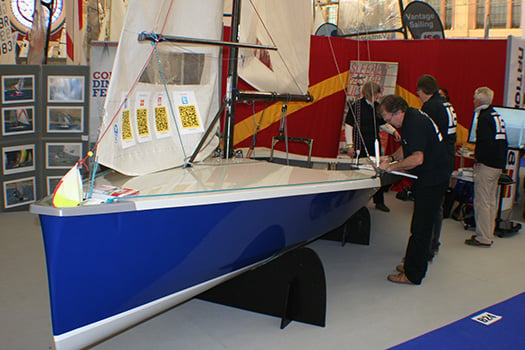
Into the blue.....Hurricane (number 406) is unveiled a fortnight ago at the Dinghy Show.
It's almost unfair, in such a community-based grass roots project, to single out anyone for special praise, but I got the feeling that folk like Colin Chapman, Dom Long and Tom Dwyer have been right there in the thick of it from the beginning.
The prototype having been tested and approved every which way, the moulds were made and the first dark blue hull emerged early in the New Year in one of the workshops which Rob White runs at White Formula Boats at Brightlingsea in Essex. So having been built at Tralee on the shores of the Atlantic for more than a decade, National 18 production is now back on the shores of the North Sea, but the spirit of the class at every location, regardless of where it might be, seems keener than ever.
The first of the new boats - of which sixteen have now been ordered – was Jeremy Vines' Hurricane, number 406, which was unveiled at the recent Dinghy Show in London. For a new generation which has been raised on the Phil Morrison-designed RS 200, this latest variant on the continuing National 18 story will speak volumes, and with eloquence. But it says everything about the spirit of this exceptional class that she rings a bell with seasoned National 18 sailors too.

The gang's all here. The new boat celebrated at the Dinghy Show with a group including many of those actively involved in its development, notably Colin Chapman, Tom Dwyer, Dom Long and Jeremy Vines.
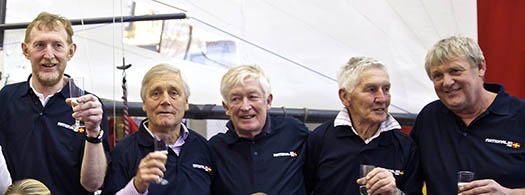
The movers and shakers are (left to right) Tom Dwyer of the Cork Harbour National 18s, designer Phil Morrison, Cork Harbour Class President Dom Long, Jeremy Vines (owner of the first boat to the new Morrison design), and Rob White of White Formula Boats
Did The America's Cup Destroy Belfast Lough Sailing?
#americascup – The 35th America's Cup series will be staged in Bermuda in 2017, and already the first team – Ben Ainslie Racing – is starting to settle into its base in the islands at the beginning of a developing process which, it is hoped by locals, will contribute significantly and sustainably to an economy which is by no means as prosperous as the popular image of Bermuda would suggest.
Yet past experience of being involved with the America's Cup circus suggests that while there are definitely immediate and highly visible benefits, they're ephemeral and are more than offset by a hidden but very definite downside. And the pace of the event at its peak is at such a level that almost immediately afterwards there's a sense of anti-climax and recrimination which can poison a sailing centre's atmosphere for years. W M Nixon considers how sailing's most stellar event affected Irish sailing, looks at a more recent continuation of this story, and then takes up the tale of an old boat whose class's health suffered collateral damage from America's Cup fallout.
It was while tracing the story of Tern, a 37ft William Fife-designed Belfast Lough One Design built by John Hilditch of Carrickfergus in 1897, that we stumbled into what is arguably an example of the America's Cup having a seriously damaging effect on local sailing.
Somehow or other, Tern has survived, and is currently being restored to international standards in Palma, Mallorca. But it was when a couple involved with her restoration came to Ireland shortly after Christmas to spend some time researching her history that we had to face the fact that while Belfast Lough's involvement with the America's Cup is seen as a glamorous and still-celebrated era, as far as everyday sailing is concerned it did little but harm.
The context is intriguing. Belfast in 1897 was the Mumbai of its day. From a population of around 80,000 in 1850, by 1910 its unprecedented expansion through massive industrial innovation and development, built largely around ship-building and linen manufacturing, had seen numbers soar towards 300,000. The city was a byword for pollution, over-crowding, and ill health, but equally it was noted as a place where anyone with energy and an innovative manufacturing idea was expected to have made their fortune within ten years, and around three or four years to start reaching towards wealth was seen as a not unreasonable aim.
In such a frenetic and ambitious atmosphere, sailing on Belfast Lough developed apace, and it developed ambitiously and competitively for all that the lough, while providing splendid sailing water, lacked any really good natural anchorages. New boats and new boat types appeared with bewildering rapidity, and a sort of one design keelboat concept was being accepted by the early 1890s in order to make good racing accessible to keen young men at a reasonable price. There may have been much underlying wealth about, but spending it on extravagances like large and expensive yachts was frowned upon.
By 1896 a young whiskey distiller called James Craig (he later became Lord Craigavon) was promoting the idea of a strict One Design keelboat around 23ft LOA, and about 16ft LWL, designed by the great William Fife in Scotland, but built on the lough by John Hilditch at his Carrickfergus boatyard. As the pioneer of the concept in the locality, Craig called the new class the Belfast Lough No. 1 OD, but the first boat to the design, his own Fugitive, was barely finished before the One Design keelboat ideal was taken up with enthusiasm by another group which decided they wanted something to the same concept, but much larger.
These new boats, the first of which were rapidly built in time for the 1897 season, were almost exactly enlarged versions of Fugitive, but were all of 37ft overall and 25ft waterline. In a case of Might is Right, the bigger boats now became the Belfast Lough Number Ones, while Fugitive and her sisters were demoted to Number 2, and by the early 1900s they'd slipped still further to become the Number 3s when yet another class appeared, this time around 31ft LOA.
There were enough of the new 37ft Number Ones afloat to make a real impact on Clyde Fortnight in 1898, and as they were well able to sail across Channel to do so, they were arguably the world's first offshore one design. The previous year, some had visited Dublin Bay, where they so impressed the locals that they were the inspiration for the Dublin Bay 25s, to the same lines but built to a higher specification and with lead ballast keels, rather than the Belfast Lough boats' cast iron keels.
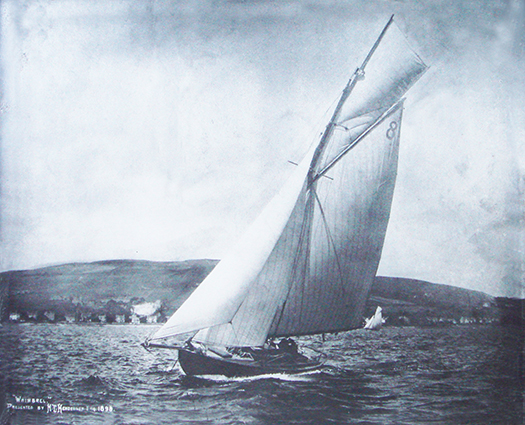
Whimbrel on the Clyde in 1898. They'd the potential to be the world's first offshore one design, but offshore racing hadn't yet been invented. Whimbrel is currently undergoing restoration in Bordeaux. Photo courtesy Gordon Finlay/RUYC
By the middle of the 1898 season, the Belfast Lough One Designs were in all their glory, and our header photo from that season shows a class which surely promised at least a decade of great racing. Yet their peak years barely stretched beyond the turn of the century, and within five years they scarcely existed as a class. Well before the Great War broke out in 1914, they were starting to spread near and far in a scattering which was to continue post war and in most cases ended up in their eventual demise. But remarkably, two have survived and both are undergoing restoration, Whimbrel Number 8 in Bordeaux and Tern, number 7, in Mallorca.
Patricia O'Connell and Alan Renwick live in Palma where he is a master craftsman with Ocean Refits while she – a former Honorary Secretary of a Georgian preservation society in Dublin – has undertaken the tracing of Tern's story, as Tern's restoration is Alan's current project. They arrived in Dublin in the dying days of 2014, and by the time they headed back to Palma well into January, they'd spent time in Cork and Northern Ireland following the old boat's elusive trail, and had also called in Howth to see Ian Malcolm's Howth 17 Aura, which was built in Hilditch's yard within a year of the construction of Tern.
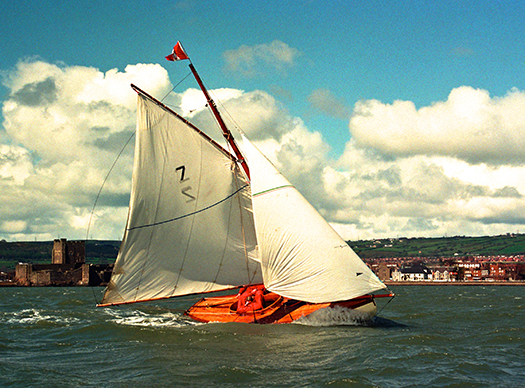
Still going strong. The 1898 Hilditch-built Howth 17 Aura off Carrickfergus Castle for her Centenary, April 1998. With her sister-ships, she then sailed the 90 miles home to Howth. Like Tern, she is number 7 – and like Tern, there's an element of confusion with sail number 2. Photo: David Jones
The original five Carrickfergus-built Howth 17s still sail together as part of a thriving class of twenty Howth 17s. But the impressive class of eight Belfast Lough One Designs from the same era have been remembered for more than a hundred years only as photos on the walls of the Royal Ulster Yacht Club. What went wrong?
The America's Cup – that's what went wrong. In the early years of sailing's premier trophy, there was remarkable Irish involvement. After the schooner America won it with a race round the Isle of Wight in 1851, it took a while to establish a format for races to try and wrest it back from the New York Yacht Club in contests in America. During the 1870s, there were three challenges – two from Britain and one from Canada. Then in the 1880s there were three from Britain and one from Canada, the final one from Britain in 1886 being through the Royal Northern YC of Scotland, but that was because the owner's wife was Scottish – the husband was Lt William Henn whose family home was on the north shore of the Shannon Estuary.
But while the Henn family's hefty cutter Galatea was another unsuccessful challenger, at least she was seen in the waters of the Shannon Estuary. Yet although the first two challenges in the 1890s were by racing machines owned by a yachtsman whose ancestral pile was also on Shannonside, neither boat was seen anywhere near Adare Manor, the home of Lord Dunraven on the south side of the Shannon Estuary, whose two campaigns in 1893 and 1895 were unsuccessful and increasingly acrimonious.
With the passage of time, it becomes increasingly clear that Dunraven got a decidedly raw deal. But in the feverish atmosphere of rapid economic expansion in the 1890s, the world was more interested in pushing ahead with new projects rather than putting right old wrongs. Someone who saw the developing publicity and business potential in the America's Cup was Thomas Lipton, the Scottish-born grocery magnate whose American empire was thriving with a combination of his sheer love of hard work, and gift for publicity.
Lipton had noted the extraordinary level of public interest in Lt & Mrs Henn's "family" challenge in 1886 – they'd actually lived on board the Galatea at he time. But much more importantly, he'd noted the international crisis which arose from the Dunraven affair, and cannily realized that anyone who could smooth the waters with a good-tempered America's Cup challenge would attract acres of favourable coverage, regardless of the actual result.
That said, as a highly competitive individual, there's no doubting he was keen to win. But even though all five of his yachts called Shamrock making his America's Cup challenges between 1899 and 1930 were unsuccessful, with some being much more closely fought than others, he remained resolutely good humoured throughout, and expansion of his retail empire continued unabated. But what's less widely known is that while the America's Cup Shamrocks were numbered I to V, there was a sixth Shamrock, an un-numbered 23 Metre, which raced as his private yacht. It's said that when she didn't perform as well as she should have, the old man could be very grumpy indeed.
But that's all in the future. Here we are in the latter half of the 1890s, and on Belfast Lough this wonderful new class of 37-footers is spreading its wings, thriving on the fact that although the owners lived all round the lough and were members of one yacht club, the Royal Ulster YC founded 1866 and given the "Royal" in 1869, they could feel at home wherever their boats happened to be, as the RUYC had no clubhouse. This was a true sailing club, fixed only to good sailing water, and with the Belfast Lough Number Ones they could sail it well.
It was too good to last. Thomas Lipton was a man in a hurry. He knew that he needed a yacht club of international standing through which to make his first America's Cup challenge. But as he was of humble birth and very much in trade instead of benefitting from inherited wealth, there were few yacht clubs open to him. However, his parents had come from Monaghan, not only in Ireland but particularly in Ulster. In the can-do atmosphere of Belfast in the 1890s, it was indicated that the Royal Ulster might be receptive to his interest. He was soon a member, and plans were roaring ahead for an 1899 Challenge with Shamrock I.
But the RUYC had taken a cuckoo into its nest, or rather its virtual nest. It emerged that a virtual nest was not enough for the aspirations of a serious America's Cup challenger, he needed a real nest. Lipton was soon insisting that his America's Cup challenge, now irreversibly under way, would required the RUYC to have a proper clubhouse impressively sited above the waters of Belfast Lough where it was assumed he would very soon be the defender in the America's Cup.
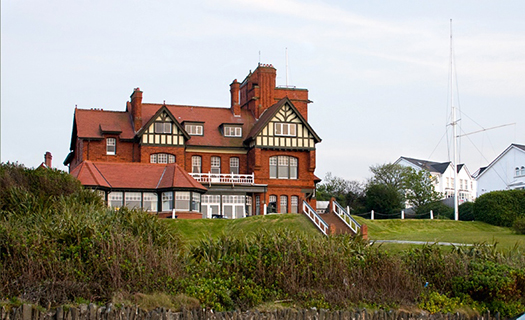
The new RUYC clubhouse was completed at the behest of Thomas Lipton in 1899 after just 18 months work.
And he got his way. An impressive arts and crafts tower-topped clubhouse design was drawn up by James Craig's brother, the architect Vincent Craig, and the new RUYC clubhouse was opened in April 1899, having been built in 18 months flat. Well – not quite flat. They were in such a hurry for completion that there wasn't the time to entirely level the hillside site on the Bangor waterfront where the new clubhouse was built, and even today the ground floor is on two or three different levels.
That said, it's an impressive building to have been put up in such a short time, and somehow they achieved a sort of instant antiquity with it – today it seems much older than its 116 years, and it has always been thus.
But antique or otherwise, it doesn't seem to have been desired by all the members. There were 150 of them, yet only 30 contributed directly to the cost of the new clubhouse. And others took their sailing elsewhere. We live in hope of finding letters or a sailing diary from this period which will tell us what was really going on, for official club committee papers only cover what was on the agenda and recorded in the minutes. Thus even if there was an almighty row going on about the very fact of the somewhat cavalier building of this new clubhouse, at the time it would have been something known to everyone, and talked about by everyone, yet not written down simply because everyone knew of it, and it didn't happen to be directly pertinent to the business of the day. And anyway, once the clubhouse was in being, that was that – the best thing was to get on with living with it.
Yet the fact is that a distinct division arose in sailing along the south coast of Belfast Lough. The conspicuous Royal Ulster YC in Bangor became the public face of yachting in the area. But further up the lough at Cultra beside a roadstead anchorage, what had been a modest canoe club developed in 1899 into an amalgamation of the Ulster Sailing Club with the Cultra Yacht Club to become the North of Ireland Yacht Club, and by 1902 – by which time Lipton had already unsuccessfully challenged twice for the America's Cup through RUYC – the new place at Cultra had become the RNIYC, with a modest clubhouse aimed exclusively at serving its members' sailing needs rather than following grandiose ideas of international yachting campaigns for plutocrats who were only very seldom about the place, if at all.
Inevitably some of the best sailing men in the north were involved with this move to Cultra where many had always anchored their boats in any case, and others had followed. Whether or not the active membership of the RUYC was seriously depleted we can only guess. But the fact is that the relatively small membership of a provincial yacht club had somehow to find, within its membership, the essential people with the necessary talent and experience to provide the back up committee and officer services for Lipton's America's Cup Challenges, with the next one coming along as soon as 1903.

America's Cup design development 1851 to 1930. The Challenge Committee of the RUYC may have come on the scene 48 years after the era of the schooner America, but they still had to cope with the challenges posed by the design development from boats like Reliance in 1903 to the J Class Rainbow in the 1930s.
The drain on RUYC personnel resources was heavy in an era when time-consuming Transatlantic voyages by ship were required for the challenger's committee to meet with the committee of the defending New York Yacht Club. Something just had to give, and it seems to have been the level of personal sailing within RUYC, and particularly with the Number One Class.
The new RNIYC setup at Cultra was establishing its own modest new 22ft OD class, the Linton Hope-designed Fairy Class (also built by Hilditch), so they may well have seen the much larger Number Ones as simply too large, and tainted by the new vulgarity of the RUYC. Whatever the reason, the Belfast Lough Number One Class was a brilliant flame which burned only briefly as a class, even though the boats survived individually with most of them becoming fast cruisers.
But as for the America's Cup, it continued on its melodramatic way, with skulduggery par for the course. After 1903's unsuccessful challenge, when Shamrock III found herself ill-matched against the hyper-giant Reliance, the RUYC committee may have returned home to recuperate and gather strength for Lipton's next campaign. But he was scheming other ideas, and it has been only relatively recently discovered that, unbeknownst to RUYC, he was in preliminary negotiations with the Royal Irish YC on Dublin Bay to organise his fourth challenge.
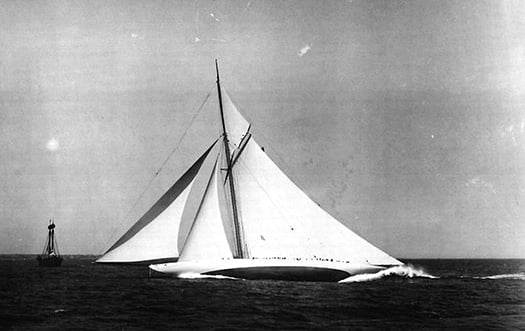
Lipton and the RUYC thought they'd an impressive boat with the Fife-designed Shamrock III in 1903, but this is what they came up against in America – mega-boat Reliance
From a purely commercial point of view, you can understand his thinking. The formerly despised Irish community in the US was expanding rapidly in numbers and prosperity by 1904. Coming in with a challenge through the Royal Irish Yacht Club would hit more market targets than the narrower appeal of a Royal Ulster challenge. It was crude but shrewd business thinking. But fortunately for goodwill in the sailing community, nothing came of it. Challenge 4 through RUYC was slated for 1914, but with the Great War breaking out it was held off - with the radical and very promising Shamrock IV designed by Charles E Nicholson stored in the US – until 1920, with Shamrock IV defeated by the narrowest margin. And then in 1930 came the last challenge, the first with the J Class, but again there was defeat, this time for Shamrock V.
And thus 1930 saw the end of the Royal Ulster YC's tumultuous three decades affair with the Holy Grail of sailing. Since then, other clubs have had their collective finger burnt by the America's Cup. But it usually promises more than it gives. Most recently, sailing has been bluntly reminded of its limited appeal as a spectator sport, even when packaged as America's Cup Plus. The 34th series in San Francisco may have provided some of the most exciting racing ever seen in the event's 164 year history. It made great television for aficionados. And it may have attracted 150,000 shoreside spectators over the length of the series. But let's get it into perspective. San Francisco's Number One tourist attraction is Alcatraz. This island with its former prison fortress linked to the likes of Al Capone and other adornments of American society attracts around a million visitors a year. No matter which way you slice the numbers, that's quite a few more than the America's Cup, it doesn't cost nearly as much, and it's much less trouble to run.
Which goes some way to explain why those of us who live for this crazy old vehicle sport of ours retreat into the happy dreamworld of old boats and their winding journeys through life, often to a wonderful re-birth. And the story of Tern is a classic of its kind. From Belfast Lough she headed some time or other to Cork, we don't quite know when, but we do know she was converted to a yawl for greater ease of handling in 1914. And she was certainly in Cork in the 1920s and 1930s owned seemingly by a loose syndicate, as different owners appear at different times depending on what event she is being entered for, and in 1929 she was one of five yachts taking part in the Irish Cruising Club's Founding Cruise-in-Company to Glengarriff, owned by Capt P F Kelly.
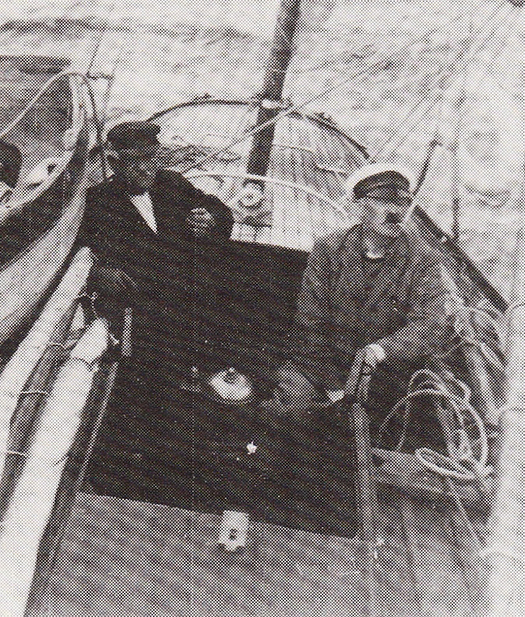
Happy days. Aboard Tern in cruising style, complete with enormous dinghy on the starboard deck, on her way to the founding of the ICC in Glengarriff in 1929 with Captain Kelly and Dr Dan Donovan enjoying the sail
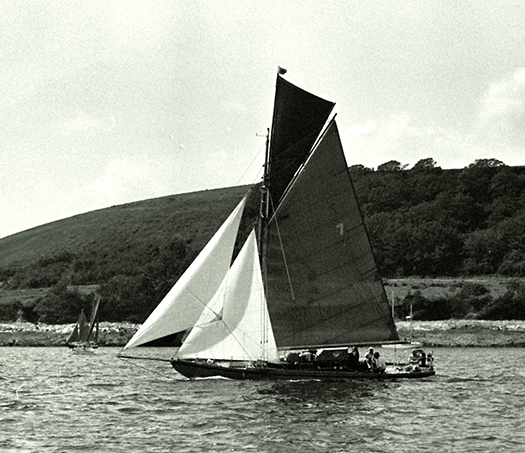
Tern in Falmouth, July 1990. Rot had long since set in within her long and elegant Fife counter, so it had simply been chopped off. Photo: W M Nixon

Tern being overcome by the heat in Andraitx in Mallorca, October 2012. Photo: Patricia Nixon
Yet by 1947 according to Lloyds Register she was in Dun Laoghaire, owned by two members of the National Yacht Club, C E Hogg and M Healy. And then she turns up in Falmouth Harbour in the 1970s and stays there for some time, but she was restored to being a cutter, not with full rig but her mizzen had to be done away with, as there was rot in her long elegant Fife counter, so it was simply chopped off to become like a Laurent Giles stern.
It was then in a little yard in a hidden creek off Falmouth Harbour that she had her first major restoration, and with that she went to the Mediterranean. But by the Autumn of 2012 she was seen in Andraitx looking a bit sorry for herself, and very much for sale. And there she was bought and taken into the specialist yard in Palma, and at the end of December 2014 Patricia O'Connell and Alan Renwick turned up in Ireland and began a pilgrimage.

Alan Renwick and Ian Malcolm aboard the latter's Aura in Howth, December 30th 2014. Aura had Tern have just one year age difference, but the same builder. Photo: W M Nixon
This took them to Howth to see the Hilditch-built Aura (like Tern, she's number 7, and like Tern, at one time her mainsail was mixed up with a number 2). Then it was down to Crosshaven to meet Royal Cork archivist Dermot Burns, who was a fund of information and original material abut Tern's twenty-plus years on Cork Harbour. Then on north to Belfast Lough for a large gathering in the Royal Ulster, a party built around the Charley family, one of whose ancestors owned Tern in 1910, and also brought in folk like noted northern sailing historian Michael Clarke of Lough Erne, and Fife yachts historian Ian McAllister who now lives in Carrickfergus. So you can well imagine that information and ideas overload was a constant risk. But Patricia and Alan survived, they got back to Palma in one piece, the work on Tern resumed, and the Tale of Tern goes on.

There's a Fife hull in there somewhere. Tern in the restoration shed in Palma
Ireland Hit The High Spot In The Sydney Hobart Race 23 Years Ago
#rshyr – Ireland's fascination with the Rolex Sydney-Hobart Race moved onto a new plane in 1991, when a three-boat Irish team team of all the talents had a runaway win in the Southern Cross Series which culminated with the 628-mile race to Hobart. The three skipper/helmsmen who led the squad to this famous victory twenty-three years ago were Harold Cudmore, Joe English and Gordon Maguire, all on top of their game.
These days, the incomparable Harold Cudmore is still a sailing legend, though mostly renowned now for his exceptional ability to get maximum performance out of large classics such as the 19 Metre Mariquita, sailing mainly in European waters.
But sadly, Joe English passed away just eight weeks ago in November in Cork, much mourned by many friends worldwide. Yet for Gordon Maguire, the experience of sailing at the top level in Australia was life-changing. He took to Australia in a big way, and Australia took to him as he built a professional sailing career. And he's still at it in the offshore racing game as keenly as ever, with 19 Sydney-Hobarts now logged, including two overall wins.
He raced the challenging course of this 70th 2014 edition as sailing master of the Carkeek 60 Ichi Ban, a boat which is still only 15 months old, having made a promising though not stellar debut in 2013's race. Also making a determined challenge was the First 40 Breakthrough with a strong Irish element in the crew led by Barry Hurley, fresh from the class win and second overall in October's Rolex Midde Sea Race.
And high profile Irish interest was also to be found aboard the Botin 65 Caro, the record breaker in the 2013 ARC Transatlantic Race. She's a very advanced German-built "racer/cruiser" aboard which Ian Moore - originally of Carrickfergus but longtime Solent-side resident - was sailing as navigator.
W M Nixon casts an eye back over the 2014 race, whose prize-giving took place in Hobart yesterday, and then concludes by taking us back to 1991, when Ireland moved top of the league in the Offshore Racing World Team Championship on the same occasion some 23 years ago.
It has to have been the most keenly-anticipated debut in recent world sailing at the top level. At last we'd get to see how Comanche could go in serious sailing. When the 70th 628-mile Rolex Sydney-Hobart Race started on Friday December 26th at 0200 hours our time, 1300 hrs local time in Sydney Harbour, this was for real. There may have been 117 boats of all shapes and sizes from 33ft to 100ft in the fleet. But all eyes were on the limit-pushing 100ft Comanche, skippered by the great Kenny Read. The world wanted to see how she would show what she could do when the chips were down, when the racing was straight line stuff, and when some serious offshore battling was in prospect instead of the inshore-hopping mini-test which had been seen in the Solas Big Boat Challenge in Sydney Harbour on December 9th.
In that, the well-tested Wild Oats XI, skippered by Mark Richards, had sailed a canny race to take the line honours win from the other hundred footers. But the majestic Comanche, owned by Jim Clark and his Australian wife Kristy Hinze Clark, had shown enough bursts of speed potential to raise the temperature as the start of the big one itself approached.
And in a brisk southerly at the start, Comanche didn't disappoint. She just zapped away from Wild Oats to lead by a clear 30 seconds and notch a record time at the first turning mark to take the fleet out of Sydney Harbour, and that dream debut was what made the instant headlines on the beginning of the 628–mile slog to Hobart.
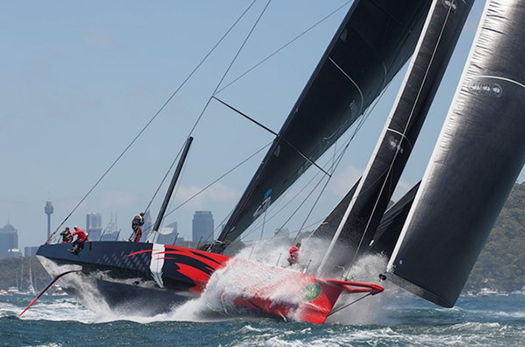
The moment of glory – the mighty Comanche roaring down Sydney Hobart at the start to log a record time to the first turning mark. Photo: Rolex/Daniel Forster
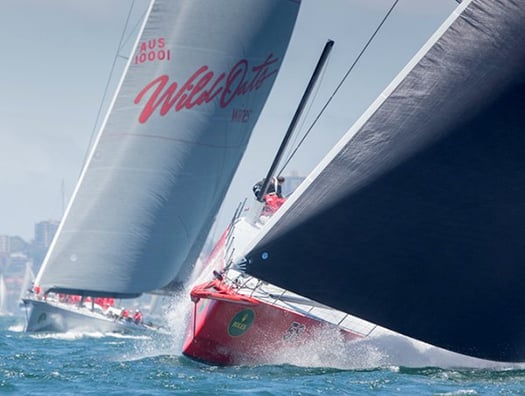
No two ways about it – Comanche is clear ahead of Wild Oats XI approaching the first mark. Photo: Rolex/Daniel Forster
But out at sea, with winds strengths varying but mostly from the south for the first day or so, different stories begin to emerge. A grand sunny southerly sailing breeze may provide lovely sailing and pure spectacle in Sydney Harbour. But get out into the Tasman Sea to head south for Hobart, and you find that the wayward south-going current – always a crucial factor in the early stages of the race to Hobart – can be going great guns and making mischief as a weather-going stream, kicking up a steep sea which can be boat-breaking when that last ounce of performance is being squeezed out.
And as previewed here on December 20th, up among the hundred-footers they've been pushing the envelope and then some in boat development and modification. In new boat terms, the mighty and notably beamy Comanche has gone about as far as they can go for now. But with the likes of the former Lahana reappearing as Rio 100 with a complete new rear half, and Syd Fischer's Ragamuffin 100 simply cutting away the hull for replacement with a complete new body unit while retaining the proven deck and rig, we're sailing right on the edge in terms of what the weird mixtures of new and old build can combine for combat when the seas are steep.
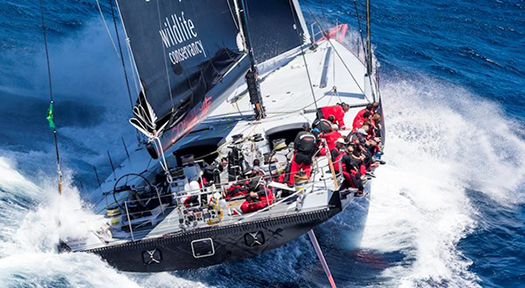
Comanche's wide beam gives added power when there's plenty of breeze......Photo: Rolex/Carlo Borlenghi
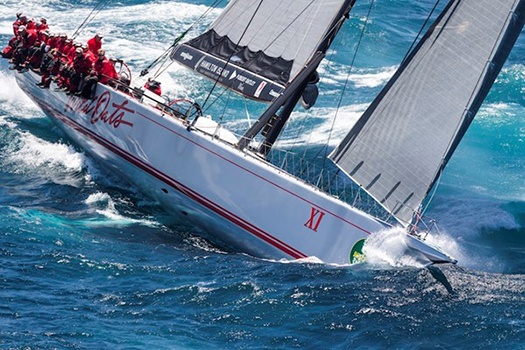
....but the narrow Wild Oats XI can be as slippery as an eel when the head seas get awkward, and when the wind eased she got through Comanche and into an extraordinary 40 mile lead on the water. Photo: Rolex/Carlo Borlenghi
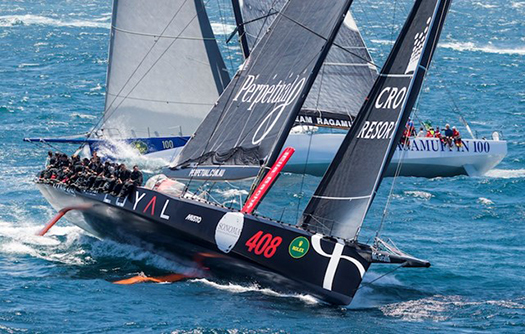
Not all boats revelled in the bone-shaking conditions of the first hundred miles of beating. Perpetual Loyal (foreground) had to pull out with hull damage possibly caused by an object in the water, but the irrepressible Syd Fischer's Ragamuffin 100 (beyond), with a completely new hull, continued going strong to the finish and was third in line honours Photo: Rolex/Carlo Borlenghi
But this glorious element of larger-than-life characters with boats that are off-the-wall is now an integral part of the RSHYR, which manages to attract an enormous amount of attention thanks to its placing in the midst of the dead of winter in the Northern Hemisphere, while in Australia much attention focuses on what is in effect an entire and familiar maritime community racing annually for the overall handicap prize.
Yet though the course is simple, it's deceptively so. Just because it's mainly a straight line from one harbour to another doesn't mean there aren't a zillion factors in play. And as the race gets so much attention, few offshore events of this length are so minutely analysed, and the first 24 hours provided a veritable laboratory for seeing the ways different boats behave in different wind and sea states with the breeze on the nose.
Thus Wild Oats XI has always had a formidable reputation for wiggling her exceptionally narrow hull to windward in awkward seas for all the world like a giant eel, and the early beating saw her doing that very thing, hanging in there neck and neck with Comanche. Despite her beamier hull, Comanche rates slightly lower than Wild Oats. But if a lull with its leftover sea arrived, her greater volume would become a liability to performance, whereas if the breeze got back to full strength, and particularly if it freed the two leaders, then Comanche would be firmly back in business.
But it was not be. Crossing the Bass Strait with Wild Oats right beside them, Comanche's crew saw their navigator Stan Honey emerge on deck and approach Kenny Read with a thoughtful expression on his face, and an ominous little slip of paper in his hand. It was the latest weather print-out, and it wasn't happy reading for a big wide boat that needs power in the breeze. Before expected brisk winds from the north set in, they'd to get through the lighter winds of an unexpectedly large and developing ridge.
Almost while they were still digesting this bit of bad news, Wild Oats started to cope much better with the lumpy leftover sea, and wriggled ahead of Comanche in her classic style. And the further she got ahead, the sooner she got into increasingly favourable wind pressure. As Read put it after the finish: "For twelve hours, conditions were perfect for Wild Oats, and they played a brilliant hand brilliantly".
Amazingly, the old Australian silver arrow opened out a clear lead of an incredible forty miles before conditions started to suit Comanche enough to start nibbling at this remarkable new margin. And fair play to the Read crew, at the finish they'd made such a comeback that Wild Oats was only something like 49 minutes ahead. But even with the new American boat's slightly lower rating, she was beaten on handicap too, and in the final rankings Wild Oats showed up as having line honours overall and a commendable 5th on IRC in Division 0 - and we shouldn't forget she won the overall handicap honours back in 2012 anyway.
But for 2014's race, for a while it looked as if it might be the Cookson 50s again for the overall win. But although last year's Tattersall's Cup winner, the Cookson 50 Victoire, at first took the Division 0 win with her sister-ship Pretty Fly III second, they were so close that when Pretty Fly got 13 minutes redress for an incident with the Ker 46 Patrice in mid-race, it reversed their placings.

It all came good in the end....after being initially placed second in Division 0, the ten-year-old Cookson 50 Pretty Fly III got 13 minutes of redress for an adverse incident during the race, and that bumped her up to the Division 0 win.
Either way, it was still Cookson 50s imprinted all over the sharp end of Division 0. But they were slipping in the overall rankings, where it was boats in the 40-45ft range which were settling into the best combination of timing and conditions to take the Tattersall's.
And plumb in the middle of them was the First 40 Breakthrough, with her strong Dublin Bay Sailing Club input from the Irish team led by Barry Hurley. Fortunes wax and wane with astonishing volatility as the Hobart race progresses, but gradually a pattern emerges. So though at one stage Breakthrough was showing up only around 30th overall, equally she'd a best show of third.
And all around her on the water were similarly-sized and similarly-rated boats with their race-hardened crews knowing that with every mile sailed and every weather forecast now fallen favourably into place, things were looking better and better for this group to provide the overall winner.
It was a very race-hardened crew which came out on top. It was way back in 1993 that Roger Hickman got his first Sydney Hobart Race overall win in an eight year old Farr 43 which was still called Wild Oats, as original owner Bob Oatley hadn't yet reclaimed the name for ever bigger Grand Prix racers. When he did start to go down that road, the 1985 Wild Oats became Wild Rose, but "Hicko" still owns her. And by the time the Rolex Sydney-Hobart Race 2014 started, he was doing it for the 38th time. He went into it as current Australian Offshore Champion, now he has won the big one on top of all that. Some man, some boat.
The slightly higher-rated Breakthrough was pacing with Wild Oats for much of the race, but as Barry Hurley's report for Afloat.ie told us with brutal honesty, somewhere some time they got off the pace. If you didn't know already of Barry's remarkable achievements - which include a class win in the single-handed Transatlantic Race and the more recent Middle Sea Race success – you would warm to the man anyway for the frankness of his initial analysis of why Breakthrough slipped from being a contender to 12th overall and – more painfully – down to 7th in their class of IRC Division 3.
He promises us more detailed thoughts on it in a few weeks time, something which will be of real value to everyone who races offshore, for the race to Hobart is a superb performance laboratory. And maybe we can also hope in due course for further thoughts from someone on whether or not Matt Allen's Carkeek 60 Ichi Ban, skippered by Gordon Maguire with Adrienne Cahalan as navigator, has what it takes to be a killer.
It's easy for us here in Ireland to look at screens of photos and figures and reckon that Ichi Ban is just a little bit too plump for her own good. But Maguire has twice been key to a Sydney-Hobart overall win, the most recent being in 2011 with Stephen Ainsworth's Loki. And Cahalan's record of success as a navigator/tactician is almost without parallel. Yet though Ichi Ban's 2014 Hobart race score of 8th in line honours and fourth in IRC Division 0 is a thoroughly competent result, it just lacks that little bit of stardust.
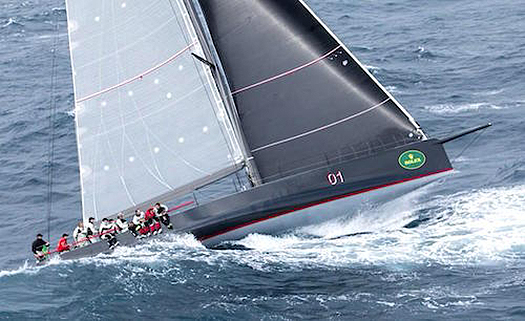
Ichi Ban finding her way through the waves on her way to Hobart. If that's not a spare tyre around her midriff, then what is it?
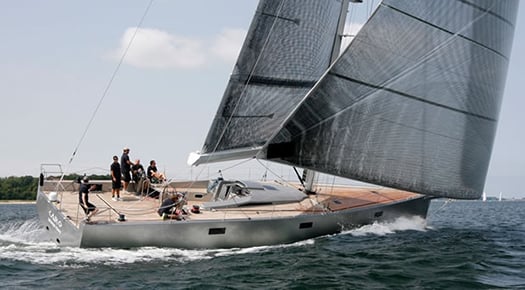
Despite being a "racer/cruiser", the Botin 65 Caro – navigated by Ian Moore – pipped Ichi Ban for third in class.
With the next Rolex Sydney-Hobart Race just over eleven months down the line, let's hope we're proven utterly wrong within the year on the Ichi Ban question. But the whole matter is pointed up by the fact that the boat which pipped in ahead of her in the IRC Div 0 placings in third place behind the two Cookson 50s was the Botin 65 Caro, with our own own Ian Moore navigating on this 65 footer which likes to emphasize her dual role as a racer-cruiser.
Now there really is food for thought. But in this first weekend of this wonderful new year of 2015, let's remember some of the events of December 1991 as recorded in excited detail in the Afloat magazine of Feb/March 1992.
On the cover is Meath-born John Storey's Sydney-based Farr 44 Atara, around which the Irish Southern Cross team of 1991 was built, as Harold Cudmore was aboard, and he brought out John Mulcahy from Kinsale and John Murphy from Crosshaven.
The small boat of the team was Tony Dunne's Davidson 36 Extension – the owner claimed Irishness through the Irish granny rule, but the matter was put beyond any doubt by Joe English being on board with Dan O'Grady and Conor O'Neill. And then for the third boat they'd Warren John's Davidson 40 Beyond Thunderdome, whose owner was happy to be Irish if they'd let him, and to put the matter beyond doubt his vessel was over-run by Howth men in the form of Gordon Maguire, Kieran Jameson, and Roger Cagney, with Dun Laoghaire's Mike O'Donnell allowed on board too, provided he behaved himself.

In the Southern Cross Series of 1991, the Davidson 40 Beyond Thunderdome was raced for Ireland by Gordon Maguire and Kieran Jameson. Thunderdome was top of the points table when she was knocked out with a dismasting in the final inshore race, and was unable to race to Hobart.
It was an accident-prone series, with Beyond Thunderdome dismasted in a tacking collision with one of the Australian boats with just three days to go to the start of the Hobart Race. There simply wasn't time to get a replacement mast, let alone tune it, but at the last minute the jury decided the Australian boat was at fault, and allowed Beyond Thunderdome average points not only for that race in which she'd been dismasted, but also for the Hobart Race which hadn't even yet been sailed.
In a final marvellous twist to the story, as Thunderdome couldn't race to Hobart, Gordon Maguire was drafted aboard Atara to add helming strength for the big one. Atara had only been a so-so performer until the big race. But Cudmore and Maguire – that really was the dream team. And it gave the dream result. Atara won the 1991 Sydney-Hobart race overall by a margin of one minute and 50 seconds. It was one of the closest results ever, but it was a close shave in the right direction for Ireland. The Irish party in Hobart to welcome 1992 was epic. And Gordon Maguire's sailing career was set on a stellar course.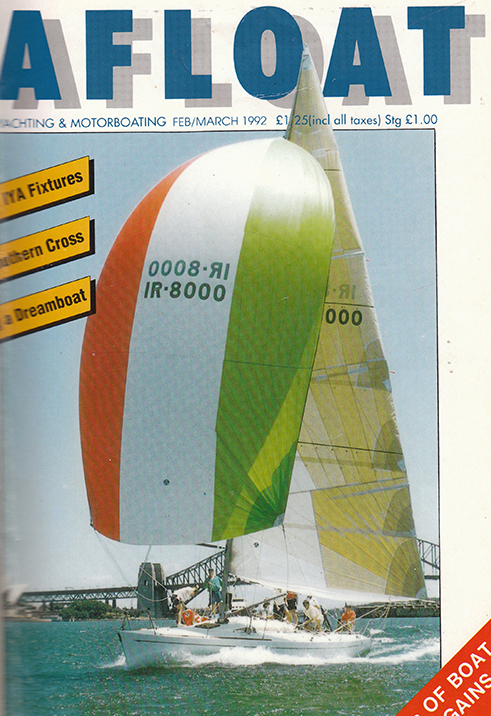
Our magazine edition of February/March 1992 cover-featured John Storey's Farr 44 Atara, overall winner of the 1991 Sydney-Hobart race with the dream team of Harold Cudmore and Gordon Maguire on board to give Ireland the win in the Southern Cross Series.
Seascapes On RTE Radio 1 Has Much To Celebrate After 25 Years
#seascapes – The maritime community in Ireland is a mystery to the vast majority of the rest of the population. Admittedly anyone Irish will sing enthusiastically about how good it is to be entirely surrounded by water. But for most folk among a people who like to think that they're basically rural even if the reality is they're increasingly urban, the sea is seen as no more than a useful barrier, while the coast is only briefly a fun place at the very height of a good summer.
The sea and the coastal interface are not seen as an exciting world in itself, a unique environment which deserves to be explored, enjoyed and utilised in practical and often beneficial ways. On the contrary, the popular view of the plain people of Ireland is that the less they know about the sea, the better. And the unspoken corollary of this is that anyone who seeks to go to sea for recreation is at best a bit odd, maybe even a misfit ashore, while those who work on the sea only do so because they couldn't get a job on land.
Here at Afloat.ie, in its various manifestations over the past 52 years, we've been trying to spread mutual understanding and useful information among the many and varied strands of those who go afloat for sport and recreation in Ireland and beyond. We know this is largely a matter of preaching to the converted. But we also try to do our bit to welcome those who may be newcomers to the world of boats, while remaining keenly aware of the drawbacks of over-selling our sport, our hobby – our obsession, if you wish.
Sailing and boating in Ireland can be rugged enough. Thus the sport in all its forms can only expand in a sustainable way if it attracts people who will themselves bring something positive to the party, for interacting usefully with boats is not a passive affair. And there has been a certain level of success. Over the years, while there was an understandable blip in boating numbers during the recent recession, the graph has been reasonably healthy when it's remembered that rival sport and entertainment attractions are proliferating all the time, while the increasing availability of holidays afloat in sunnier climates makes the promotion of boating activity within Ireland more problematic.
Fifty-two years ago, beginning a process of regular communication among Ireland's recreational boating community was quite a challenge. But it was a very straightforward project compared with inaugurating a regularly weekly broadcast maritime programme for all listeners on national radio in a country notably averse to the sea. Yet it all began 25 years ago, and it's still going strong.
So how do you celebrate 25 years of a niche radio programme, a little Irish maritime magazine of the air? It would be too much to expect a documentary on primetime television. And even an extra-long gala edition on the national radio airwaves at peak listening times might well be counter-productive. So it seems the answer is that the best way to celebrate 25 years of Seascapes on RTE Radio 1 is to publish a book well-filled with some of the key broadcasts with which it has been associated. And as those now-printed broadcasts include a maritime-themed series of the prestigious Thomas Davis Lectures, you mark the anniversary by sending out those as broadcasts again in their own right twelve years after their first transmission.
It may all sound almost devious, a matter of managing to slip the Seascapes celebrations in under the RTE management radar. But those of us who have been banging the maritime development drums for a very long time are well aware that, though the tide is definitely turning, there's still a huge underlying resistance to anything to do with the sea and boats, and it takes an element of cunning to get the message across such that, in time, the people are themselves singing from the same hymn sheet, and thinking it was all their idea in the first place.
But the founder of Seascapes 25 years ago, RTE's Cork reporter Tom MacSweeney, makes your average terrier look like a tired old dog. A sailing and maritime enthusiast himself even though his family had been from a non-maritime background, he had as a child in Cork been inspired by his grandfather's great respect for seafarers, and the vital task they performed in keeping Ireland connected with the rest of the world. He could see the sea all about us, and Cork is the most maritime of cities. So he just kept nagging RTE until they gave him a quarter of an hour once a week back in 1989 to put on a maritime programme for an island nation. And though it has been shifted around in the schedules, it is now a solid half hour every Friday night at 10.30pm, a worthy fulfilment of RTE's public service remit - you really do get a sense of Seascape's nationwide listening community, while podcasts make it more accessible than ever.
The sheer volume of material from all round Ireland's coasts, from our lakes and rivers, and from Irish seafarers abroad, is simply monumental, a treasure trove. So in producing the book (it's published by Liffey Press at €20 with all royalties going to the Lifeboat Service), they'd to wield a fierce scalpel. And though it includes the complete set of Thomas Davis lectures from twelve years ago, it's still of manageable size (in other words, you can read it in bed), while giving a good overview and flavour of the kind of material Seascapes broadcasts, and what we might call the house style.
In Tom MacSweeney's days of producing and presenting it from 1989 until he retired from RTE in January 2010, it has to be agreed that very occasionally the nagging which got Seascapes its slot in the first place sometimes spilled over onto the airwaves in the programme itself. Okay, we all know that Ireland is not as sea-minded as it might be. But things are slowly improving in this, and they might improve more quickly if the maritime movement relied more on the path of gentle encouragement and inspiring example rather than constantly reiterating the tedious refrain of "the government should do this, the government should do that....."
From time to time, I have to confess I thought the worst possible thing was to get the government involved at all, having seen what the official encouragement and enforcement of the Irish language had achieved since the establishment of the state. There'd be occasions when you'd think the best way to turn the Irish into a nation of doughty sailors would be to declare seafaring illegal. The people would have taken to boats in their droves....But nevertheless the tide is slowly but definitely turning, and in today's less frenetic atmosphere of businesslike maritime promotion and development, we're becoming more comfortable in our relationship with the sea.

Man of the sea. Rear Admiral Mark Mellett DSM on exercises with the Naval Service off the Cork coast.
So it was entirely appropriate that, in the launching of the Seascape's compendium Sailing By, the main speaker in both the Cork Harbour Commissioners' building on the Friday night (November 28th), and in the National Maritime Museum in Dun Laoghaire on Monday, was Rear Admiral Mark Mellett DSM, our most distinguished navy man, who has risen to the august heights of Deputy Chief of Staff of the Defence Forces.
If you requested Central Casting to provide an Irish Admiral who conveys the expected air of competence with the necessary gravitas and presence, while still having that essential Irish twinkle, then they'd send you Mark Mellett. We'd most of us heard of his steady rise through the senior ranks, but for many of us in the National Maritime Museum on a damp December night, it was the first experience of seeing Admiral Mellett in a professional and public capacity. For people from a very wide range of interests and activities in the maritime sphere, it was very encouraging – we feel we now have a spokesman who can ably represent us at every level, however formal or high powered, while at the same time retaining the human touch.
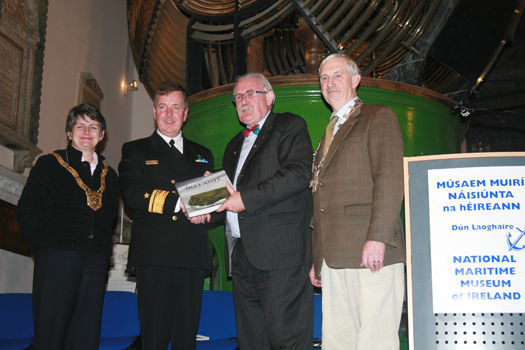
Top people at the launching of the Seascapes book Sailing By are (left to right) Cllr Marie Baker (Cathaoirleach of Dun Laoghaire-Rathdown County Council), Rear Admiral Mark Mellett DSM (Deputy Chief of Staff , Defence Forces), Marcus Connaughton of Seascapes, and Richard McCormick, President of the National Maritime Museum. Admiral Mellett is being presented with the book The Atlantic Coast of Ireland, as he already has his own copy of Sailing By – he wrote the foreword.
His enthusiasm is palpable, and he provided a foreword for the book which speaks from the heart, yet provides a practical and businesslike outlook. In fact, that was the flavour of the evening in the National Maritime Museum, as it was hosted by Richard McCormick, the recently elected President of the National Maritime Museum, and the speakers included the Cathaoirleach of Dun Laoghaire-Rathdown County Council, Cllr. Marie Baker, and Tom McGuire, head of RTE Radio 1, who knows better than anyone just what has been needed to keep Seascapes on the airwaves for 25 years.
Most of all it has of course been the sheer dogged determination of Tom MacSweeney working on his own as producer and presenter in RTE's Cork studio, followed by his successor Marcus Connaughton, who came in as producer when the Thomas Davis Lectures were added to an already almost impossibly demanding schedule in 2002, and stayed on to become presenter eight years later.
They're two very different people. Tom is so involved and enthusiastic that occasionally his own personality, opinions and attitudes cloud the issue. He's a complex man with many interests, not least of them being a national Vice President of the St Vincent de Paul Society. But as regular visitors to Afloat.ie will know, he continues to broadcast his own maritime programmes through community radio, and he's a much-sought-after speaker on sea matters. Recently, he gave a sold-out talk - How Stands Our Island Nation? - to the Dublin Bay Old Gaffers Association in the Poolbeg Y&BC, and while he had the usual serious message, it was leavened by his sharp wit, with the laugh of the evening being provided by his reading of the pained official letter from an Irish Lights Manager complaining about the sheer incompetence and slovenly carelessness of Brendan Behan when he was employed as a painter renovating the St John's Point lighthouse in County Down.
That said, it was a telling lesson in the importance or otherwise of maritime affairs in Ireland's national and cultural life in times past, that the story of a noted playwright making a complete hames of painting a lighthouse was something you knew would register more readily with a general audience than anything of more direct nautical interest, and it is an awareness of the need to reach out gently to the general public which sets the tone of Marcus Connaughton's presentation of Seascapes.
He arrived in the job first as producer, and then as producer/presenter, with no personal baggage in maritime matters. His background was in music production and public relations, and a couple of years ago he brought seventeen years of research and writing to a successful conclusion with the defining biography of Rory Gallagher. But gradually he has become absorbed in and intrigued by the world of boats and the sea. As one of the speakers on Monday night put it, one of the most quietly impressive peformances you'll see is Marcus – who is by no means a small man – sidling into the crowd at some maritime gathering, armed with microphone and recorder, ready and willing to give a voice to the voiceless.
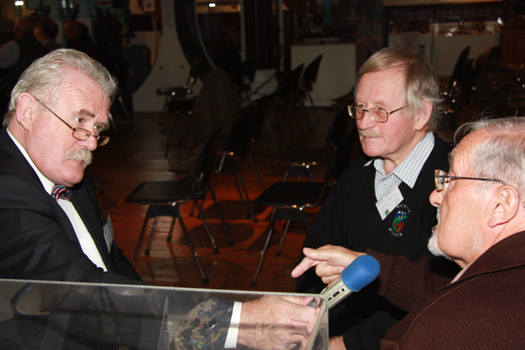
Man at work – Marcus Connaughton records the memories of Alan Martin and Jimmy Carthy of the Dublin Dockworkers Preservation Society
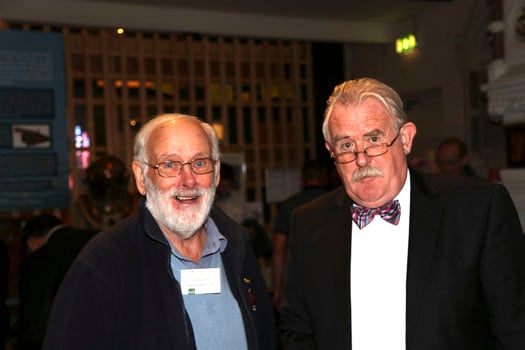
Tim Magennis (left) President of the Dublin Bay Old Gaffers Association, with Marcus Connaughton. Once upon a time, they were work colleagues in the PR Department of Bord Failte

The book launch begins to become a party – Con Murphy of the National YC (left) and Brian Craig of the Royal St George YC getting their copies of Sailing By signed by Marcus Connaughton in the National Maritime Museum. Photo: W M Nixon
The changeover to a new presenter was fairly gradual, but very marked in one thing – he changed the signature tune. When Seascapes started in 1989, they simply borrowed the music which precedes the BBC Shipping Forecast, Ronald Binge's "Sailing By".
"Sailing By" in almost any form is the sound of syrup being poured over sugar lumps, but some folk loved it, so the change to the brisk tone of Simon Mayer's The Reel Thing wasn't universally popular, even if welcomed by those of us trying to cut down on the sucrose.
Yet it's surely an appropriate 25th anniversary sweetener that the published compendium of Seascapes stories is titled Sailing By, and the cover is a fine photo of the renowned pilot cutter Jolie Brise sailing by the Fastnet Rock. It was taken by Brian Carlin of Tralee, who subsequently went on to be the award-winning photographer aboard the Volvo 65 Team Vestas, which unfortunately managed to do some excessive impactive navigation off Mauritius during the Volvo World race last weekend. It was certainly not the photographer's fault, but it heightened the sense of an Irish maritime community worldwide that at Monday night's gathering, Marcus was able to tell us that not only was Brian all right, but that in contacting his father to say so, he requested that the message be passed on to Seascapes as soon as possible.
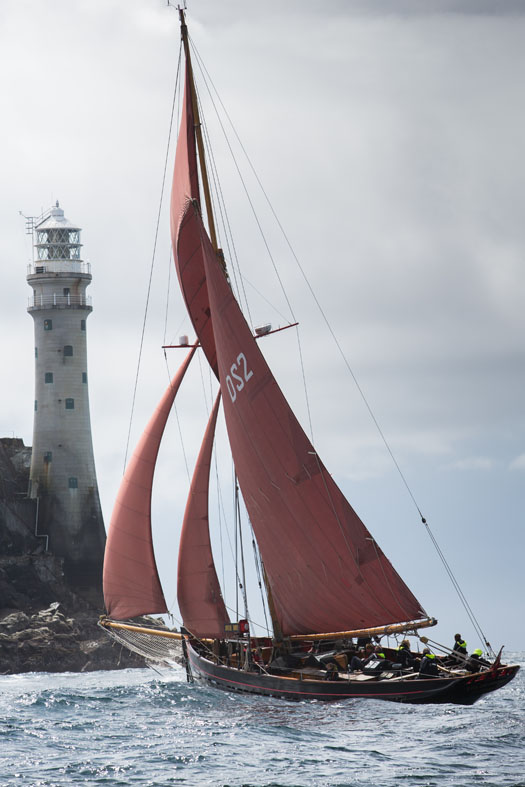
One of award-winning photographer Brian Carlin's studies of Jolie Brise sailing by the Fastnet Rock. Photo: Brian Carlin
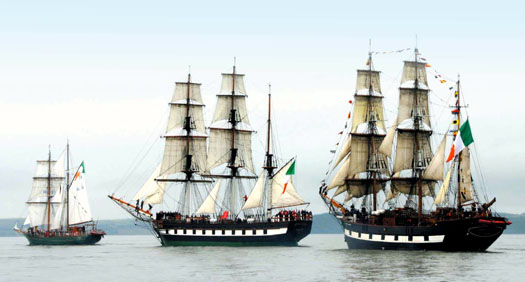
The top moment – it's 2005, and the Seascapes team are on board Asgard II as she leads the Dunbrody of New Ross, and the Jeanie Johnston of Tralee, in the Parade of Sail at the Tall Ships visit to Waterford. Photo: Dave Osborne
As for Marcus's own special recollections of his years with Seascapes, we allowed him six and he ranked them: (1) Being on Asgard II in Waterford with the Tall Ships in 2005, (2) at sea off Hook Head with Martin Colfer amidst enormous schools of lively dolphins, (3) in Galway during both Volvo visits, (4) being far up his beloved Munster Blackwater beyond Ballinatray at the top of the tide, (5) celebrating 25 years of the Killybegs Fishermen's Association at a monster party in the great Donegal port, and (6) being in the renovated National Maritime Museum in Dun Laoghaire when it was re-opened by President Michael D Higgins.
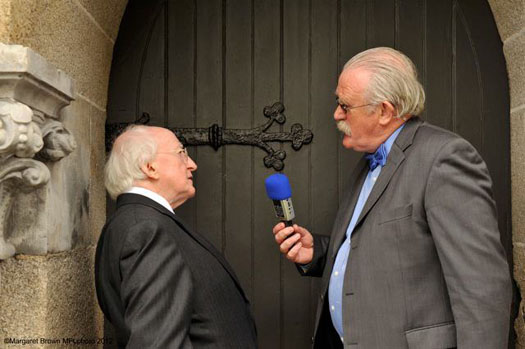
Presidential thoughts of the sea and seafaring in Ireland – Seascapes interviews President Higgins after he has re-opened the restored National Maritime Museum in Dun Laoghaire. Photo: Margaret Brown
Seascapes was of course broadcast as usual last night at 10.30pm, and Marcus Connaughton will be signing copies of Sailing By in Waterstones in Cork this afternoon from 2.0pm to 5.0pm. The first of the six Thomas Davis lectures from 20012 – Paddy Barry's lyrical account of sailing round Ireland – will be broadcast on Friday December 19th, and they'll continue weekly until the final one on February 6th, which is my own item about why most people in Ireland think sailing enthusiasts are so odd. As mentioned at the Glandore Summer School in July, I've changed my mind about some aspects of that, and I'll probably have changed it yet again when Marcus provides me with the space for further thoughts on the matter on Seascapes some time after February 6th.
But meanwhile, happy birthday to Seascapes – you provide a wonderful example of genuine public service broadcasting.
Afloat's Sailors of the Month Reflect Irish Sailing's Year–Round Diversity
#sailorofthemonth – The Afloat "Sailor of the Month" Award has been a central feature of Irish sailing since 1996, and before that we ran various Sailors of the Year awards with several categories. But with the development of the "Sailor of the Month" concept, and its peak of achievement in one single "Sailor of the Year", the intention has been to give expression to the fact that the world of boats and thinking frequently about being afloat is a year-round Irish interest, even if in times past there was a distinctly defined sailing and boating season.
YOU CAN VOTE FOR YOUR SAILOR OF 2014 BY SCROLLING DOWN TO THE END OF THIS PAGE!
(VOTING HAS NOW CLOSED)
The overall national award will be presented to the person who, in the judges' opinion, achieved the most notable results in, or made the most significant contribution to Irish sailing during 2014.
The boating public gets to nominate their top three through the online poll, Afloat.ie gets a vote too and the Sailor of the Year judges decide the final winner.
With modern materials and changed attitudes, there is now genuine year-round boat activity within Ireland, albeit at a much more muted level in winter than in high summer. But as well, the increasing size and awareness of the Irish diaspora, and the way that rapidly improving global communications keep us in frequent and intimate communication with Irish sailors in every corner of the world - whether afloat or ashore - means that for the greater Irish sailing community, it is endless summer.
The worldwide responses we get in the comments sections of Afloat.ie confirm that while you may take the Irish sailor out of Ireland, you can never take Ireland out of the Irish sailor. And for us at home, our interest in our sailors abroad stems from a reassuring and inspiring sense of global community.
As for specific boat and sailing interests, for most Irish sailors these are very broad indeed, covering everything from the most challenging offshore racing, voyaging and cruising right through the entire gamut of coastal and club activity and on into the supposedly serene but often surprisingly brisk sailing and boating to be found on our lakes and inland waterways.
And the boat types involved reflect this broad range of interest - they are of all sizes, made in many different materials, and of every type from the utmost state-of-the-art flyer to a heavy yet lovely traditional boat constructed in a way our forefathers would find familiar. This is the complex and complete world afloat that we try to cover in our Sailor of the Month awards. And while the decision as to who is going to be the Afloat.ie Sailor of the Year 2014 will not be taken until February 2015, with Christmas upon us it is timely to start re-visiting the many remarkable individual achievements of 2014.
But you'll have to bear with us regarding the totality of the list. The Afloat.ie Sailor of the Month for November will not be announced until next week, while in time-honoured tradition, the December awardee will be named on December 15th, as we reckon the Irish Sailing Season 2015 will then begin on December 26th with the start of the Sydney-Hobart Race.
The 70ft Derry/Londonderry's victory in the Clipper Fleet in the Syndey-Hobart Race brought Lough Swilly skipper Sean McCarter January's accolade.
JANUARY 2014 – SEAN McCARTER
Sean McCarter of Lough Swilly Yacht Club became Sailor of the Month for January after some very successful skippering of the Irish entry Derry/Londonderry/Doire in the current Clipper Round the World Race. With the latest edition's major breakthrough in having the Tony Castro-designed 70ft Clippers included in the classic annual Rolex Sydney-Hobart Race as part of the fleet, and as a class in their own right, the 31-year-old McCarter's skills as a racing skipper, honed from a very early age on Lough Swilly, became evident as he sailed his boat to a clear four hour class victory in the challenging race to Hobart.
FEBRUARY 2014 – SAM DAVIS
Sam Davis of Conly Island in Strangford Lough was the Afloat.ie "Sailor of the Month" for February in recognition of his exceptional achievement in receiving an unprecedented threesome of top Irish Cruising Club awards for his great single-handed voyage from Tonga in the midst of the Pacific round Cape Horn, and home to Ireland through the length of the Atlantic. Taken chronologically, his first award in this batch of three was the Rockabill Trophy in celebration of his great skill in bringing his Rival 41 Suvretta through Force 12 winds and successfully finding shelter in the Falkland Islands. It was ironic that he should experience such tough going in this area of ocean, as Suvretta had twice rounded Cape Horn in her three years away from Strangford Lough, and had enjoyed relatively easy conditions both times while doing so.

Sam Davis's Rival 41 Suvretta in Cala Brechnock in the Beagle Channel in the Cape Horn region of South America. Photo: Sam Davis

The Intervarsity Fireflies in early Spring action in Wexford to bring Philip Doran the title for March
MARCH 2014 – SIMON DORAN
Simon Doran of Courtown SC sailed his fourth intervarsities for UCD in Wexford early (vey early!) in the Spring of 2014, and he played a key role in bringing the Dublin College in as the new Irish Champions for 2014. The name Doran was not to disappear from the UCDSC listings, however, as his younger brother Philip was also a member of the winning team, and he took over over the baton of carrying the family name in intervarsity sailing in the year ahead, getting fourth overall in a truly international fleet as captain of the UCD team in the Student yachting Worlds in France in October.
APRIL 2014 – RYAN SEATON & MATT McGOVERN
Their meteoric rise from 33rd to 11th in the ISAF Global Rankings for the 49er Olympic Class gave international recognition to the April achievement of Belfast Lough's Ryan Seaton (24) and Matt McGovern (26). They brought home the Silver Medal from the ISAF World Championship in Hyeres on France's Mediterranean coast, and although it was a high-achieving month for Irish sailing generally at home and abroad, it made them clear winners of the Afloat.ie Sailors of the Month title for April.

Ryan Seaton & Matt McGovern took the silver in the 49er
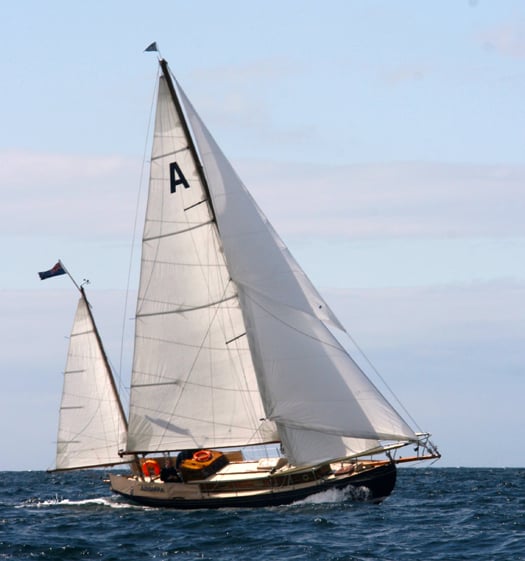
Dickie Gomes's 1912-built 36ft Ainmara from Strangford Lough showing the kind of performance which saw her retain the Leinster Trophy in Dublin Bay. Photo: Carol Laird
MAY 2014 – DICKIE GOMES
Dickie Gomes of Strangford Lough, who was Round Ireland Open Record Holder from 1986 to 1993, and was also the Round Ireland Race winner in 1988, was the Afloat.ie "Sailor of the Month" for May 2014, following his successful defence of the Leinster Trophy for veteran and classic boats in Dublin Bay. It was on the final day of May that the Gomes-owned, skippered and self-maintained 102-year-old 36ft yawl Ainmara swept across the sunlit waters of the bay to take line honours, and win the title on corrected time for the second year running, after a close-fought battle with Old Gaffers Association International President Sean Walsh's cutter Tir na nOg.
JUNE 2014 – ANTHONY O'LEARY
Top Cork skipper Anthony O'Leary's success in achieving the overall title in the British Open IRC Championship made him the runaway winner of Afloat.ie's "Sailor of the Month" title for June.
O'Leary's dedication in campaigning his veteran Ker 39 Antix is a by-word for enthusiasm in Irish and international sailing. Allied to his long-proven skill in getting that vital extra ounce of performance from boat and crew, the result was a prodigious record of success throughout 2014, culminating in a comprehensive victory for Ireland in the Commodore's Cup at the end of July. Then for O'Leary personally it got even better, as he went on to win both the Helmsmans Championship and the 1720 Nationals in September, while in November his beloved Antix was declared the RORC "Yacht of the Year"

Quokka, chartered by Michael Boyd and Niall Dowling, was a consistent contributor to the three-boat Irish team's winning points total in the Brewin Dolphin Commodore's Cup 2014. Photo: Rick Tomlinson
JULY 2014 INTERNATIONAL AWARD – THE COMMODORE'S CUP TEAM
It was a busy and successful sailing season for Irish crews at home and abroad, but one team achievement stood above all others in setting the tone for the year. Ireland's runaway victory in the international and multi-faceted Brewin Dolphin Commodore's Cup series from July 20th to 26th raised the mood of the nation in a very encouraging way. And while many were involved, there is no doubt that one man, the Team Captain Anthony O'Leary of Cork, was head and shoulders above all others in making the primary contribution.
JULY 2014 – SEAFRA GUILFOYLE
The Royal Cork Yacht Club's Cup of Success was running over in July, as the Commodore's Cup victory followed on to a Silver Medal at the ISAF Worlds for 18-year-old Seafra Guilfoyle of Crosshaven, who became the Afloat.ie "Sailor of the Month".
Racing in the boys Laser Radials at the Youth Worlds at Tavira on the Algarve in Portugal from July 14th to 20th, by the last day Guilfoyle was certain of a medal, with the final race to decide which one. As it happened, he came tantalisingly close to Gold, but the Silver amounted to a personal best

Seafra Guilfoye in Silver Medal style

On their way - Lula Belle streaks eastward up the English Channel in the early stages of the Round Britain and Ireland Race. Photo: Rick Tomlinson
AUGUST 2014 SAILORS OF THE MONTH – LIAM COYNE & BRIAN FLAHIVE
Liam Coyne of Dun Laoghaire and Brian Flahive of Wicklow were the Afloat.ie "Sailors of the Month" for August 2014, following their stunning and comprehensive success in the 1,802 mile RORC SevenStar Round Britain & Ireland Race. In it, with the standard First 36.7 Lula Belle, they topped the Two-Handed Division, won two of the RORC classes against opposition which included fully-crewed boats, and finished sixth overall in a fleet in which the results were otherwise dominated by much bigger boats with a large professional element in their crews. In fact, some of the crews were wholly professional. But the two Irish amateurs not only did the race out of their own time and resources, but they had to be their own shore management and technical support team as well.
SEPTEMBER 2014 – HAL BLEAKLEY
On Saturday 27th September, Hal Bleakley quietly retired from a lifetime of service to yacht racing, standing down after his final day as Race Officer for Dublin Bay Sailing Club in the last race of the summer programme in the Club's 130th year of playing a key role in the bay. Hal Bleakley personifies all that is best in DBSC, and indeed in Irish sailing and the maritime community generally. He got steadily on with the job with hours, days and weeks of often voluntary effort, and it was usually done quietly in the background, for that was Hal's way. In his working life, he was a leading figure in technical management and general administration in Ireland's aviation industry from 1959 to 2000, and he brought the high standards of his profession to his many interests afloat.

Hal Bleakley's calm and competent presence contributes greatly to the smooth running of Irish sailing. Photo: David Branigan
OCTOBER 2014 – BARRY HURLEY
Barry Hurley, who learnt his sailing on Cork Harbour out of Cobh, is best known as a star of the short-handed offshore racing scene. But in recent years he has been carving a formidable reputation as a team co-ordinator on board fully-crewed boats, and October 2014's 606-mile Middle Sea Race out of Malta against a record fleet of more than 120 boats was an outstanding achievement for him. In a central role aboard Josef Schultheis's Xp44 XpAct, Hurley and his shipmates took first in class on IRC and ORC, and second overall in both IRC and ORC. It was his tenth Rolex Middle Sea Race, and it was aboard a boat which as always was immaculately presented, while the gathering of crew from far and wide for XpAct resulted in ten very experienced sailors from five different countries, with four of them from Ireland, coming together in Malta a week before the start to finalise an outstanding challenge.
{youtube}uYRM5sFjahg{/youtube}
NOVEMBER – JUSTIN SLATTERY
Successes in the first two races of the current Volvo Ocean global contest placed Justin Slattery in an unassailable position as our Sailor of the Month for November. Completely absorbed in his fifth world race which is itself a record for an Irish sailor (and he won in 2005-06 with ABN Amro), Slattery has had the satisfaction of seeing his Abu Dhabi team justify his feeling that on the previous circuit three years ago, they were hampered by a slow boat. With the current race of 2014-2015 in a fleet of Farr-designed one–design Volvo 65s although Abu Dhabi - skippered by Ian Walker - was not necessarily always in the lead on the first leg from Alicante to Cape Town, she was ahead when it mattered at the finish. And with the entire fleet of one–designs racing within the same closely defined area of water for theCape Town inshore event, she showed the quality and depth of her style with another win. In the thick of it all, Justin Slattery was in his usual key roles in a multi-functional position - he can be bowman, trimmer or helmsman. Born in Cork with a boyhood in Wexford, Justin Slattery (40) is one of many Irish sailors who took his first proper steps afloat with Eddie English on Cork Harbour, and his early experiences still stand well to him.
DECEMBER – ANDY JOHNSTON
Sutton Dinghy Club on the north shore of Dublin Bay has been a pace-setter in the revival of Irish dinghy racing and club activity generally during 2014. Commodore Andy Johnston led his members through an outstanding season in which they were once again making an impact at national and international level, while the club's training programme and sailing school under the direction of Hugh Gill was highly effective in bringing newcomers to the sport, and building up a strong esprit de corps among its dedicated team of young instructors. In addition to success in open dinghy events at all levels, SDC succeeded in regaining the historic Book Trophy for team racing from Royal Cork Yacht Club. The trophy dates back to 1944, but for the past sixteen years the sailors of Crosshaven had kept it firmly in their grasp. 2014 also marked the 75th Anniversary of the foundation of the club at its homely base beside Sutton Creek, so the concluding highlight of the year was a 75th Anniversary Gala Dinner in mid-November in the club's home-from-home, the popular Marine Hotel at Sutton Cross. A remarkable total of 204 well-wishers and people who have distinguished sailing connections with Sutton DC from way back attended. It was Ciara O'Tiarnaigh and her Organising Committee who looked after the nuts and bolts of this star-studded event, but throughout a long and very special season, it was Andy Johnston who led the way and held the ultimate responsibility. Nevertheless, in making him our Sailor of the Month for December 2014, we are saluting the spirit of Sutton Dinghy Club, and the resilience of all Irish dinghy sailing.
Help us decide...
As in previous years, Afloat magazine is asking the public to help decide who should be crowned Ireland's Sailor of the Year for 2014.
VOTE BY SCROLLING DOWN TO THE BOTTOM OF THIS PAGE!
The overall national award will be presented to the person who, in the judges' opinion, achieved the most notable results in, or made the most significant contribution to Irish sailing during 2014.
The boating public gets to nominate their top three through the online poll, Afloat.ie gets a vote too and the Sailor of the Year judges decide the final winner.
The awards are administered and judged by Afloat magazine.
The 2014 Sailor of the Year will be named early in March at a joint presentation by Afloat and the Irish Sailing Association (ISA).
The judges' decision is final and no correspondence will be entered into.
Thanks for your interest!
2015 Sailing Calendar Includes Two Bicentenaries & Ireland's Biggest Regatta At Dun Laoghaire
Irishsailing – After the remarkable across-the-board success of the 2014 Irish sailing season, 2015 will have to be very special indeed to be remembered with such enthusiasm. But it's a special year in any case, as two major sailing Bicentenaries – one in the Irish Sea, the other in the Solent – will have added and poignant meaning, as the Centenaries a hundred years ago could not be celebrated because of the First World War.
As for Irish sailing generally, life moves on, there are new sailors on the water, successful young sailors are graduating to the next stage of their rapidly developing careers, and established stars continue to plan fresh campaigns, for sailing is indeed a sport for life.
Then too, new fixtures successfully introduced in 2014 will require nurturing, tuning and encouragement if they are to fulfil their potential in the coming year, while at the same time there's always extra effort needed to give proper support to established fixtures, which have to live with the reality that they might wilt through being taken for granted. Both new and longer-established boat classes will need continued enthusiastic involvement, and our well-loved classics and traditional craft must be cherished and sailed, for lack of use is the real enemy of boats, whether old or new.
As for the major administrative initiatives introduced in 2014, they will need constant monitoring, but deserve full support from the sailing and boating community at large, for it was in response to a grass-roots initiative that the radical and very necessary reforms of the Irish Sailing Association were undertaken. Those appointed to undertake the root-and-branch reform of the national authority have done so with commendable dispatch, so it is now the duty of the rest of us to support their continuing efforts. And we can best do that by enjoying our boats and our sailing and time afloat in its myriad of interests, while encouraging others to do the same. W M Nixon outlines on what the coming year may bring.
One thing at least is certain for the coming season afloat during 2015 in most of Europe. It will not mark any significant sailing Centenaries. Instead, we are immersed in four years of remembering the Great War of 1914-1918 a hundred years on, with all the added twists of that period's longer historical narrative in Ireland. In such a context, it may seem frivolous to point out that sports like yachting have no great Centenaries to mark at all in 2015. But this minor off-screen fact is a reminder of the all-involving horror and obscenity of total warfare on an industrial scale. It obliterated anything like normal life.
Yet as recreational sailing had been going on in some sort of organised form for hundreds of years – albeit in a fairly rudimentary way in its earliest years in the 16th Century – there may well have been several important dates to be marked during the time of the Great War itself, but they were allowed to pass as there was no sport afloat, while civilian life ashore was very subdued.
And in Ireland, with the Troubles persisting for four years after the end of the Great War until 1922, the Bicentenary of the Royal Cork Yacht Club in 1920 was to be a muted affair – the official History of the Royal Cork Yacht Club (published 2005) tells us: "Plans for a special dinner to celebrate the club's bicentenary in 1920 had to be cancelled, probably because of the disturbed conditions in the country"
So the idea of celebrating the Centenary of the Royal Yacht Squadron in Cowes in 1915 at the height of the international war - other than in a rather solemn shorebound way - would have been unthinkable. But that in turn fuels the celebrations when the peacefulgood times roll again. Thus the Royal Cork Yacht Club, having been unable to celebrate its Bicentenary in 1920, went on to have a fabulous two-year Quarter Millennium celebration in 1969-70. And as the RYS couldn't have a proper party in 1915, there's no doubt that the up-coming Bicentenary in 2015 will be the nucleus of international sailing's megafest-of-the-year.
There are of course several clubs which pre-dated the Squadron when it was founded in 1815. And there are many whose members outshine the small membership of the RYS in the breadth and energy of their sailing. But for 2015, let's just acknowledge that the prestigious Squadron has been at the heart of sailing history for a very long time, while their clubhouse's location right on the Solent at Cowes is so central that when any great Solent-related events are under way, the Squadron is in the middle of the story.
Thus it was on the Squadron lawn that in July that the Irish team celebrated their epic Commodore's Cup victory at the end of July 2014. And it will be towards the Squadron and its Bicentenary that the fleet will be racing in 2015's west-east Transatlantic Race. And then it will be the firing of the cannons from the historic Squadron battery which will signal the start of the 46th Fastnet Race on 16th August 2015.
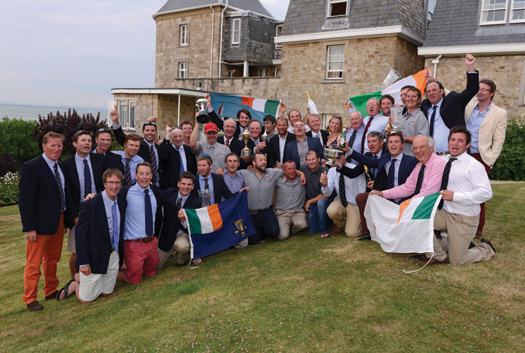
Party time at the Royal Yacht Squadron – the Irish team and their management gather to celebrate victory in the Commodore's Cup at the Squadron Castle in Cowes on August 1st 2014
There'll be many Irish boats involved, and the best-placed of them at the finish will be the winner of the Gull Salver, currently held by Martin Breen's Reflex 38 Lynx from Galway Bay SC, which was skippered to success by Aodhan FitzGerald in 2013's race. It's a coveted trophy, instituted to honour the memory of Harry Donegan of Cork and his famous cutter Gull, which was one of seven boats which inaugurated the Fastnet Race in 1925, and placed third. Since then, Irish Fastneteers have frequently been in the great race's top places, and best of all was in 2007 when Ger O'Rourke's Cookson 50 Chieftain out of Kilrush, sailing under the burgee of the revived Royal Western of Ireland YC, came sweeping in to the finish line at Plymouth to win the Fastnet Race
overall.
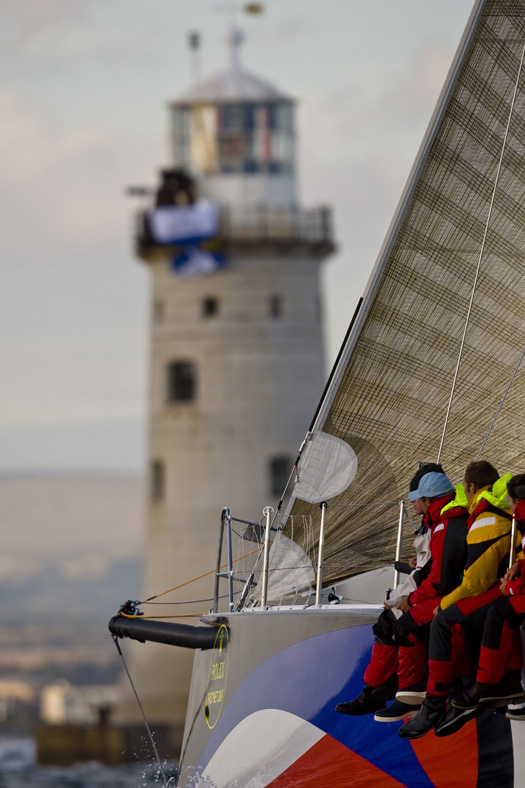
One of the greatest moments in Irish sailing history – Ger O'Rourke's Chieftain sweeps towards the finish line to become the overall winner of the Rolex Fastnet Race 2007. Photo: Rolex
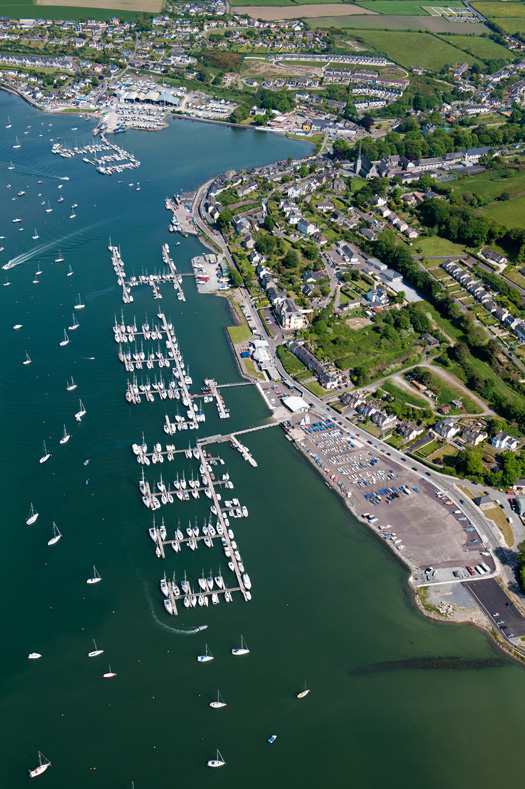
Just the spot for a great Tricentenary celebration - the very complete sailing facilities provided jointly by the Royal Cork Yacht Club and Crosshaven will become a world focus in 2020 with the Club's 300th anniversary. Photo: Bob Bateman
The realisation that 2015 sees this significant RYS Bicentenary is a timely reminder that the Royal Cork's Tricentenary is only five years down the line. They're five years which will be gone in a flash, and already behind-the-scenes moves are afoot to ensure that the national sailing programme will properly facilitate the extraordinary anniversary being celebrated in Crosshaven in 2020.
But meanwhile other Irish sailing centres have their own regular programmes to operate in the intervening four years, and in terms of numbers and scale there's no doubt the top event in Ireland in 2015 will be the biennial Volvo Dun Laoghaire Regatta from 9th to 12th July.
Anyone – and there were many - who took part in this unique "suburban sailfest" in 2013 will know that the VDLR has come of age. It's an event which is comfortable with itself while at the same time being always in development and evolution mode. Each staging of this remarkable Dublin Bay happening sees lessons being learnt and implemented even while the multi-class racing is under way on several courses. And in the two year gap before the next staging, the experience gained is closely analysed and the programme refined to further improve the sport in every area.
You get some idea of the sheer depth of racing experience in Dun Laoghaire by noting that the Chairman of the 2015 Committee is Tim Goodbody, with Martin Byrne as Vice Chairman while the Race Director is Con Murphy. And those three sailing megastars are just the peak of a mountain of race administration experience which is being drawn in from all over Ireland to ensure that the fleet of 400-plus boats gets the best sport possible.
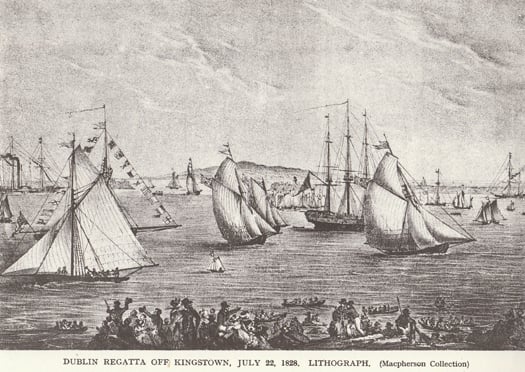
The first regatta in 1828 at the new harbour at Dun Laoghaire, which will be the setting for Ireland's biggest event in 2015, the Volvo Dun Laoghaire Regatta from 9th to 12th July.
While there'll be keenly participating boats from all over Ireland as well as Scotland, England and Wales, the setup of Dublin Bay being right on the city's doorstep means that it's the locals who would pose an administrative problem for a less experienced team. As the dates for the VDLR approached in 2013, the weather forecast steadily improved, and thanks to the Regatta's "extra long weekend" format, the sudden arrival of summer meant that a host of boats from the greater Dublin area came in as last minute entries, their owners and crews managing to scrape the extra day-and-a-half needed off work. It's a scenario which would put an overstretched administration off course, but the VDLR team took it calmly in their stride, and the result was a successful summer festival of sunlit sails and great sport, with maybe two thousand taking part.
This year there's a more structured cross-channel involvement, as the venerable Royal Dee YC in Cheshire has leapt to life to celebrate its Bicentenary. Founded as the Dee Yacht Club in 1815 with the end of the Napoleonic Wars, it didn't get the Royal seal until 1947, but nevertheless claims to be older than the RYS. With growing fleets in North Wales and the Mersey, it has put together a Bicentennial Royal Dee Irish Sea Offshore Championship linked closely to ISORA, which will bring the fleet across to Ireland to take in four offshore day races sailed as part of VDLR 2015.
Irish National Championships which will be part of the VDLR 2015 programme include the J/109s, the RS Elites, the Beneteau First 21s, and the Wayfarers, while the Leinster GP 14 Championship is also included as an integral part of the Regatta.
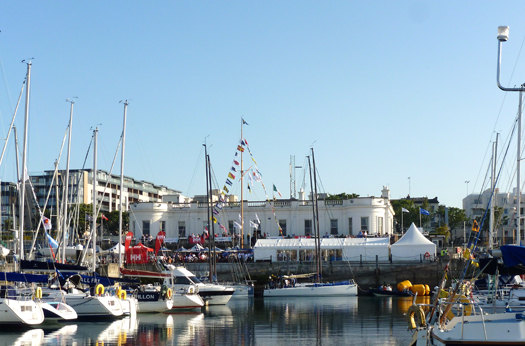
Party time in Dun Laoghaire – the Royal Irish YC during VDLR 2013. Photo: W M Nixon
As for Ireland's classic clinker-built vintage classes, one of the pleasantest surprises in VDLR 2013 was the large turnout of Mermaids, which had superb racing on the course area in the northwest corner of Dublin Bay. Despite having been born as the Dublin Bay SC Mermaid in 1932, this class of 17ft super-dinghies is no longer included in the regular DBSC programme owing to shortage of numbers for weekly turnouts. But it seems that as far as the VDLR is concerned, the Mermaid is now an event boat, and the fleets still thriving at other centres, together with some of the dormant Dublin Bay craft, bestirred themselves for the four days to enjoy good sailing for more than three dozen boats, something which is highly likely to be repeated in 2015.
The even more venerable Water Wags, founded 1887 with the current boats dating from 1903, continue to thrive in Dun Laoghaire, and the word is they expect to have at least twenty boats in action, while another wooden classic, the Mylne-designed 25ft Glen keelboat, is 50 years and more in Dun Laoghaire, and looks forward to having at least twelve boats racing in 2015.
All these specialized and historic classes are in addition to the numerous cruiser-racers which continue to be the backbone of Dublin Bay sailing. And while many of them will see the VDLR 2015 as a highlight of the year, in turning to consider the overall national programme, we find a sport which is shaking off economic recession to get on with an extraordinary plethora of local, national and international sailing events.
The problem is that most events of significance hope to locate themselves in the peak sailing period from late May to early September, so clashes are almost inevitable, and if you're interested in several different kinds of sailing, the overall choices can be bewildering in their complexity and logistical challenges.
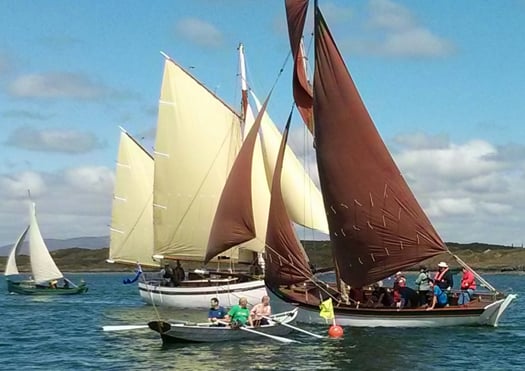
The Baltimore Wooden Boat Festival attracts an eclectic fleet – included here are a Shannon Gandelow, a West Cork Mackerel Yawl, the ketch Sile a Do, and an Heir Island Lobster Yawl (left).
For instance, the variety of events now available for the traditional and classic boats – usually but not necessarily under the Old Gaffer umbrella – would keep anyone busy for most of the summer. It starts with the Baltimore Wooden Boat & Seafood Festival from Friday 22nd May to Sunday 24th May, which you'd think very early
in the season for someone faced with fitting out an old wooden boat in Ireland's climate, but somehow they do it.
Then on the East Coast for the early summer Bank Holiday Weekend from May 29th to June 2nd, there's the Old Gaffer gathering in Dublin Bay at Poolbeg Y&BC with the annual race for the Leinster Trophy in the bay on Saturday May 30th, the event then morphs into the Dublin Port Riverfest in the Liffey on Sunday May 31st, and finally it all concludes with the race for the Asgard Trophy back in the bay on Monday June 1st.
The annual Lambay Race at Howth, a regular fixture since 1904, has seen its course becoming increasingly complex in modern times in order to satisfy the desire of modern racers for competition on every possible point of sailing. But in 2014, to celebrate the Centenary of the Lynch family's Echo, the venerable Howth Seventeens were sent on the traditional course north from Howth Harbour through the sound inside Ireland's Eye, then on round Lambay leaving it to port, and then back south inside Ireland's Eye again to the finish at Howth pierheads.
This was such an attractive proposition for Old Gaffers and Seventeens alike that on the day an extra Classics Division was added to cater for ancient craft, and it hit the spot. This option will be offered again for 2015's Lambay Race (it's on Saturday June 6th), and the word is that Dickie Gomes's 1912-built 36ft yawl Ainmara will be coming down from Strangford Lough to defend her title after 94 years. 94 years? Yes indeed - she won the Lambay Race in spectacular style in 1921 when still under the ownership of her designer-builder John B Kearney.
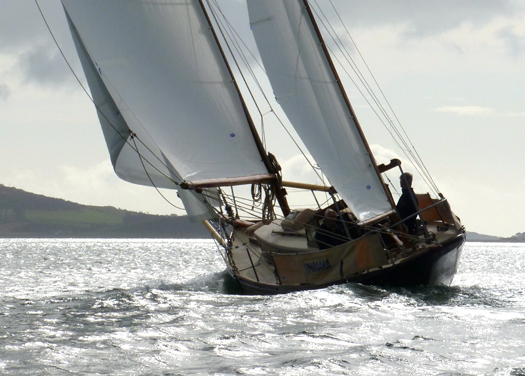
After 94 years, Dickie Gomes's 36ft 1912-built yawl Ainmara (seen here on her home waters of Strangford Lough) hopes to return to defend the title in Howth's Lambay Race, which Ainmara won in 1921 while still in the ownership of her designer-builder John B Kearney. Photo: W M Nixon
The Old Gaffers attention then swings north as the Tall Ships are coming to Belfast from Thursday 2nd July to Sunday 5th July. This is going to be a serious biggie with those ships already signed up including a significant turnout of Class A vessels, which are square riggers and others of more than 40 metres in length. Belfast Lough lends itself particularly well to the Parade of Sail which follows a Tall Ships gathering, and in 2009 when they were last in the port they put in in a virtuoso display with the Dutch ship Europa in particular going to the trouble of getting herself over towards Whiteabbey in the northwest corner of the lough to allow her time get every stitch of sail set before proceeding seawards down-lough in colossal style, a much more impressive display than we've become accustomed to in Dublin, where the shape of Dublin Bay is such that it doesn't really provide the space for square riggers to set all cloth before getting out to sea.
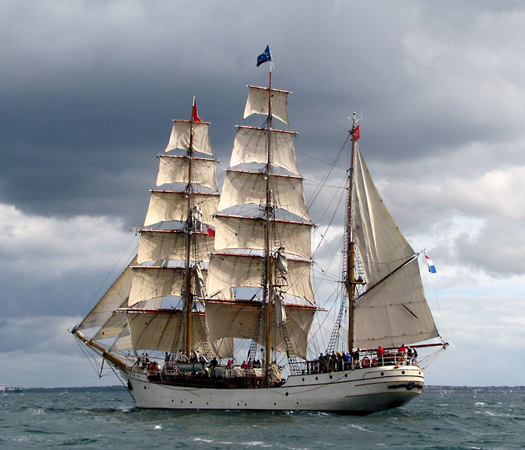
The Tall Ship Europa shows how it should be done in Belfast Lough in 2009, taking time out to set full sail before she starts to gather power to make the proper input into the Parade of Sail.
Like Dublin, Belfast has shown it can be hospitable to Old Gaffers, and it was a very welcoming main port during the OGA Golden Jubilee Cruise-in-Company in 2013, so for 2015 the OGA National President Sean Walsh hopes to up the ante by persuading his members from all round the Irish Sea to gather in Belfast, and to add spice to the mix, he hopes to persuade the Howth 17s to put in an appearance as well, to sail with local one designs like the 1903 Belfast Lough Waverley Class, which have been experiencing a revival in recent years.

Old Gaffers in Belfast for their Golden Jubilee in 2013. The Irish Sea classic and traditional fleet will return to the same venue for the Tall Ships gathering in July 2015. Photo: W M Nixon
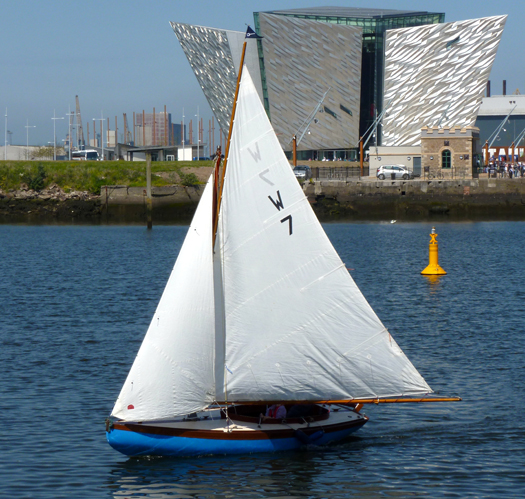
The Belfast Lough Waverley Class Lilias (built 1903) sailing at the Titanic Centre in Belfast. In 2015, the Waverleys will be joined by some of the 117-year-old Howth 17s to participate in the visit of the Tall Ships. Photo: W M Nixon
The Seventeens have made long treks as a class before – in 1998, five of them were road-trailed to Carrickfergus to mark the class's Centenary, with the first five boats built by Hilditch of Carrickfergus. So though they'd trailed there, they then sailed the 90 miles back to Howth, just as the first boats had done a hundred years earlier. Then in July 2003, fifteen of the Seventeens took part in the Glandore Classics Regatta thanks to a brilliantly organised exercise in logistics using a flotilla of low loaders which could take three boats apiece.
For all of Ireland's classic and traditional boats in 2015, and an international fleet too, Glandore is very much up on the radar again, as a special effort is being made by a GHYC team led by Donal Lynch to encourage increased numbers in the CH Marine Glandore Classic Regatta from Saturday July 18th through Friday July 24th. It's a date which certainly allows Old Gaffers plenty of time to get down from Belfast, indeed some may even consider the option of making the voyage northabout to take in a round Ireland cruise while they're at it. And as that great magnet of the Irish Sea classic and traditional scene, the Peel Traditional Boat Weekend, isn't until Friday 31st July to Sunday 2nd August, it's just about possible to factor that in as well.
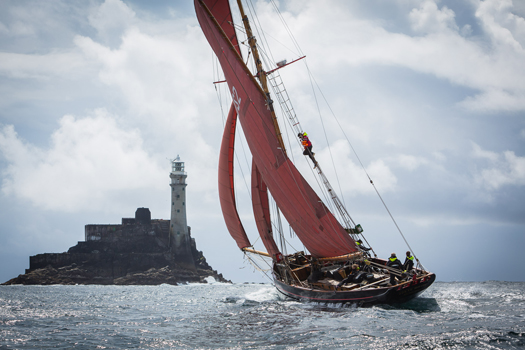
Everything happening at once – the famous Pilot Cutter Jolie Brise was the star of the Glandore Classics in 2013, and as it was her own Centenary she celebrated by sailing round the Fastnet Rock – she has been a successful Fastnet Race participant several times. Photo: Brian Carlin
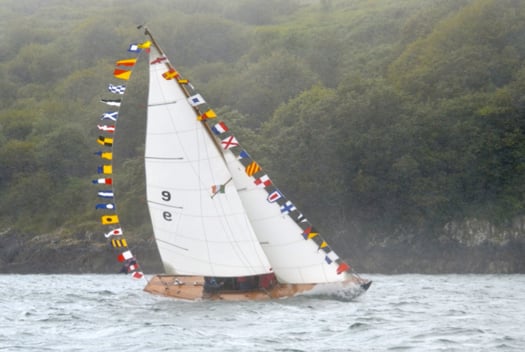
The Glandore Classics attracts an international fleet, and 2013's regatta included a class of Fife One Designs from the Menai Straits, all of them keen to party and showing it. 2015's Glandore Classics is from July 18th to 24th. Photo: Cormac O'Carroll
All this is already happening for the oldies with August barely under way, yet for modern cruiser-racers the potential programme for any keenly-sailed Irish boat is equally complex, attractive and challenging. The season starts as usual with the Scottish Series from Friday 23rd May to Monday 26th May – there'll probably still be snow on the mountains of Arran. They've gone back to their roots by starting with a feeder race from Gourock to the main regatta centre at Tarbert on Loch Fyne. "Going back to the roots" is something of a theme for this year's staging of the Clyde Cruising Club's main racing event, as this is the 40th Scottish Series. Come to think of it, there are so many important 40th anniversaries happening in sailing these days that we have the admit that the decade which brought us the full horror of wide lapels and flared trousers also contributed some lasting elements of the international sailing scene, indeed it could be said that the modern era in sailing really began about forty years ago.
Back in Ireland, the ISORA programme will be well under way by June, while the Lambay Race on June 6th can be looked at with more interest by several boats, as the biennial National YC Dun Laoghaire to Dingle Race doesn't start until Friday June 12th . Last time round, there was a total fixtures clash between the two events, but in times before that hyper-keen sailors such as the Tyrrells of Arklow with Aquelina have been able to fit in both, indeed one year they did it so well they won both too, and were rightly acclaimed as the Afloat "Sailors of the Month" for their success.
For 2015, defending champion in the Dingle Race is Brian O'Sullivan of Tralee with the veteran Oyster 37 Amazing Grace, which came good in the end in 2013 with a new breeze which knocked pending leader Antix (Anthony O'Leary) off the winning perch. But with the 2015 Dingle Race acting as a useful if rather indirect feeder for the Covestone Asset Management Sovereigns Cup in Kinsale from June 24th to 28th, there could be all sorts of sharp boats lining up to take the prize, for the Sovereigns Cup 2015 includes the all-singing all-dancing ICRA Nats 2015.

The welcoming port – Kinsale is one of Ireland's most popular destinations, and in 2015 its hosts the combined Sovereigns /ICRA Nationals from June 24th to 28th.

Perfect sailing – racing in the Sovereigns at Kinsale in June 2013. Photo: Bob Bateman
Yet the timing of the combined Sovereigns/ICRA Nats is such that there's still plenty of time and space to get back to the Irish Sea for the Volvo Dun Laoghaire Regatta 2015 from July 9th to 12th, a reminder that much of the cruiser-racer programme for 2015 is in a neatly balanced and user-friendly timescale for everyone except perhaps those who wish to do either the entire ISORA or SCORA programme as well, so the problem mostly is going to be getting time off work.
And for the hyper-keen cruiser-racers, particularly those whose boats are small enough to be conveniently trailerable, further temptation looms in 2015 with the WIORA Championship at Galway Bay Sailing Club from July 22nd to 25th. For the fleets in the Shannon, on Tralee Bay, and in Clew Bay, it's a bit more than a day's sail away, but they'll be there to challenge Liam Byrne of the home club who won it in 2014 with his Corby 25 Tribal at Mayo SC in Clew Bay, while some top boats from more distant centres are expecting to trail to Galway Bay to spice up the competition.
By this stage of the season a more relaxed pace might be welcome, but the lively turnout of 80 boats in 2014 for the new-style four day Cork Dry Gin Calves Week out of Schull in early August (Tuesday 4th to Friday 7th August in 2015) suggests that for racing sailors, the best relaxation is more racing, but in a holiday setting. And yes, it has been noted that a true West Corkian sailing nut could indeed do all of Calves Week 2015, and still be on the Squadron line for the start of the Fasnet Race nine days later.
For dinghies in 2015, the big story is the debut of the newest version of the National 18, and just how popular will the Bray-bult foiling Moths become, while established classes will frame their programmes to accommodate sailors whose time is limited, also having to fit in with a national scene where the number of Race Officers with the necessary skills is inevitably a finite amount.
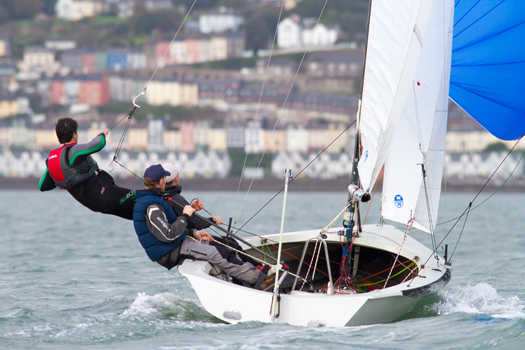
The big stories in Irish dinghy racing in 2015 will be the arrival of the new National 18s at Crosshaven, and the revival of Dinghy Week there in late August. Here, in the Autumn of 2013, To Dwyer and Nin O'Leary test sail the prototype of the new 18 on Cork Harbour. Photo: Bob Bateman
The new Third Generation (or maybe it's fourth or fifth generation) National 18 may have been designed in England by Phil Morrison, and is being built there too. But it was the very active Crosshaven fleet with the Royal Cork Yacht Club which led the charge towards a new boat, and when it came to stepping up to the plate to pay twelve substantial new boat deposits to move it all along after the prototype had been rigorously tested in Cork harbour last Autumn, it was the Crosshaven fleet that provided eight out of those twelve cheques.
So it's entirely appropriate that in August 2015, the dinghy focus will swing big time towards Crosshaven and a short form "Dinghy Week" from August 21st to 23rd. The old style Irish Dinghy Weeks – the last one was in 1970 – became victims of their own success, they just got too large. But the different classes became over-optimistic about their continuing individual growth prospects. Then the pendulum swung too far the other way, and dinghy classes were alone and their events shrinking. But a resurgence of club and championship dinghy sailing in Crosshaven during 2014, and a growing realization that over-reliance on single-handed dinghy classes does not necessarily produce a socially-adjusted national squad of junior sailors, resulted in some clear and creative thinking about developing two-handed boats, and reviving some old classes such as the Mirrors.
The form of this new Dinghy Week is still in the melting pot, but at least eight classes have responded with enthusiasm. Meanwhile, the National 18s in Crosshaven will be such a focus of interest during 2015 with the first of the new boats making their debut that we'll have a season-long dinghy narrative developing on Cork Harbour, and the revived Dinghy Week will be just part of it.
As for inshore keelboats, the big one in terms of number is the combined British and Irish Championship Squib Championship at Howth from 27th June to 3rd July. The handy little Squibs are something of an oddity, as they serve so well as a cherished local class in so many Irish sailing centres that many owners see them as that, and nothing more – handy little club sailors to be raced on home waters a couple of times a week.
This means that when a major regional or national event is held, the number taking part will often only be a fraction of the total Irish Squib fleet. But for those who do make the trek, the competition is fierce and the racing great – in Howth, the high point was in 1996, when this "Nationals" event attracted a fleet of exactly a hundred boats, and on one never-to-be-forgotten morning, there they were, every last one of them on the starting line.

A hundred Squibs all in a row at Howth on Tuesday July 25th 1996. Photo: Mandy Murnane
The most recent Squib event of national stature was the Freshwater Keelboat Regatta at Dromineer on Lough Derg on the weekend of October 18th-19th, and the battle for the top places was between the Kinsale and Belfast Lough fleets, with James Matthews and Rob Jacob of Kinsale rounding out their year in style with a good win.
But with the Squibs in England undergoing a revival – they were the second-biggest One Design fleet in Cowes Week 2014, bested only by the legendary XODs – there's no doubt there's a strong challenge coming across channel, and any Irish boat getting into the top ten will be doing well.
As for that annual Autumn Freshwater Keelboat Regatta at Dromineer, while it may have been much hampered by the spinoff from some ferocious weather out in the Atlantic with frustration for some of the sixty boats hoping to take part, it's an event of enormous potential, and the many who wish it well and have enjoyed it in the past will be ready and willing to do their part to make 2015's regatta a success.

The Squibs enjoying a lull in the strong winds during the Lough Derg Freshwater Regatta 2014. Overall winner was Mucky Duck (no 51, James Matthews & Rob Jacob, Kinsale YC). Photo: Gareth Craig
All these specialised and localized events planned for 2015 will be the continuing background music to the usual events of national sailing focus, everything from the selection of the Irish team for the Student Yachting Worlds to the Helmsmans Championships to the steady increase in pace while 2015 develops as the pre-Olympic year. As the year rolls along, other stories will develop too. So perhaps it's appropriate that we exit this review as we entered it. Just pause to remember now and again that, a hundred years ago, you simply couldn't have gone freely afloat like this for sport and recreation at all.
But we can't close on such a solemn note. Seasoned Solent sailors may have noted our header photo from Guido Cantini at the Panerai Classics Regatta was looking just slightly odd, for some reason difficult to pin down. Well, as it happens, the photo was sent to us back in September just as we were contemplating the excellent cleanup up done by Jason Hurley of Jason Hurley Design on the Mercedes-sponsored billboard photo of Howth 17s on the end wall of Howth Yacht Club. As with many photos taken over the RYS starting cannons, the Cantini pic included an obtrusive part of the Fawley Oil Refinery across on what Isle of Wight people call "the north island". Though Fawley has been there for yonks, it still has the look of a temporary structure. So we got Jason to treat as just that. But here for your edification is the true picture. You could get a taste for this sort of thing. What about brushing out Whitegate, lads? And as for Milford Haven.........
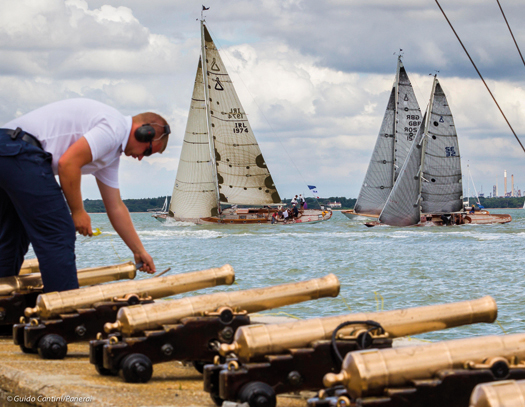
The unvarnished truth. In real life, the view from the RYS battery at Cowes can be slightly marred by the clutter of Fawley Refinery across the Solent on "the north island". Photo: Guido Cantini/Panerai
Read also: 2015 Irish Sailing Fixtures List (provisional)
Round Ireland Yacht Race – Where Next? What Next?
#roundireland – The biennial Round Ireland Race from Wicklow is the jewel in Ireland's offshore racing crown. It may only have been established as recently as 1980, but now it is a classic, part of the RORC programme, and an event which is very special for those who take part. In fact, for many Irish sailing folk, having at least one completed Round Ireland Race in your sailing CV is regarded as an essential experience for a well-rounded sailing life. Yet despite fleets pushing towards the 60 mark in the 1990s, even before the economic recession had started tobite the Round Ireland numbers were tailing off notwithstanding the injection of RORC support, and the more recent bonus of it carrying the same points weighting as the Fastnet Race itself. At a time when the basic Fastnet Race entry list of 350 boats is filled within six hours of entries opening for confirmation, and when the Middle Sea Race from Malta has confidently soared through the 120 mark, while the 70th Sydney-Hobart Race in seven weeks time will see at least a hundred entries, the Round Ireland Race fleet for 2014 was only 36 boats, of whom just 33 finished. W M NIXON wonders how, if at all, this situation can be improved.
"The Round Ireland Race is the greatest. Why don't more people know about it? Why aren't there at least a hundred top boats turning up every time it starts? It's a marvellous course. We had great sailing and great sport. Can somebody tell me why a genuine international offshore racing classic like this has been going on for 34 years, and yet in 2014 we see an entry of only three dozen boats?"
The speaker isn't just any ten-cents-for-my-opinion waterfront pundit. On the contrary, it's Scotsman Richard Harris, skipper and part-owner with his brother of the potent 1996 Sydney 36 Tanit, the overall winner of the Round Ireland Race 2014. And he's asking these questions as someone who has raced with success in both the Fastnet and Sydney-Hobart Races, and has campaigned his boat at the sharp end of the fleet with the RORC programme from the Solent, and in any worthwhile offshore racing he has managed to find in his home waters of Scotland.
Harris is getting into fine form, as we're at the Tanit table for Wicklow Sailing's Club's Round Ireland Prize-giving Dinner-Dance in the Grand Hotel in Wicklow town last Saturday night. With a boxload of trophies for Tanit to collect, anyone would be in exuberant spirits. But his views on the quality of the Round Ireland Race are clearly thought out and genuinely held, and he is enthusiastically supported by his navigator, Richie Fearon.
Fearon is the man to whom the Tanit crew give the lion's share of the credit for their success, which was achieved by just six minutes from Liam Shanahan's J/109 Ruth from the National YC in Dun Laoghaire. He was the only one in Tanit's crew who had done the race before, and in an all-Clyde lineup, his was the only Irish voice, as he sails from Lough Swilly YC in Donegal. His previous race was in 2010 with the Northern Ireland-based J/124 Bejaysus (Alan Hannon), which finished 7th overall. But for the Derry man, second time round made the course if anything even more interesting.
"You get a wonderful sense of the race progressing all the time, of moving along the course" says Fearon. "In the Fastnet, for instance, there are periods when you feel as though you're sailing in a sort of limbo. But in the Round Ireland, you're always shaping your course with the next rock or island or headland or wind change or tidal time in mind. There's a fascinating and challenging mix of strategy and tactics and navigation and pilotage, all of which results in one of the most interesting distance races in the world. They really should get more people to do it. It gives a wonderful feeling of achievement and completeness when you just finish the course. And it's even better if you do well, as we felt we'd done in 2010. But believe me, winning overall, and in a boat as interesting as this with a crew of guys as good and as friendly as this, that's the best of all!"
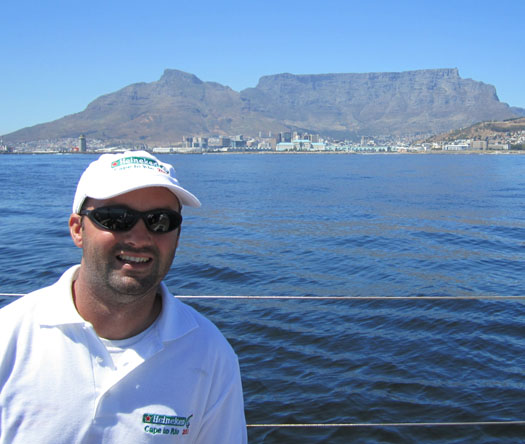
Richie Fearon of Lough Swilly YC, seen here kitted up off Cape Town for the Transatlantic race to Rio, navigated Tanit to the overall victory in the Round Ireland 2014
So how do you explain to such people, people who have become Round Ireland enthusiasts with all the zeal of recent converts, just why it is that Ireland's premier offshore event can barely attract a viable quorum when the yacht harbours of Europe are bursting with high-powered offshore racing boats which are constantly on the lookout for events worthy of their attention, not to mention commercial offshore racing schools and training programmes which need events like the Round Ireland Race to stay modestly in business?
How indeed, when we already have enough difficulty in explaining it all to ourselves. Inevitably, we have to look at the history, and the setting of that history. The last time I was at the Round Ireland Prize-Giving Dinner-Dance in Wicklow, there'd been enough participants from my home port of Howth in that year's race to make it worthwhile for us to hire a bus to go down through the Garden County for the party. We were in the midst of the Celtic Tiger years when people's expectations were becoming very pretentious, and I remember two foodies seated nearby in the bus pompously hoping to high heaven that the evening's meal wouldn't be the inevitable rural feast of beef or salmon.
But the charm of Wicklow town is that, though it's barely a forty minute drive from the capital, it is very much of the country - l'Irlande profonde as you might say. 'Tis far you are from big city notions of fancy menus to appeal to jaded metropolitan taste-buds. So it was indeed beef or salmon. Not that it really mattered that much to the crowd on the bus from Howth. They were well fuelled with on-board liquor by the time we got there, and the return journey in the small hours was made even longer by the need for frequent comfort stops, thus all they'd needed in the meal was absorbent food to mop up the booze.
Some things have changed greatly in the past few years, not least that there was so little Howth involvement in 2014's race that one very modest car would have done to get all the participants to last Saturday night's prize-giving dinner dance in Wicklow. But some things, thank goodness, don't change. It was still beef or salmon. And very good it was too, as salmon is excellent fish if you don't try to pretend that it's steak and grill it. That brings out its least attractive taste elements. But a baked darne of salmon with a well-judged sauce, such as we had last Saturday night, is a feast for a king. And I gathered the roast beef was very good too.
But it all reinforced the feeling that we were in the biggest hotel – the only hotel? - in a small Irish country town. Yet apart from the sailors at the night's event, there was nothing to suggest that Wicklow is a port, for there's something about the layout of the place which makes the harbour waterfront wellnigh invisible unless you seek it out. It's a delightful surprise when you do find it, but it's very much a little working port, rather than a natural focus for recreational boating and the biennial staging of one of the majorevents in the Irish sailing calendar.

You almost have to take to the air to see that Wicklow is a little port town, for as this photo reveals, the main street turns its back very decisively on the workaday harbour in the Vartry River.
It was back in 1980 that Michael Jones of Wicklow Sailing Club took up boating magazine publisher Norman Barry's challenge for some Irish boat or sailing club, any maritime-minded club at all, to stage a round Ireland race. Jones went for the idea, and Wicklow have been running it every other year ever since. It may be the jewel in Irish offshore sailing's crown. But in Wicklow's little sailing club, it is the entire crown, and just about everything else in the club's jewel and regalia box as well.
Whether or not this is good for the general development of sailing in Wicklow is a moot point, but that's neither here nor there for the moment. What matters is that as far as the growth and development of the Round Ireland Race is concerned, in the early days of the 1980s the fact that Wicklow was a basic little commercial and fishing port with only the most rudimentary berthing facilities for recreational boating didn't really matter all that much, as most other harbours in Ireland were no better.
In 1982, the great Denis Doyle of Cork decided to give the race his full support with his almost-new Frers 51 Moonduster. Denis was someone who strongly supported local rights and legitimate claims, and he reckoned that the fact that Wicklow Sailing Club had filled the Round Ireland Race void, when larger longer-established clubs of national standing had failed to step up to the plate, was something which should be properly respected. So in his many subsequent participations in the Round Ireland Race, Moonduster would arrive into Wicklow several days in advance of the start, she would be given an inner harbour quayside berth of honour in a place as tidy as it could be made in a port which seems to specialise in messy cargoes, and Denis and his wife Mary would take up residence in a nearby B & B and become Honorary Citizens of the town until each race was started and well on its way.
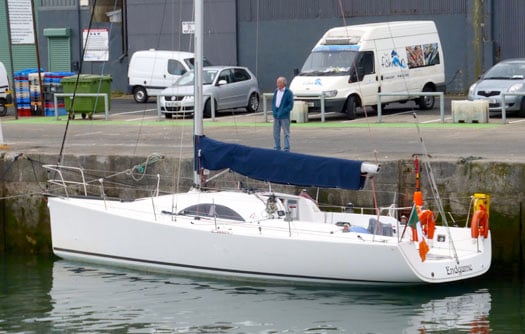
Like father, like son. Denis Doyle's son Frank's A35 Endgame from Crosshaven berthed in Wicklow waiting for the start of the Round Ireland Race 2014, in which she placed fourth overall and was a member of the winning team for the Kinsale YC Trophy. Photo: W M Nixon
It was an attitude which they brought to every venue where Moonduster was raced. The Doyles believed passionately that boosting the local economy should be something that ought to be a priority in any major sailing happening, wherever it might be staged. Denis had been doing the biennial Fastnet regularly for many years before he took up the Round Ireland race as well, and for a longtime beforehand he and Mary had also had the Honorary Citizen status in Cowes, as he would make a job of doing Cowes Week beforehand, living in digs in the town, while at race's end in Plymouth, there'd be a local commitment as well, albeit on a smaller scale.
This was all very well for Wicklow and the Round Ireland in the circumstance of the 1980s, but by the 1990s other ports were developing marinas and providing convenient facilities, yet Wicklow stubbornly stayed its own friendly but inconvenient self. When we look at the geography of the harbour, we can see why, and see all sorts of things that might have been done differently a very long time go.
For instance, when the Vikings were first invading and intent on making Wicklow one of their key ports, it could have been developed in a much more useful way if only the native Irish had made them welcome. Can't you just see it? "We'll overlook the rape and pillage for now, lads, these guys represent substantial inward investment". Just so. Had there been that far-sighted attitude, the locals could have invited the men in the longships to come on up the River Vartry, and into the magnificent expanse of the Broad Lough. What a marvellous vision that would have revealed. With some minor rock removal and a little bit of dredging in the entrance, it could be a wonderful extensive natural harbour in a beautiful setting. Had that happened, just think how differently the facilities of modern Wicklow harbour might now be.
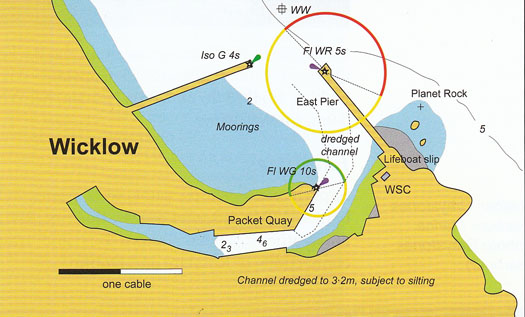
The navigable part of Wicklow Port as it is today. The water does not really come to a sudden straight-line stop as shown on the left – that's just the bridge. Plan courtesy Irish Cruising Club
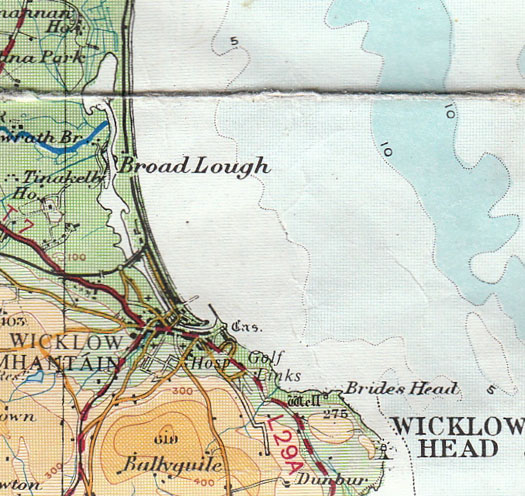
The bigger picture. Had the Vikings not been stopped such that they had to establish their settlement at the mouth of the Vartry River, they might have been able to create a much larger harbour settlement further in around the shores of the Broad Lough, with obvious advantages for Wicklow Port as it might have become today
Instead, the Vikings struggled ashore on the first available landing place at the first bend of the river, and established a beach-head which became such a successful little fort that eventually they were able to burn their boats. But by thattime, they were totally committed to having Wicklow town in its present cramped location. Access to the Broad Lough at high water (there's a very modest tidal range tidal) was soon restricted by the bridge, and then other river crossings, such that today nobody thinks of it as a potential harbour at all, if they ever did.
But meanwhile the current inner harbour is a cramped and dirty river which seems to be ignored by the town as much as possible, such that even the Bridge Tavern, the birthplace of Wicklow's most famous seafarer, Captain Robert Halpin of SS Great Eastern and trans-oceanic cable laying fame, turns its back firmly on the port. And as for the outer harbour, while it's a delightful place on a summer's day, it is not a serious proposition for berthing a large fleet of boats preparing for a major 704-mile offshore race, but people have to make do with it as best they can.
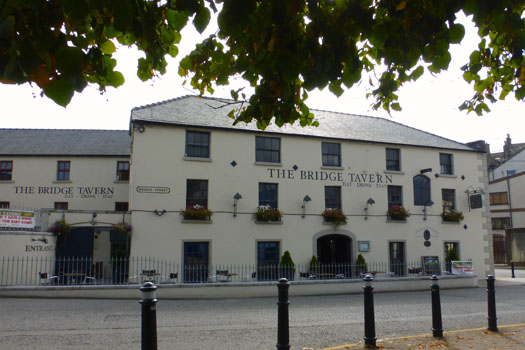
Despite being the birthplace of the most famous Wicklow seafarer, Captain Robert Halpin, the Bridge Tavern turns its back on the harbour. Photo: W M Nixon
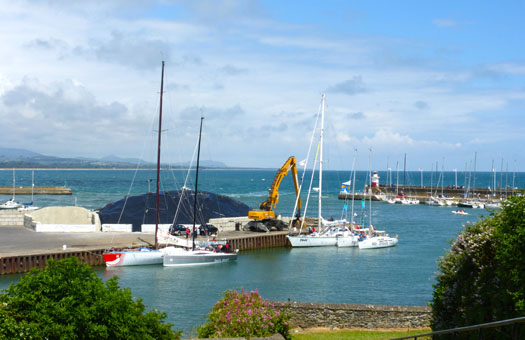
Wicklow's Outer Harbour on the morning of the Round Ireland race 2014 is a lovely sunny spot..............Photo: W M Nixon
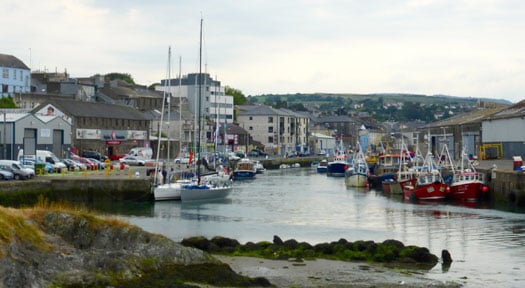
....but it is the inner harbour, shared with fishing and other commercial craft and assorted non-maritime quayside businesses, which will shelter the fleet preparing for the Round Ireland Race. Photo: W M Nixon
It was in the 1990s when the Round Ireland fleet was at its peak that the problems with the harbour's limited facilities were at their most acute, and it may be dormant memories of those difficult conditions which contribute to today's shortage of enthusiasm for the race. Back in the 1990s, the average cruiser-racer was not kitted out as a matter of course to RORC requirements, thus those undergoing their first scrutiny in order to be allowed to race round Ireland had to get to Wicklow several days in advance, and then often spendmoney like water to get up to scratch, the necessary bits and pieces being supplied by chandlers' vans parked on the quay.
It was crazy, not unlike a waterfront version of Ballinasloe Horse Fair - all that was missing was Madame Zara in her shiny caravan giving out nautical horoscopes in sepulchral tones for the wannabe Ireland circumnavigators. Perhaps she was there, but the two times I was going through the process with my own boat, it was so hectic I wouldn't have noticed. All I wanted to do was get to sea and away on the race, and get the filth of Wicklow harbour washed off the boat as soon as possible, as we'd drawn the short straw and had been berthed right in against the quay, so everyone has used our boat as a 35ft doormat on their way across to their own craft.
But the finish of the race at Wicklow – now that was and is completely different. The place seems to have transformed itself while you've been away bashing through sundry waters and a lot of the Atlantic in the intervening five days. Everyone is feeling like a million dollars, and Wicklow seems the only proper place in the whole wide world to finish a major offshore race. And as for the Round Ireland Prize Giving Dinner Dance, the venue of the Grand Hotel and beef or salmon for the meal is all part of the formula, it's central to the mystique of this extraordinary event.
In the days of the big entries with massive sponsorship from Cork Dry Gin, the prize-giving was Dublin-centred even if the race had started and finished in Wicklow. And the big bash in the city would start with a huge reception leading on into a gala dinner (I don't remember much dancing) in a glitzy Dublin hotel. In truth, it seemed a bit remote from little boats making their ways alone or in ones and twos back into Wicklow after the profoundly moving experience of racing right round our home island.
By the time you'd done all that, only others who have done the same could truly share your feelings about the experience. Big parties in anonymous city hotels were not the ideal setting for the Autumnal prize-giving and de-briefing. Thus the contemporary final hassle of getting down to Wicklow for the Round Ireland Dinner on a black November night in a veritable deluge of a downpour could be seen as the last stage of a long weeding-out process.
But once you're into the Grand Hotel and the party is under way, it's magic and the camaraderie really is quite something. Old rivalries and grievances fade away. It is also, to a remarkable extent, a family gathering – the number of family crews involved is surely exceptional. And the tone of it for 2014 is set by the presence of the winner of the KYC Trophy for the best three boat team, for the winners had as their top-placed boat the A35 Endgame, fourth overall and owner-skippered by Frank Doyle RCYC, son of Denis and Mary Doyle.
However, inevitably the status of the race and its future development and expansion is something which just won't go away. Any doubts about its importance were soon dispelled by considering the special guests at the dinner, as they included the President of the Irish Sailing Association David Lovegrove, the Vice Commodore of the Royal Ocean Racing Club Michael Boyd of the RIYC, and the Commodore of the Royal Irish Yacht Club, Jim Horan, whose club in 2014 was for the first time in association with Wicklow Sailing Club on the Round Ireland Race. The RIYC acted as hosting club in Dun Laoghaire for visiting boats which didn't want to go on down to Wicklow until shortly before the start, but wished toavail of modern marina facilities and the amenities of a large sailing port in the meantime.
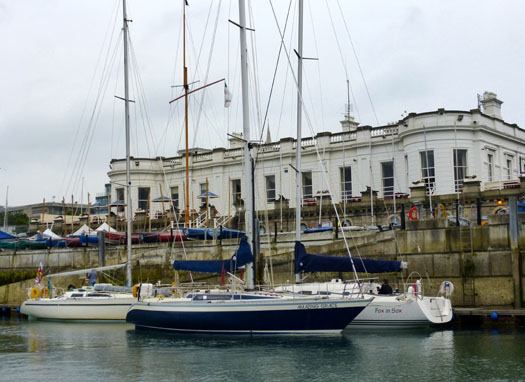
The switched-on crews going to Dun Laoghaire before the start of the Round Ireland Race 2014 knew that the best approach was to make themselves known at the Royal Irish YC and get a berth there, instead of allowing their boats to be banished to the "Siberia" of Dun Laoghaire Marina's remote visitors berths. Photo includes the MG38 McGregor IV from Essex which finished tenth overall (left), and the Oyster 37 Amazing Grace from Kerry, which had been in the frame but was forced to retire with equipment failure. Photo: W M Nixon
It was a partnership with potential, but it will need to be worked on. For although boats from other parts of Ireland knew that on arrival in Dun Laoghaire the secret of being well looked after was to make your number directly with the RIYC, boats from further afield coming into Dublin Bay tended to contact the marina, and thus they were stuck into Dun Laoghaire Marina's absurd visitors' berths, which are right at the very outer end of the pontoons, way out beyond acres of currently empty berths, such that it's said that anyone on them is one whole kilometre's walk from dry land.
Before the Round Ireland Race, the eventual winner Tanit was brought up from the Solent to Dun Laoghaire by a delivery crew who contacted the Marina Office, and she was stuck out in the Siberia of those Visitors Berths. It did mean that when she was first properly seen in Wicklow Harbour on the morning of the race, her impact as clearly an extremely attractive and very sound all round boat was all the greater. But nevertheless, if that is Dun Laoghaire Marina's idea of making visitors welcome, then they need to do something of a reality check, and it was a telling reminder that many Dun Laoghaire and Dublin Bay sailors are so absorbed in their own clearly defined and time-controlled activities afloatthat it leaves them with only limited attention for events outside their own sphere of interest.
As for Dun Laoghaire's general public, is there any interest at all? If the start of the Round Ireland Race was shifted to Dun Laoghaire, as some suggest, do you think the vast majority of the locals would take a blind bit of notice? At least in Wicklow they do make a bit of a fuss on the day of the start, with a community-sponsored fireworks display the night before.
In a final twist, in setting up the new Wicklow-Dun Laoghaire relationship, nobody had thought of the Greystones factor. Most had been unaware that the new Greystones marina is unexpectedly very deep. But such is the case, as I learned on Saturday night from the man from Newstalk. It's one of the reasons it cost the earth to build the little place. But it did mean that, in the buildup to the Round Ireland Race, while two of the deepest boats, the Volvo 70 Monster Project chartered by Wicklow's "Farmer" David Ryan, and the Farr 60 Newstalk, were unwilling to berth in Wicklow itself, they'd only to go a few miles north to find a handy berth in Greystones, where they were still very much in Wicklow county. There, they were the focus of much attention. For as we've discovered at Afloat.ie, if we lead a story #greystones, the level of interest is amazing.
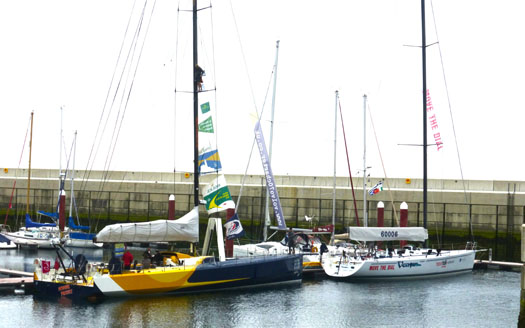
The exceptionally deep water in Greystones Marina provided trouble-free berthing for the Volvo 70 Monster Project and the Farr 60 Newstalk. Photo: W M Nixon
Perhaps after their attendance at the Round Ireland Dinner in Wicklow last Saturdaynight, Tanit's crew now have a better understanding of why the Round Ireland Race is in its present format. And I certainly understand why the level of close personal attention which goes into the race administration by the small team in Wicklow SC running it adds greatly to its appeal for dedicated participants. Before going to Wicklow, I'd been checking with the eternally obliging Sadie Phelan of the race team whether or not Richard Harris would be there, as I had to admit I thought his boat was only gorgeous. "Of course he'll be there" says Sadie, "and I'll put you at his table".
Not only that, but the winner Tanit's table and the runner-up Ruth's table were cheek by jowl, so much so that I was almost sitting at both of them. It would have taken a team of scribes to collate all the information flying back andforth, but everything was of interest.
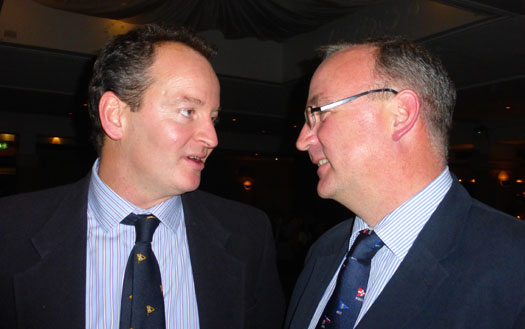
Just six minutes separated them at the end.....winner Richard Richard Harris of Tanit (left) and runner-up Liam Shanahan of Ruth at the Round Ireland prize-giving in Wicklow last Saturday night. Photo: W M Nixon
Richard (42) and his brother have owned Tanit for about twelve years, but as his brother is into gentler forms of sailing, the offshore campaigns are exclusively Richard's territory. In early sailing in the Clyde, they'd campaigned a Sweden 36 with their late father while Richard's own pet boat was a classic International OD. But as his interest in offshore racing grew, heidentified the Australian Murray Burns Dovell-designed Sydney 36 as ideal for their needs. He found there was only one in Europe, a 1996 one, little-used and in the Solent. They soon owned her, and changed her name to Tanit as the family firm is Clyde Leather, a vibrant firm which is the only suede tannery in Scotland.
Thus as raced in the Round Ireland, Tanit had the logo of Clyde Marine Leather on her topsides - a useful sideline is suede products for marine use, including a very nifty range of attractively-priced DIY kits for encasing your stainless-steel steering wheel in suede. Show me a boat which has a bare steel wheel, and I'll show you a boat which is on auto-pilot for an indecent amount of the time. But if you are doing the suede coat thing on your helm, be sure to cover the spokes as well, it makes all the difference for ultimate driver comfort.
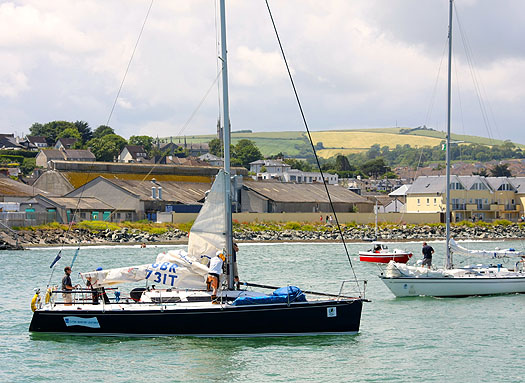
The boat from God knows where....Tanit (left) was an unknown quantity when she made her debut in Wicklow Harbour on the morning of the Round Ireland Race 2014, but father and son crew Derek & Conor Dillon's Dehler 34 Big Deal (right) from Foynes had already taken part in a couple of ISORA races, and went on to win the two-handed division and place 8th overall. Photo: Kevin Tracey
Gradually, they built up Tanit's campaigning in the Clyde, and most of the crew who currently race the boat have been together for seven years. They also chartered a boat to do the Hobart Race of 2008, but as Scottish offshore racing numbers declined, they decided to give it a whirl with the RORC fleets in the English Channel by moving Tanit down there. They found that the programme of concentrated doses of large-fleet intense offshore racing, all taking place at a venue two hours' flight from Glasgow, suited them very well – they could be totally domesticated when at home without the distraction of the boat being just half an hour's drive down the road.
The Sydney 36 of Tanit's type ceased production in 1997, the Sydney 36 you'll tend to come across now on Google is a new 1998 design. So when Tanit's rudder was wrecked after the 2011 Fastnet (a good race for them), it was something of a disaster as a replacement rudder could no longer be supplied off the shelf. It was even more of a disaster for the unfortunate woman who was driving her five-day-old Range Rover around the boatyard in Southampton where Tanit had been hoisted after returning from the Fastnet finish in Plymouth, for not only was her absurdly big shiny new vehicle severely damaged in somehow colliding with the rudder of the Scottish boat, but it turned out that an inevitably custom-built replacement would cost a cool 35K sterling for her insurance company, as that was one very special rudder.
It was a disaster all round, for by the time they'd identified a high tech builder of sufficient repute prepared to build the new rudder, they had missed most of the 2012 season. Then the 2013 Fastnet Race had too much reaching to suit them, as Tanit is at her best upwind and down. So with Richard's brother making louder noises about selling Tanit in order to suit his more sybaritic preferences afloat, the Round Ireland Race 2014 came up on the radar as being an opportunity for what might well be the last hurrah with a much-loved boat.
They needed a navigator, and preferably one with some experience of the Round Ireland course. Fortunately John Highcock of Saturn Sails in Largs, who regularly races with Tanit as one of those ace helmsmen who can seem to smooth the sea, had sailed with Richie Fearon and suggested him with the highest possible recommendation, so the Swilly man was brought on board.
The rest of the crew were complete round Ireland virgins, but they found the race suited their style and level of sailing very well indeed. In any Round Ireland Race, seasoned observers can usually identify beforehand the half dozen or so boats which will be serious contenders for the overall handicap prize, but which one actually wins will depend on the way the chips fall. But Tanit was something of an unknown, a wild card. Yet it wasn't very far into the race before it became clear that this was a good boat on top of her game, if things came right she'd the makings of a winner.

Tanit settling in after the start. The quicker they got south, the sooner they got back into the sunshine........
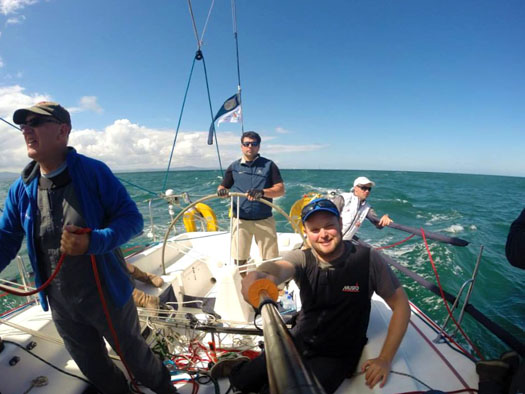
....and nearing the Tuskar Rock on the Saturday evening, they were back in sunshine, and well in contention on the leaderboard.
Within the limits of having a sensible boat which professionals would describe as a comfortable cruiser-racer, they campaign flat out. All meals are built around expeditionary and military Ration Packs, which can be quite expensive to buy in ordinary circumstances, but if you can show they're going to be used for a worthy objective, it's possible to swing a deal, and as Richard's wife Vicky is a physiotherapist who is involved with military reserves, the value of Tanit's campaigns is accepted in the right places. The result is a nourishing supply of reasonably attractive easy-prepare instant food which, as Richard reports still with some wonderment, makes no mess at all in and around the galley, yet keeps the crew on full power.
By the time they got up off the Donegal coast, Tanit was right in there, battling with the defending champion, the Gouy family's Ker 39 Inis Mor, for the overall handicap lead, while up ahead the two biggies, Teng Tools (Enda O'Coineen and Eamonn Crosbie) and the Volvo 70 Monster Project, with David Ryan of Wicklow, kept finding new calms as they tried to shake off the smaller craft.
It was a slow race, but Richie Fearon managed to place Tanit so that she stayed ahead of a calm up in his home waters, and was keeping station on Inis Mor very handily indeed, while the gap with boats astern widened all the time. Or so it seemed. But then the Round Ireland Race pulled one of its regular tricks, and Liam Shanahan and his team on the J/109 Ruth began to shift before they'd even got past Tory Island, and they appeared to carry a useful breeze and a fairtide the whole way from Donegal into the Irish Sea, or at least that's how it looked to the rest of the fleet.
But in closing in over the final stage from Rockabill to Wicklow, navigator Fearon – who was incubating a nasty virus which required antibiotic treatment for a week after the race - convinced Tanit's skipper that they should stay offshore, while Ruth – which seemed to have the race nicely in the bag – followed the Irish habit of hugging the coast. Inis Mor was already finished on Friday morning, but Tanit knew she was beatable by them, and when they came across the line at 1030, it was to move into the CT lead. And going offshore proved to have been their win move.
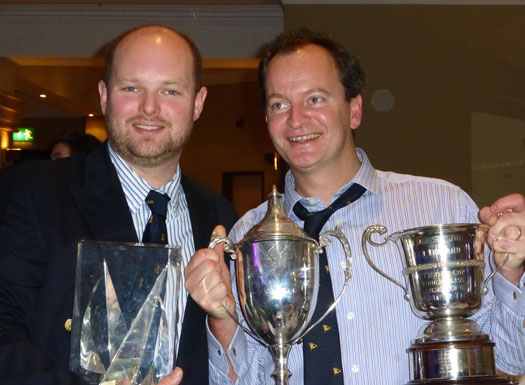
Trophies of the chase – crewman Chris Frize (left) and skipper Richard Harris with some of Tanit's prizes in Wicklow last Saturday night. Photo: W M Nixon
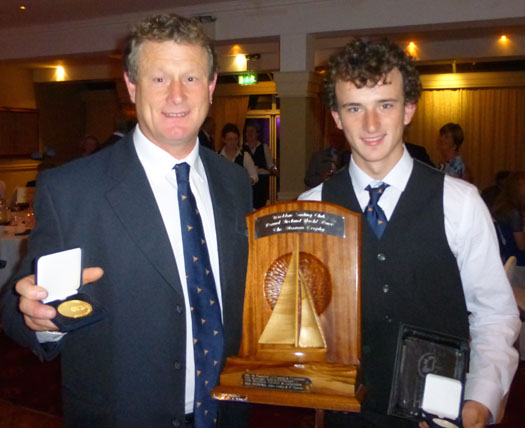
Family effort. Father and son team of Derek and Conor Dillon from Listowel in Kerry (they sail from Foynes) won the two-handed division with their Dehler 34 Big Deal, and placed 8th overall. Photo: W M Nixon
It was a time of screaming frustration for Ruth. She'd been crawling along near Bray Head, barely 15 miles from the finish, as long ago as 0700. She rated only 1.016 to the 1.051 of Tanit. A finish in the middle of lunchtime would do fine. It was so near. It was so far. Finally they got to Wicklow, but Tanit had them beaten by six minutes. Then for the Scottish boat there was just the chance that Ian Hickey's very low-rated veteran Granada 38 Cavatina might do it again. But the wind ran out for her too. Meanwhile Frank Doyle's Endgame came in at mid-afternoon to slot into fourth on CT behind Inis Mor, but Cavatina was fifth, all of five hours corrected astern of Tanit. The Scottish boat was now unbeatable leader.
Tanit's crew for this classic sailing of a true offshore classic was Richard Harris, Richie Fearon, John Highcock, Alan Macleod, Chris Frize, Andy Knowles and Ian Walker. They've a lovely boat of which they're justifiably very fond, but reality has intruded, and now she is indeed for sale. The price is 48K sterling which seems to me very reasonable when you remember that she is remarkably comfortable to sail, that sails and gear have been regularly up-dated, and that we know for certain that the rudder alone is worth 35K.......She's conveniently located for an Irish potential owner, as she's currently ashore in Glasgow. Certainly she has a performance weakness, for as Richard admits, she'll easily get up to 7 knots on a reach, but stubbornly stays there and goes no faster, yet if you harden on to the wind, she'll still be doing 7 knots. But if you go downwind, then whoosh – it's a horizon job on most other boats. Be careful what you wish for, though. With a boat like Tanit in an average fleet, there'll be no excuse for not doing well......
The rest of the trophy placings are here, and on Saturday night they were one lovely compact crowd of people. The family emphasis was inescapable, and it was a particular pleasure to meet the Kerry duo, father and son crew Derek and Conor Dillon from Listowel, who sail out of Foynes in their Dehler 34 Big Deal. In 2015, they plan to take on the two-handed division in the Fastnet, so getting 8th overall and winning the two-handed class in the Round Ireland 2014 was part of a very useful campaign trail.
Finally, as to how to keep the Round Ireland race's distinctive Wicklow flavour while allowing the entry numbers enough room to comfortably expand, it's such a tricky question that it will require a radical solution. A very radical solution. The mistakes of the Vikings must be undone. The Vartry entrance must be dredged, The bridges must all be removed. And the Broad Lough must be tastefully developed to give Wicklow the harbour it deserves, and the Wicklow Round Ireland Race the facilities it needs to cater for a fleet of a hundred and more boats. Simple, really.
ROUND IRELAND RACE TROPHY WINNERS 2014
Line Honours: Denis Doyle Cup - Monster Project (David Ryan, WSC)
IRC Class CK: CK Cup – Monster Project
IRC Class Z: Class Z Cup - Newstalk for Adrenalin (Joe McDonald, NYC)
IRC Class 1: Tuskar Cup – Inis Mor (Laurent Gouy, CBC)
IRC Class 2: Fastnet Cup – Tanit (R Harris, SYC)
IRC Class 3: Skelligs Cup – Ruth (L Shanahan, NYC)
IRC Class 4: Tory Island Cup – Cavatina (I Hickey, RCYC)
Class 5 (Cruiser HF) – Cavatina
Class 6 (pre 1987) Michael Jones Trophy – Cavatina
Class 7 (two-handed) Noonan Trophy – Big Deal (D & C Dillon, FYC)
ICRA Trophy (best Irish boat) - Ruth
Ladies Award: Mizen Head Trophy - Pyxis (Kirsteen Donaldson)
ISORA Award – Ruth
Team Award: Kinsale YC Cup – Endgame (F Doyle), Wild Spirit (P Jackson) & Fujitsu (D B Cattle).
IRC Overall: Norman Barry Trophy – Tanit
Round Ireland Overall: Wicklow Cup - Tanit

Monster boat, monster prizes. Line honours and Class C winner David Ryan of Wicklow, who raced the Volvo 70 Monster Project to success, with Roisin Scanlon, also WSC, who crewed on the Monster during the Round Ireland Race Photo: W M Nixon
#classicboat – In the summer of 2014, the RNLI in Crosshaven received an unexpected cheque from an unusual source. As ever with lifeboat fund-raising, it was very welcome. But it's not every day you get €1500 out of the blue from a high fashion magazine like Vogue Netherlands. W M Nixon unravels the tale of how this came about, and ponders the various challenges facing the enthusiasts who try to keep classic boats in full sailing commission.
Once upon a time, on a pure early summer day of clear sunshine in Connemara, the demands of the day job caused us to head up the driveway of one of the pleasantest country house hotels in all Connacht. But the bright mood of the morning was soon dispelled by finding the place full of bad tempered if beautiful people from Italy.
It turned out they were the complete creative team – photographers, models, directors, editors and all – from a leading Milan fashion magazine. They were in Ireland for a long-planned and lengthy photo-shoot of the coming season's trendy tweeds. They'd reckoned the Irish climate would guarantee they'd be up to their ears in ideal conditions to provide moody shots of even moodier models in ultra-fashionable tweeds on an extraordinarily moody bog with unbelievably moody Irish mountains beyond, the whole thing recorded under an uber-moody grey Irish sky.
But for day after day, the sun had shone from a cloudless sky, the breezes blew only very gently from a blue Atlantic, the fabulous range of the Twelve Bens could quite reasonably have been re-named the Twelve Benigns, while the great swathes of bog glowed in friendliness in the sun. Moodiness was out. All was sweetness and light. And the forecast was for more to come.
So after another day of screaming frustration, they upped and left, screeching that they could find more suitable conditions back home, just down the road in the Valley of the Po. Doubtless they could. But back in Connemara everyone simply relaxed and enjoyed it, for the Italians' bill had been paid in full, they maybe could even re-let some of the rooms in the hotel in the few days remaining of the booking, and sure wasn't the weather just wonderful anyway, and had we ever seen the garden looking so well?
If you think fashion people are out on a limb in relation to the rest of us, take time to reflect that for most of humanity, boat people are odd too. Even with the newest craft, we still think of them as living beings, whereas the rest of the world thinks that, regardless of their age, they're no more than vehicles, and uncomfortable, awkward, dangerous and expensive vehicles at that.
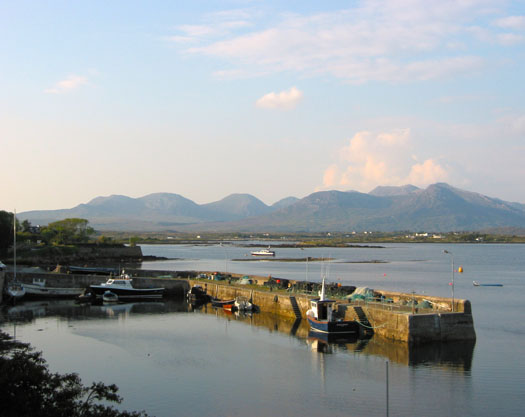
Roundstone in Connemara on a gentle day with a sublime view towards the Twelve Bens in the evening sunshine – totally unsuitable conditions for a mood-laden fashion shoot. Photo: W M Nixon
So when you get some sailing person whose pulse is quickened only by classic or traditional boats – anything unusual so long as it is full of character, and preferably old - then you get someone who scores a double negative with the ordinary run of boat-loathing humanity.
And though high fashion may be comprehensible to a larger proportion of mankind than is enthusiasm for old boats, nevertheless it too is still a rather peculiar or at least very specialist interest with which to dominate one's life.
Thus it's just possible that when high fashion and dedicated classic boat fans link up, an unexpected bond can be formed. Certainly it seems to have happened when Vogue Netherlands got together in Crosshaven during the summer for a photo-shoot with Darryl Hughes' superbly-restored 1937 Tyrrell-built 43ft ketch Maybird.
And the successful outcome of it all, with a useful cheque being presented to Crosshaven RNLI afterwards, was a reminder that while boat restoration projects can indeed be brought to a successful conclusion, once the job is done, you then have to move on to the next stage of finding imaginative and useful things for the boat to do, as there's nothing worse for the wellbeing of any boat than doing nothing.

After two good day's work afloat out of Crosshaven, a cheque for €1500 is handed over by Zoe Rosielle of Vogue Netherlands to Patsy Fegan, RNLI Deputy Launch Officer Crosshaven, with Shore Crewmember Robbie O'Riordan in support. Also in the picture are the rest of the Vogue Netherlands team, with three of Maybird's crew – Pat Barrett, Marie Keohane, and Darryl Hughes – top left, while fourth crewmember Joeleen Cronin took this photo
The story of Maybird has been told in snippets here before. She's a very near sister of the 16-ton ketch Aideen which was built by Jack Tyrrell of Arklow in 1934 for Billy Mooney, who in those days was Howth-based, but he later became a leading figure in Dun Laoghaire. Aideen was built to a Fred Shepherd design, but it's said that Shepherd had only been brought in to put manners on numerous very detailed drawings by Billy Mooney himself, including the layout – unusual at the time - of a centre cockpit.
Very conservatively rigged as a gaff ketch, Aideen was no slouch – she won her class in the 1947 Fastnet Race. Soon after, she was sold to Canada, where she was last heard of in 1974. Mooney claimed he'd to sell her because he could no longer afford to buy his crew dinner every time they won a race, and they were winning too often. That was a very Billy Mooney kind of remark, but certainly he almost immediately down-sized to the excellent little 6-ton John Kearney Bermudan yawl Evora of 1936 vintage, and with her he continued winning offshore until, with his retirement from work, he also swallowed the deep sea anchor and took up Dragon racing in Dublin Bay.
Meanwhile, during the mid 1930s an admirer of Aideen had been a keen sailing man originally from Cork, one W C W Hawkes, an officer in the Indian Army who commissioned Maybird, a near sister-ship of Aideen, from the Fred Shepherd-Jack Tyrrell team in 1937. Hawkes retired from India in the late 1930s to live in Restronguet on Falmouth Harbour in southwest England, but he was to have little enough use of Maybird with the intervention of World War II from 1939 to 1945, and his death in the late 1940s.

The first-born. Billy Mooney's Aideen was built by Tyrrell's of Arklow in 1934. Her younger sister Maybird, built in 1937, had a slightly longer canoe stern. Maybird's modern accommodation layout is also different, with the galley moved aft to the starboard side at the foot of the companionway
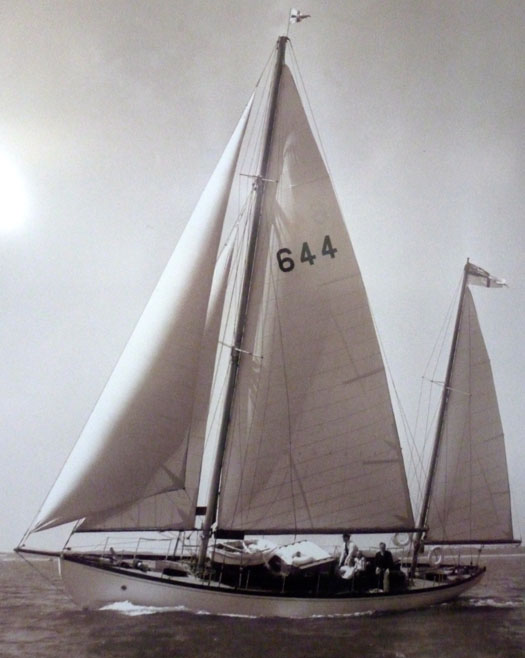
Maybird under her Bermudan rig in the late 1950s. Her restoration has included this rig's replacement by the original gaff configuration for the mainsail.
Subsequently, the 43ft ketch led a varied career, acquiring a Bermudan rig and an RORC rating for racing, and then in 1972 she was sailed out to New Zealand. Darryl Hughes came upon her there in 1990, and was smitten. Quite why some boats speak so eloquently to some people at certain times is sometimes difficult enough to understand, but the great project he has since completed with Maybird suggests that in this case it was the one very special boat for one very special person, and at just the right time.
He comes from a community in North Wales where there was no local tradition of industry or high-powered commerce, yet education at the local grammar school and a degree from Manchester University saw him moving into international companies, and by his thirties he was a rising star in general management in global organisations with a later emphasis on marine electronics.
This in turn fostered his interest in sailing, and he was learning the ropes with his own Nicholson 32 when a working spell in New Zealand led to his first sight of Maybird in the Bay of Islands. By 2007, with an early and well-funded retirement beckoning, he had her shipped back to England with a restoration in mind.
But the quotes he had for the job from established yards were horrendous, so he decided to do it himself as his own Project Manager. Sensibly, it was done in the heart of the English marine industry, where he could call on a diversity of talents to make progress with this project, which was soon well under way in Southampton in a temporary shed he'd created with tarps over a proper scaffolding structure.
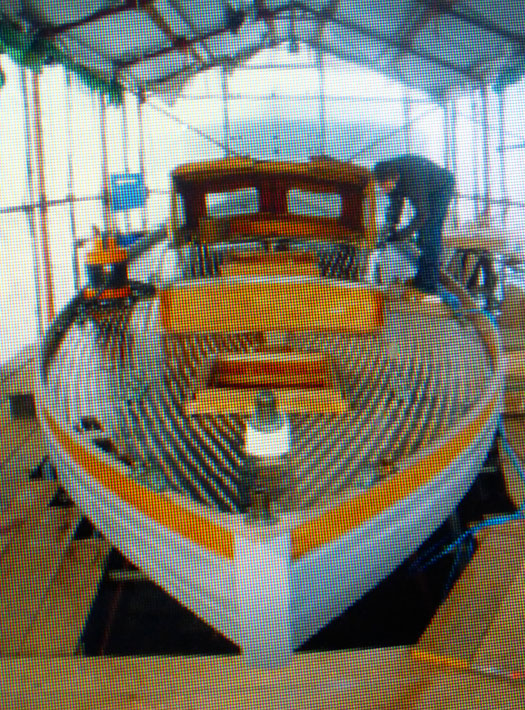
The owner-managed restoration project on Maybird under way in the temporary shed in Southampton. Photo: Darryl Hughes
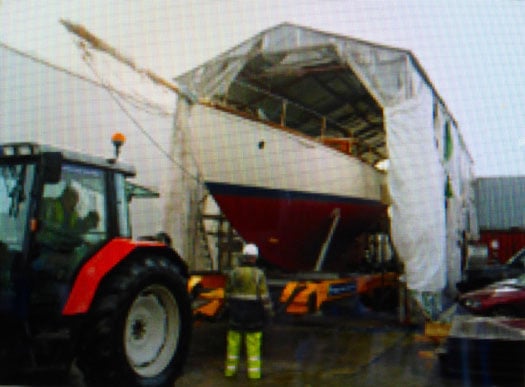
Mission accomplished – the restored Maybird emerges from the project workshop. Photo: Darryl Hughes
His long experience in international industry stood well to him, for the work went steadily ahead, and after two years the restored Maybird emerged as good as new, in fact better. And the project was completed for around a quarter of a million pounds sterling, about half of the most reasonable quote he'd received from the established yacht restoration yards.
For many people, such a restoration would be enough in itself, but Darryl Hughes showed his calibre by progressing on to keep Maybird as active as possible. She was raced in the classics in the 2011 Fastnet, and finished in a slightly better time than that recorded by Aideen in 1947. As well, she has been cruising extensively, sometimes on a semi-commercial charter basis, while also taking part in classic yacht regattas.
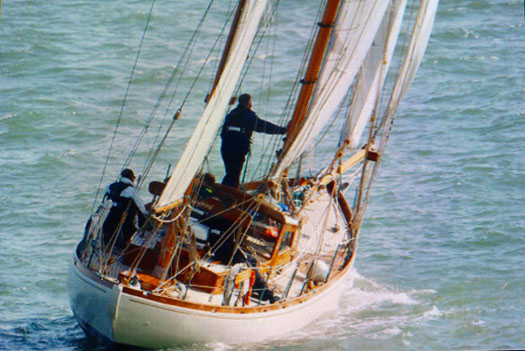
When it all becomes worthwhile. The restored Maybird sails again, re-rigged as a gaff ketch to the original design.......

.....and she turns in an encouraging performance, with a better time in the Fastnet Race of 2011 than Aideen had in the Fastnet of 1947.
An underlying theme has been his growing interest in Ireland and things Irish, thus he has based the boat for lengthy periods in Crosshaven while researching the history of the Hawkes family in Cork and in Cork Harbour sailing. But as well he has extensively cruised the Irish coast, and with his developing interest in literature he has twice taken a full part in the Yeats Summer School in Sligo in late July. The new pontoon just below the bridge in Sligo port might have been installed for Maybird's convenience, but Darryl Hughes is still the only person who is known to have sailed to the Yeats School as a matter of course.
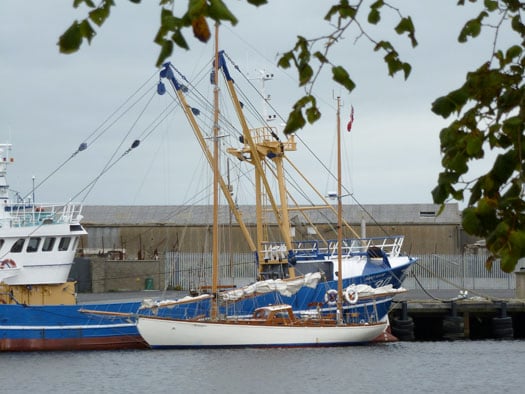
In 2011, Maybird returns to her birthplace of Arklow, where she was built in 1937. Photo: W M Nixon

Immaculate workmanship. The beautiful restoration of Maybird's deck and coachroof, seen in Arklow in 2011, contrasts with the rough and ready beer keg pressed into use to aid boarding. Photo: W M Nixon
Currently, Maybird is based in friendly Poolbeg Marina in Dublin Port, and her owner has spread his wings even further with a course of study in Trinity College, while living on the boat and pondering the production of the required 15,000-word dissertation on Irish writing. Last winter, however, was spent in the congenial surroundings of the Salve Marina in Crosshaven, and thanks to that there was the involvement with Vogue Netherlands – we let Darryl take up the story:
"Vogue Netherlands wanted to organise a fashion shoot in SW Ireland, and their location scout came across Maybird wintering at Crosshaven in Cork harbour back in February 2014. I agreed that they could use her as long as they made a contribution to the Crosshaven RNLI station, and the shoot took place in early June over two days.
The entire Vogue contingent consisted of eight people - three models, photographer, photographer's assistant, make-up/hair stylist, wardrobe assistant and overall fashion director, together with three huge suitcases of clothes for the models plus extra camera gear, lenses etc etc. To sail Maybird we had a crew of three plus myself, the other sailors being Pat Barrett, Marie Keohane, and Joeleen Cronin, the daughter of the house in Cronin's pub. As you can imagine, my major concern was the safety of all aboard as the majority were not sailors.
We met the day before onboard and worked out that Maybird's aft cabin would do as the changing area for the models and the huge suitcases were manhandled down the companionway and through the galley. The aft cabin was then transformed into a Vogue changing room/hairdresser's salon. The plethora of laptops, lenses and spare cameras plus the film banks – yes, film, not all that digital malarkey I'm pleased to say- were stowed in the saloon. The saloon became the studio, but we had access to all of Maybird's chart table and instruments if required. Fortunately, all of the chart-table electronics are duplicated in the doghouse, which also has the 15" plotter screen.
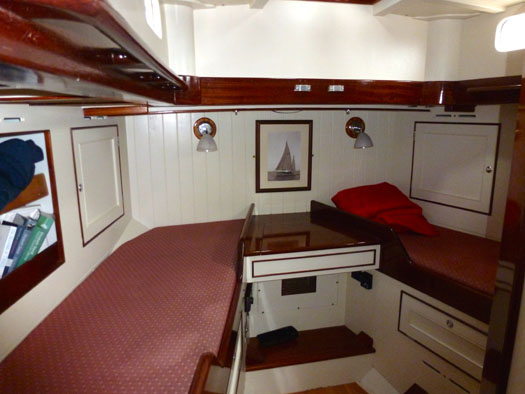
The aft cabin, luxurious by the standards of 1937, made for a rather cramped changing room/hairdressers salon during the Vogue Netherlands photoshoot. Photo: W M Nixon
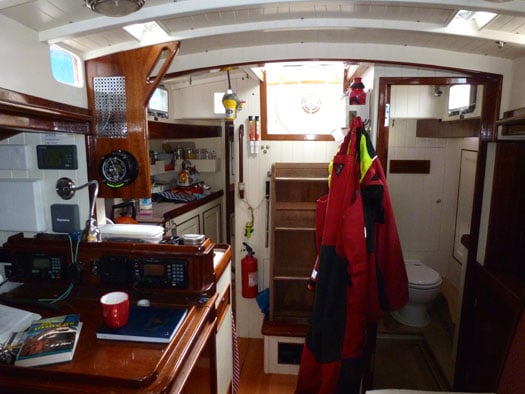
The galley and the chart-table together amidships at the foot of the companionway may seem a tight fit to modern sailors, but it would have seemed the height of comfort to cruising folk in the 1930s. Photo: W M Nixon
Once the stowage was sorted, we agreed that unless people were required on deck they stayed below. Everybody wore life-jackets and the only people that were allowed to take them off were the three models when the camera was rolling. Once the camera was silent the models donned their life-jackets again. We had a support RIB so that the cameraman could take pictures of Maybird sailing, so to an extent we had our own lifeboat with us, but my job was to keep all twelve "crew" on board.
We were blessed with gentle sailing conditions for the first day - wind max F3. The director wanted all Maybird's sails hoisted, and so we agreed set courses to sail. The crew set Maybird up, we chose courses that we could hold for as long a time as depth/traffic/hazards allowed, and then the photographer got to work with the models. We had an excellent rapport with the photographer, who understood that the skipper has the final say, and would stop shooting when we made the call "30 seconds to tack". Each of our legs or boards had to be agreed with the photographer in terms of where the sun was, the effect of shadows, background etc..
One of the models was starting to experience the early stages of sea-sickness as we approached the harbour entrance abeam of Roche's Point lighthouse, so we headed back inshore. Recovery was more or less instantaneous when back in flattish water.
Given the largely clement conditions we were out for some seven hours on the first day. But Day 2 was different. Wind was up to F5 gusting F6 and the sky overcast. The sea state was no longer smooth but more moderate to lumpy. I agreed with the director that we would go out, but we would not put up the mainsail - we would sail with jib, staysail and mizzen. I just wanted to keep things as simple as possible from a sail-handling viewpoint.
The cameraman wore his safety harness as well as his lifejacket as he was leaning over the bowsprit and over guardrails to take many of the shots that day, so I made sure he was clipped on. We agreed the models would not lean over the guardrails or do any poses that could lead to them falling off the boat. For this day, we were only on the water for some three hours.
Interestingly, the only pictures from Day 2 used were a black and white one with the female model standing on the foredeck. The sky really was nasty. No Photoshopping used there!
Despite Maybird's complexity in terms of numbers of sails and ropes, as she has a long keel she will sail on her own and hold her course when the sails are balanced so it was easy for her sailing crew to set her up and then crouch down out of the cameras way whilst the models did their stuff.
Both the photographer and his assistant were sailors back in the Netherlands, so that helped a great deal. The Maybird crew of four for one day, three on the other, really kept an eagle eye on the Vogue crew in terms of safety - that was the challenge, not sailing the boat. We tacked rather than gybed and as I say, when the wind did pick up, we sailed without the main - one of the great advantages of the ketch rig.
We managed to stay out of trouble, so our only dealings with the Crosshaven RNLI was to hand over a cheque to them".
That was only part of the good work done by Maybird in 2014. She was signed on to play a key role in an Irish Coastguard exercise in Dungarvan Bay later in the summer. Then once again the skipper's participation in the Yeats Summer School in Sligo resulted in a round Ireland cruise, with bits of Scotland thrown into the mix. And now she's a study centre in Dublin, helping to absorb the multi-facetted culture of our unique city. Truly, a busy ship is a happy ship.
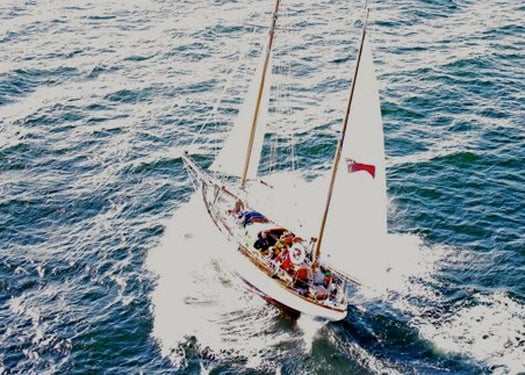
Maybird as seen from the S&R helicopter during an exercise in Dungarvan Bay. Photo courtesy Irish Coastguard.
Is The New Dublin Bay 24 The Best Way Forward For Old Classic Yachts?
#classicboat – The preservation of old boats can be a contentious issue, particularly so when the vessel is of significant historical interest at several levels, such as Erskine & Molly Childers' ketch Asgard. Technical and academic question arise as to when a refit become a major refurbishment, when does a preservation become a conservation, or when is a restoration veering into being a re-build? Alternatively, should you simply cut your losses and build from new, but using the original plans if the boat meant something very special to you and the larger maritime community? W M Nixon takes a look at three special boats of Irish interest which are currently at an important changes of course in their voyages through life.
Xanadu is no more. Espanola is seeking a new home. And Periwinkle is born again. And no, we're not launching into some imitation of the rolling cadences of Coleridge's Kubla Khan. On the contrary, we're just considering the current circumstances of three very different boats which have the shared factors of being at a significant juncture in their lives, and having strong links with Ireland.
My own first view of Xanadu was coming round the point at Courtmacsherry about a dozen years ago, and being much taken by a couple of big white raked masts vivid against the green West Cork background – clearly, it was an American ketch. Then close up, her handsome dark blue hull, with a delicately understated clipper bow, confirmed her Transatlantic appearance. And the elegant counter, with its raked and almost elliptical transom, reinforced this conclusion.
She was definitely of a type, and yet she seemed different. Something said that this classic yacht was neither a Francis Herreshoff nor a John Alden. Herreshoff was renowned for his large clipper-bowed Bermudan rigged ketches, of which the best known was the legendary Ticonderoga – "Big Ti". And though Alden was most famous for his schooners, he had shown he could turn his hand to classic ketches with raked masts and very positive clipper bows if that was what the client wanted.
But this striking yacht, newly making Courtmacsherry her home port just after the turn of the Millennium, didn't quite fill the Herreshoff-Alden bill. For sure, she had all the typical features. But they were in an elegantly under-stated style which gave her an almost mysterious air, and made you wonder just who might have been the designer, and when.
The story was pure gold. The 48ft Xanadu had been designed by the Argentine legend German Frers Senr, patriarch of a yacht design dynasty which is now well into its third generation. The origins of her hull above water was a sweet clipper-bowed ketch called Horizonte which old man Frers had designed for his own use in 1936, but one of his friends and customers liked the boat so much, and was prepared to pay even more to have her, that Frers never became her owner-skipper.

Argentinian designer German Frers designed the 48ft Horizonte for his own use in 1936, but she was snapped up by an enthusiast for his designs, so it wasn't until 1982 that he was able to build the boat as Xanadu for himself (though she too was to be snapped up), and this time she was given a different under-body, with long fin keel and centerboard, and skeg-hung rudder.

The 1936 hull profile for Horizonte.
In fact, it wasn't until 1982, and after owning several other boats of a more ocean-racing orientation to his own design, that Frers Senr had another look at the possibility of Horizonte for his dreamship. In re-sketching her, he retained the handsome above water profile. But as his son German Jnr was now cutting a mighty swathe through the international yacht design scene, with the 1981-built 51ft Moonduster for Denis Doyle of Cork only one of many hyper-successful boats at the front of the fleets, presumably the father took the son's advice on changing Horizonte's underwater profile to a long fin keel with centreboard, and a skeg hung rudder.

Xanadu as she was in June 2014 – the underwater hull profile is very reminiscent of the German Frers Jnr F&C 44 design. Photo: W M Nixon
Certainly the resulting underwater shape is almost exactly the same as the famous Frers performance cruising ketch, the Argentine-built F&C 44, of which Ireland has a fine example in Otto Glaser's Tritsch Tratsch IV at Howth. But the new Xanadu was slightly larger, like Horizonte 16.3 metres (48ft LOA), with a wider stern and more volume in every way – she was big for her size. And once again no sooner was building in progress in steel in Buenos Aires than someone else wanted her, and made an offer that couldn't be refused.
An early owner was a colourful character whose private life was such that the boat, at various stages of completion, seems to have been shifted back and forth across the River Plate between Argentina and Uruguay in order to keep her out of the clutches of a scorned wife who was in pursuit of her share of all the owner-skipper's assets. But eventually Xanadu, as she had evocatively become, found her way into American ownership and embarked on a very civilized 15-year voyage round the world, which she completed with style.
Norman Kean found her for sale in Annapolis. Very much a Scotsman and an enthusiastic member of the Clyde Cruising Club, his work as an industrial chemist had brought him to the DuPont plant in Derry, and for several years he was an active member of Lough Swilly YC at Fahan, starting with a Sadler 25 which he completed himself from a bare hull and deck, with which he undertook round Ireland cruises, the long haul south to Brittany, and a venture north to the Faroes. The latter won him an award from the Clyde Cruising Club, but with his new base he was soon also active in the Irish Cruising Club, and then he up-graded his boat size to a Sigma 33 for six years.
But with the DuPont plant at Maydown facing the closure of most of its operations, he took up an offer of a posting to the main American plant. And when that contract was in turn fulfilled, he took a look at another offer with the company in the late 1990s, but decided that it was time to take the alternative lump sum offer of money, and a new road in life. He and Geraldine had the vision of buying a suitable boat from among the thousands on offer at the US East Coast's three main "boat markets" of Newport RI, Annapolis and Fort Lauderdale, and sailing her back across the Atlantic to run an owner-skippered-charter operation in Southwest Ireland.
Their ideal was a 42-44ft ketch, but then they saw Xanadu in Annapolis, and were smitten. Certainly she was a bit tired, but tired in a well-cared-for way. With a successful charter business keeping them busy each summer, they would have the resources to bring her back to showroom condition over the winter. So they brought her back across the Atlantic, loving their fine big ship even more with every mile sailed, and set about going into business with a base at Courtmacsherry.
And they came up against the brick wall that is Ireland's Department of Transport. After years of struggle and ultimate failure, Norman now looks back on it all with a sort of ironic amusement. "There mustn't be a worse place than Ireland in the whole world to set up an one-boat owner-skippered-charter operation" he wryly observes. "They just don't get it, and they just don't want to get it. Obstructions and objections and prohibitions are put in your way at every turn. They just want you to go away, and leave them in peace to deal only with companies, and the bigger the better".
Certainly the cultural clash between the spirit of the Irish Public Service, in which the ideal is to rise without trace or trouble through the ranks until you reach a level with a highly desirable pension and the possibility of early retirement, is about as different from the Norman Kean approach to life as possible.
But being a man of much energy and vision, he was soon finding other outlets, and became the Honorary Editor of the Irish Cruising Club Sailing Directions, raising them to a new level. He and Geraldine made a formidable research and production team, and for several years, as the new rigorously up-dated editions appeared at remarkable speed, it was the handsome Xanadu which featured as the cruising yacht in the photos in the Directions, showing she had somehow found her way into obscure anchorages, many of them tiny places by comparison with her hefty size.

Xanadu on survey and research service for the ICC Directions at Inishvickillaune in the Blasket Islands. Photo: Geraldine Hennigan
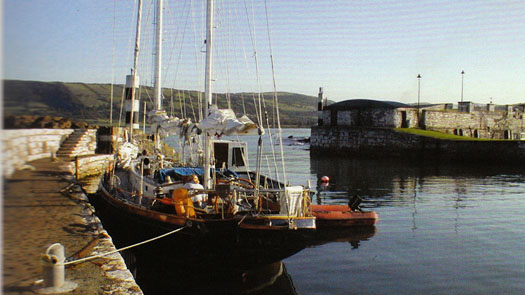
You wouldn't think you could get into a place as small as this, but research is everything....Xanadu in the tiny harbour of Carnlough on the Antrim coast. Photo: Geraldine Hennigan
But without the income of a skippered-charter operation, maintaining a steel ketch of this size and age was becoming impossible. In order not to be impossibly heavy, steel yachts have to be built with only 6mm plate, which is fine for strength but leaves nothing extra to allow for the local corrosion which is almost inevitable and difficult to detect when complex accommodation is fitted into hulls sprayed internally with insulation. Thus even with high level maintenance, it is reasonable to expect that a steel yacht will last only about fifty years without major work being undertaken.
With Xanadu, it was the more visible bits of the ship – the cockpit coamings and cabin sides, for instance, the places in the spray areas - which were most prone to rust. But there were also enough questionable spots, albeit minor, on the hull itself, hidden away by bulkheads, internal furniture and fittings and so forth, which were a cause for real concern. For as long as he could, Norman replaced or repaired the corroding areas, but it was a growing challenge – the ship seemed to be in rapid decline.
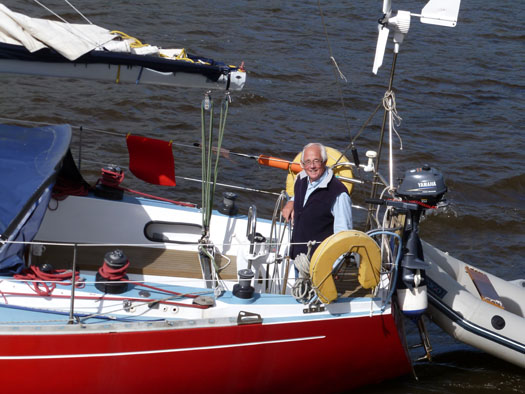
The surveying and research for the ICC Directions continued with boats loaned by members – Norman at work in Lough Foyle in 2013 aboard the 35ft Witchcraft provided by Ed Wheeler of Strangford Lough. Photo:W M Nixon
Xanadu was taken temporarily out of commission, but the ICC's research duties continued with boats loaned by members on all coasts of Ireland. Yet every time Norman and Geraldine returned from this absorbing work, they had to face again the problems with their own boat. It was decision time. They had to put Xanadu up for sale, ideally to someone who had the resources to refurbish a still eminently saveable classic. Or else they'd have to watch her rust away before their very eyes.
But the economic recession was in full swing. And selling a boat from remote Oldcourt Boatyard in far West Cork was a very different proposition from frequent showing to the boat-keen crowds who mill about places like Annapolis. The months passed, the years passed, there was interest, but there was nothing which converted into anything realistic. They made the decision that Xanadu was not going to make the 50 years which is the normal life-span of a fully-maintained steel yacht. Instead, she would end her days at the age of 32 while there was still a bit of dignity to it.
It's making the decision which is the really painful part. Once it's made, you're absorbed by the challenges faced in stripping a complex 48ft structure down to a shell, and selling the bits and pieces for sometimes surprisingly good prices, while keeping some special parts for possible incorporation in a new boat.

The last days of Xanadu. Seen here in June 2014, she'll be completely gone within a fortnight from today. Photo: W M Nixon
But as of this weekend, Xanadu is a bare shell, though still at home in the easygoing world of a friendly local boatyard. However, within a fortnight, this empty shell will be moved to the very different world of a scrapyard, and the final coup de grace will be delivered in a matter of hours.
In our modern world, in which such harsh events are kept hidden by professionals from sensitive eyes, we now and again need to reflect on the final reality. But despite Xanadu's fate, there are still many people who continue to preserve old boats for whatever reasons, and by very different means. So we'll round out this piece with the two very different stories of two historic boats which had very special links with Dun Laoghaire and Dublin Bay.
Espanola has sailed through this blog before. A 47ft cutter designed and built by Sam Bond at Birkenhead on the Mersey in 1902, she was originally called Irene VII, but in 1912 she was bought by Herbert Wright of the Royal Irish YC on Dublin Bay who'd been a founder owner in the Dublin Bay 21 class the year Irene was built. He actually cruised his DB 21 Estelle, which must have been an austere business, but certainly Irene seemed luxurious by comparison. And when the King of Spain visited the RIYC clubhouse during a formal visit to Ireland in 1912, as Irene on her moorings was the nearest boat to the clubhouse of any comfortable size, he was taken aboard her to see an Irish yacht, as he was himself a keen sailing man. Almost immediately, Herbert Wright - a fast-thinking stockbroker - re-named his new boat Espanola, and she has been Espanola ever since.
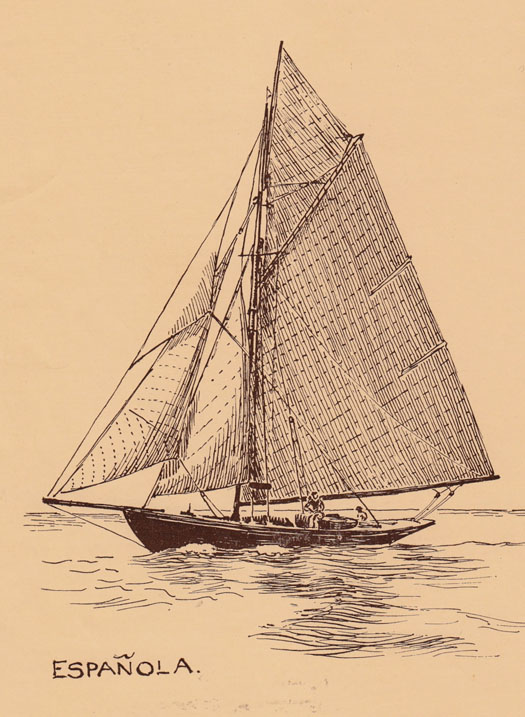
Espanola as she was in 1929. (from a drawing by Billy McBride)
In Herbert Wright's ownership, she made some notable cruises, indeed he was so highly regarded in the Irish cruising community that when the Irish Cruising Club was formed with a cruise-in-company of just five yachts to Glengarriff in 1929, Espanola was one of them, and she came back to Dun Laoghaire as the new ICC Commodore's yacht. It was a role she continued to fill for a dozen years, so it would be quite something of she was still around for the ICC's Centenary in 2029.
Since leaving Ireland in the 1940s, she has had a varied life, but for many years now, she has been owned by Martin Birch, a lecturer at Lancaster University. This means his home port is Preston on the Lancashire coast with, its huge tides and shallow channels. Espanola is very deep draft, so if you set out to choose an unsuitable home port for her, Preston would come well up the list, except that the folk in Preston Marina have adopted her as their sort of pet classic yacht, so Martin has had every assistance possible to keep his big boat in pristine condition.
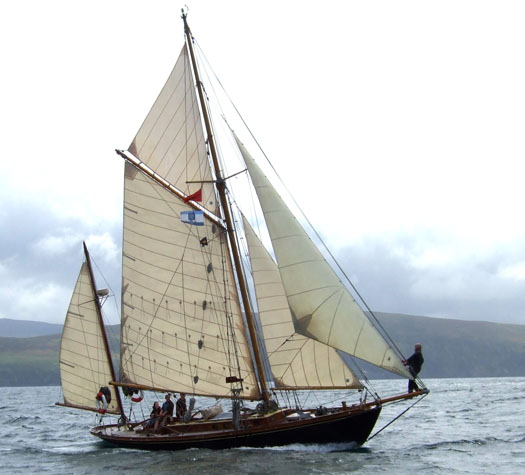
Espanola as she is rigged today, with a more manageable gaff ketch configuration.

Espanola is currently afloat under these high quality covers in Preston in Lancashire. Photo: Martin Birch
That said, when planks needed replaced she had to be taken to the Menai Straits and one of the boatyards there which are carving out a formidable reputation for quality work on classic and traditional craft. Getting Espanola to the Straits was no bother, as Martin has made some fine cruises with her, notably to the Outer Hebrides. So Espanola is in good shape for a boat of her age.
But after 25 years of total dedication in looking after this big vessel in challenging circumstances, Martin has decided it's time for a change, and Espanola is for sale. However, for someone looking for a flawless classic yacht pedigree, while her hull is totally authentic, Espanola's rig has now been changed from a big gaff cutter to an easily handled ketch, though still gaff rigged, while her accommodation has been made much more comfortable and roomy by the addition of an elegant full-length coachroof.
So today's Espanola is not totally as she was in 1902, but her full history has been traced by Martin Birch, and he has written a privately-published book about it which very effectively reveals why this is an important boat, though a challenge for any owner. However, if you're interested I'll put you in touch with him, but this isn't one for the faint-hearted.
But then, keeping any classic or historic vessel in seagoing shape is never something for the faint-hearted, so we'll conclude with a totally different approach to the methods adopted in the case of Xanadu and Espanola. It must be nearly ten years now since the six surviving Alfred Mylne-designed Dublin Bay 24s were spirited away to Brittany for a planned complete re-furbishment and their intended re-emergence as classic playthings for the mega-rich at a new resort centre to be built in the south of France.
The re-born class was to be known as the Royal Alfred 38s, as 24ft is only their waterline length, and people go by LOA these days. As to the Royal Alfred, it supposedly sounds more posh than Dublin Bay, and it was at a committee meeting of the Royal Alfred Yacht Club in Dublin in 1934 that Gordon Campbell, the second Lord Glenavy and owner of the Dublin Bay 21 Garavogue, first outlined the concept – and a very advanced concept it was too – for a larger more modern Bermudan-rigged one design for racing in Dublin Bay, and capable of some modest cruising.
By 1938, Dublin Bay Sailing Club took over the project, and a design was commissioned from Alfred Mylne in Glasgow. But though building work started in Scotland in 1939, World War II delayed everything, and the class didn't have their first race at Dun Laoghaire until 1947. They were an immediate success - they filled Gordon Campbell's brief to perfection, and for more than five decades they'd great racing in Dublin Bay, they also logged some truly remarkable cruises, and for good measure they did the business racing offshore, with one of them the overall winner of the RORC Irish Sea Race in 1963.
But the setup in Dun Laoghaire does not favour the continued existence of a class of 38ft classic wooden yachts, so the DB 24s had definitely run out of steam when they were swept up by the Royal Alfred 38 consortium. Then the recession arrived, and all sorts of rumours circulated about the boats being held as security against debts, of them being piled away any old how in a warehouse near Benodet in Brittany, and of lots of other things, none of them good news.
That is, until somewhere over a month ago, when I heard from an acquaintance with a Classic in the Balearics that he'd heard a rumour a restored Dublin Bay 24 had been seen sailing in the inner reaches of the Bay of Biscay, and seemed to be very much at home there. This I thought rather good news, as it seems to me to be a much more appropriate setting for these very special boats than the French Rivera with its harsh sun, where the classic yachts are so large that the Dublin Bay 24s, or whatever they were to be called, would be virtually invisible.

The new Dublin Bay 24 Periwinkle sailing off La Turballe, August 2014
For once, it's good news, albeit with a slightly sad tinge. The slightly sad note is that the Dublin Bay 24 Periwinkle, which never left her birthplace in Scotland and was only united permanently with her sisters when they were all shipped to Brittany several years ago, is now absolutely no more. Well, her tiller still exists and is in use, but whether that's the original tiller from 1948 is another matter. And her lead ballast keel still exists. But the rest of Perwinkle is totally gone, burnt to ashes. Yet Periwinkle still sails, and is looking very well indeed.......
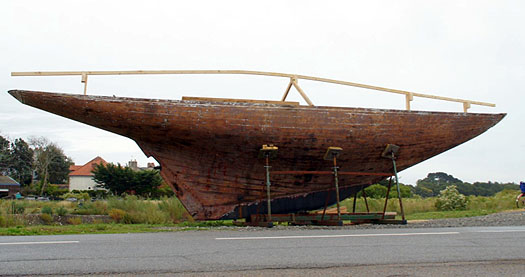
Last glimpse of the 1948 Periwinkle, September 2012
It's quite some story. In 2012, the original Perwinkle was bought by the Francois Vivier organization in France, which specializes in classic boat-building to the highest professional standards, and also creating designs – some of them distinctly quirky, and some which can be built by amateurs. The ideals behind it all have taken off in such a big way in France and abroad that there's an almost religious fervor to some of Vivier's adherents, and the story of Periwinkle will in no way diminish this.
For they took the original Periwinkle, and with a team of qualified shipwrights and trainees, they meticulously took her apart bit by bit in order to see how she had been built, and to give them the information to build an exact replica, albeit in different wood technologies such as the use of laminated frames.
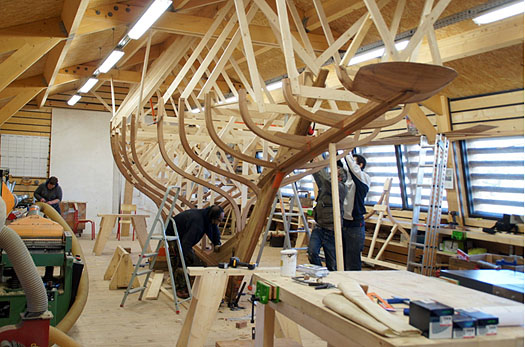
Perwinkle built anew – the laminated frames go into place
Looked at a certain way, it's all a bit morbid – we're in the surgeon's dissecting theatre here. And no, I don't know if they had an audience, but it's for sure they would have had no troubling assembling one. Then, with all the information to hand, and with every last little dismantled bit and piece for further confirmation, Francois Vivier drew out new plans for the re-construction. Periwinkle re-born took to the water in August this year, and she looks only gorgeous.
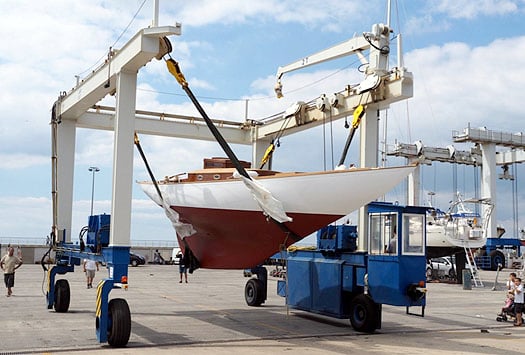
The new Periwinkle on her launching day – she'll be known as a Dublin Bay 24

With her teak decks looking immaculate, the new Perwinkle goes afloat for the first time.
You'll be glad to hear she's known as a Dublin Bay 24. And such is Francois Vivier's following, I wouldn't be at all surprised to hear of a new class in the making on France's Biscay coast. For with Gordon Campbell's vision, the further experienced input of the committees of both the Royal Alfred Yacht Club and Dublin Bay Sailing Club, and Alfred Mylne's genius, they got one marvellous yacht.
So there it is. The three choices with an important but ageing classic yacht. Euthanasia. Or the continued dogged preservation against all the odds. Or a complete re-build. Not easy, any of them.

No, you're not seeing things, this is undoubtedly a very new Dublin Bay 24. But it would be impossible to quantify how much she cost, as the entire dismantling and building project has been part of a larger training progamme.





































































